Inseego NVWE725 Dual-Band CDMA / EVDO Modem Card User Manual Card Utility
Novatel Wireless Inc Dual-Band CDMA / EVDO Modem Card Card Utility
Inseego >
Contents
User Manual Card Utility

Contents: Dell Mobile Broadband Card Utility User's Guide
DellTM Mobile Broadband Card Utility User's Guide
The information below is provided by the supplier of the referenced software without independent
verification by Dell and is subject to the restrictions and disclaimers noted below.
Introduction
Quick Start
Using the Dell Mobile Broadband Card Utility
SIM Card Information
Frequently Asked Questions
Troubleshooting
Safety Information
Technical Specifications
Glossary
Regulatory
Information in this document is subject to change without notice.
© 2007 Dell Inc. All rights reserved.
Trademarks and Service Marks
Microsoft® and Windows® are either registered trademarks or trademarks of Microsoft® Corporation in
the United States and/or other countries.
Dell and the DELL logo are trademarks of Dell Inc.
The names of actual companies and products mentioned in this help file may be the trademarks of their
respective owners.
Other trademarks and trade names may be used in this document to refer to either the entities claiming
the marks and names or their products. Dell Inc. disclaims any proprietary interest in trademarks and trade
names other than its own.
file:///C|/Work/NVTL/Phase3/PDFRequest/HTML_Guide_Cingular/DellMobileBroadbandCardUtility/index.htm (1 of 2)5/8/2007 1:03:25 AM

Contents: Dell Mobile Broadband Card Utility User's Guide
Restrictions and Disclaimers
The information contained in this document, including all instructions, cautions, and regulatory approvals
and certifications, is provided by the supplier and has not been independently verified or tested by Dell.
Dell cannot be responsible for damage caused as a result of either following or failing to follow these
instructions.
All statements or claims regarding the properties, capabilities, speeds or qualifications of the part
referenced in this document are made by the supplier and not by Dell. Dell specifically disclaims
knowledge of the accuracy, completeness or substantiation for any such statements. All questions or
comments relating to such statements or claims should be directed to the supplier.
Export Regulations
Customer acknowledges that these Products, which may include technology and software, are subject to
the customs and export control laws and regulations of the United States ("U.S.") and may also be subject
to the customs and export laws and regulations of the country in which the Products are manufactured and/
or received. Customer agrees to abide by those laws and regulations. Further, under U.S. law, the
Products may not be sold, leased or otherwise transferred to restricted end-users or to restricted
countries. In addition, the Products may not be sold, leased or otherwise transferred to, or utilized by an
end-user engaged in activities related to weapons of mass destruction, including without limitation,
activities related to the design, development, production or use of nuclear weapons, materials, or facilities,
missiles or the support of missile projects, and chemical or biological weapons.
Release date: March 2007
file:///C|/Work/NVTL/Phase3/PDFRequest/HTML_Guide_Cingular/DellMobileBroadbandCardUtility/index.htm (2 of 2)5/8/2007 1:03:25 AM

Introduction: Dell Mobile Broadband Card Utility User's Guide
Back to Contents Page
Introduction: DellTM Mobile Broadband Card Utility User's Guide
Overview
Features
Overview
Congratulations on purchasing a Dell notebook with mobile broadband connectivity.
Mobile broadband provides high-speed connectivity via public carrier cellular networks. The Dell Mobile
Broadband Card Utility is a family of broadband connectivity applications that give you the freedom to
quickly download complex files and large email attachments, as well as access your mission-critical data
and applications when and where you need them the most—from anywhere within your service carrier's
coverage area.
Mobile broadband gives you the power to stay productive, responsive, and connected while on the go,
right from your Dell notebook. In order to take advantage of the benefits that mobile broadband can offer,
you must first activate service on your mobile broadband card on your chosen cellular provider's network.
Dell makes it easy to activate service—if you haven't yet activated your card, click here for more
information and instructions on how to get started.
Features
The Dell Mobile Broadband Card Utility includes the following features:
● Create and configure your mobile broadband connection profile
● Log number of connections, connection duration, and amount of data sent and received (Note that
usage data is for informational purposes only and can not be used to verify usage data with your
service provider)
● SMS (Short Message Service) text messaging – send and receive short text messages to and from
mobile phones (Check with your service provider for inclusion of this feature in your service plan)
● Email capability – send and receive email and attachments using your preferred email client
● Mobile Broadband Card diagnostics
● GPS capability – to determine if your system supports GPS, click here.
● Advanced features
file:///C|/Work/NVTL/Phase3/PDFRequest/HTML_Guide_Cingular/DellMobileBroadbandCardUtility/intro.htm (1 of 2)5/8/2007 1:03:25 AM

Quick Start: Dell Mobile Broadband Card Utility User's Guide
Back to Contents Page
Quick Start: DellTM Mobile Broadband Card Utility User's Guide
If the Dell Mobile Broadband Card Utility software was not pre-installed by Dell (generally the case if the Dell Wireless 5520
Mobile Broadband 3G HSDPA Mini-Card was purchased separately), then click here for instructions on how to install the
Dell Mobile Broadband Card Utility software.
Step 1: Launching the Dell Mobile Broadband Card Utility
Step 2: Activating the Dell Broadband Card
Step 3: Connecting to the Network
NOTE: Your Dell Mobile Broadband Card is pre-configured by Dell and ready to connect once the steps below
are completed.
That's it! Once setup is completed, you can connect to the Internet immediately.
Step 1: Launching the Dell Mobile Broadband Card Utility
The Dell Mobile Broadband Card Utility can be launched from the Windows Start menu or the Windows system tray by
following the directions below.
From the Windows Start menu, select All Programs > Dell Wireless > Dell Mobile Broadband.
From the Windows system tray, click in the system tray as shown below:
Top of Page
Step 2: Activating the Dell Mobile Broadband Card
Before you can connect to the network with your Dell Mobile Broadband Card, you must have an activated SIM card. You
can do this by following the steps below or by calling Dell's toll-free activation service at 1-800-228-6303.
1. Launch the Dell Mobile Broadband Card Utility.
2. If the Dell Mobile Broadband Card is not activated, the following Activation screen will appear within 2 minutes. To
open the Activation screen immediately, select Activation from the File menu.
file:///C|/Work/NVTL/Phase3/PDFRequest/HTML_Guide_Cingular/DellMobileBroadbandCardUtility/quick.htm (1 of 3)5/8/2007 1:03:26 AM
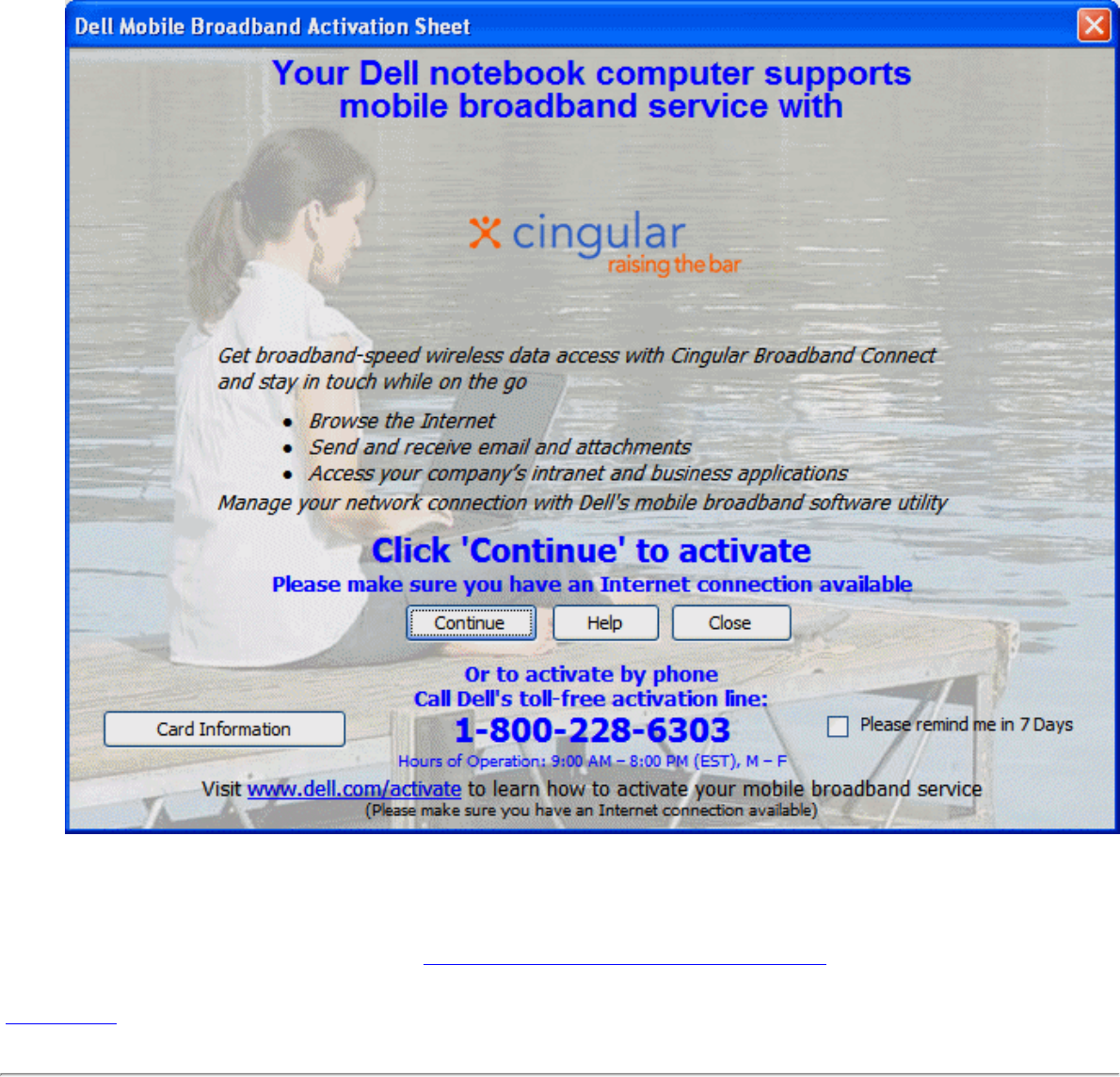
Quick Start: Dell Mobile Broadband Card Utility User's Guide
3. Follow the onscreen instructions to activate your SIM card.
After you activate your SIM card, you are ready to access the Mobile Broadband network with your mobile broadband card.
For more information, follow the instructions in Using the Dell Mobile Broadband Card Utility.
Top of Page
Step 3: Connecting to the Network
Connecting to the Internet is as simple as clicking the Connect button as seen below.
file:///C|/Work/NVTL/Phase3/PDFRequest/HTML_Guide_Cingular/DellMobileBroadbandCardUtility/quick.htm (2 of 3)5/8/2007 1:03:26 AM
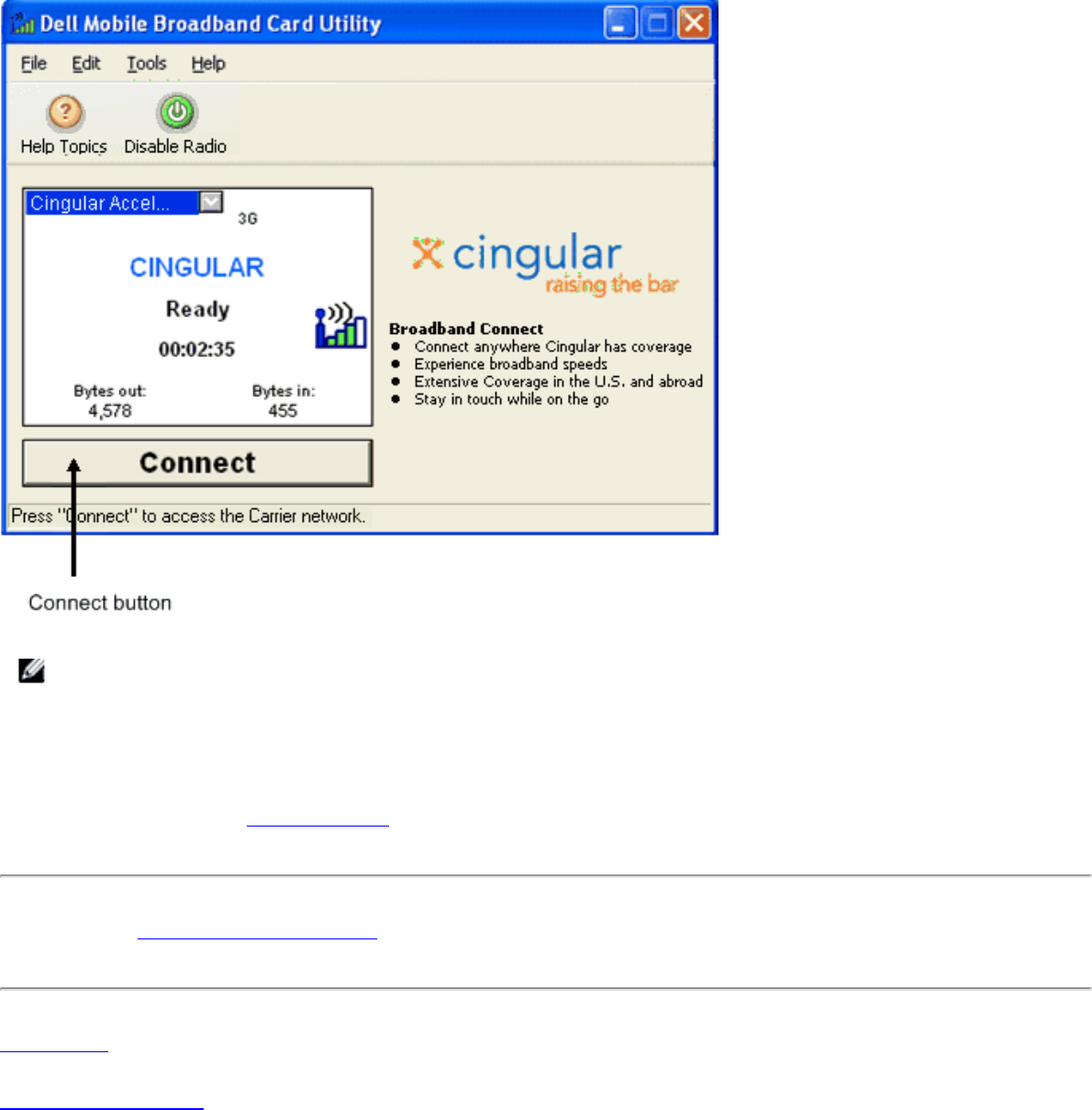
Quick Start: Dell Mobile Broadband Card Utility User's Guide
NOTE: Check with your service provider to ensure you are in a coverage area before connecting.
Once connected, the Connect button changes to Disconnect. Click the button to end your connection.
If your connection fails, see Troubleshooting.
Please read all restrictions and disclaimers.
Top of Page
Back to Contents Page
file:///C|/Work/NVTL/Phase3/PDFRequest/HTML_Guide_Cingular/DellMobileBroadbandCardUtility/quick.htm (3 of 3)5/8/2007 1:03:26 AM
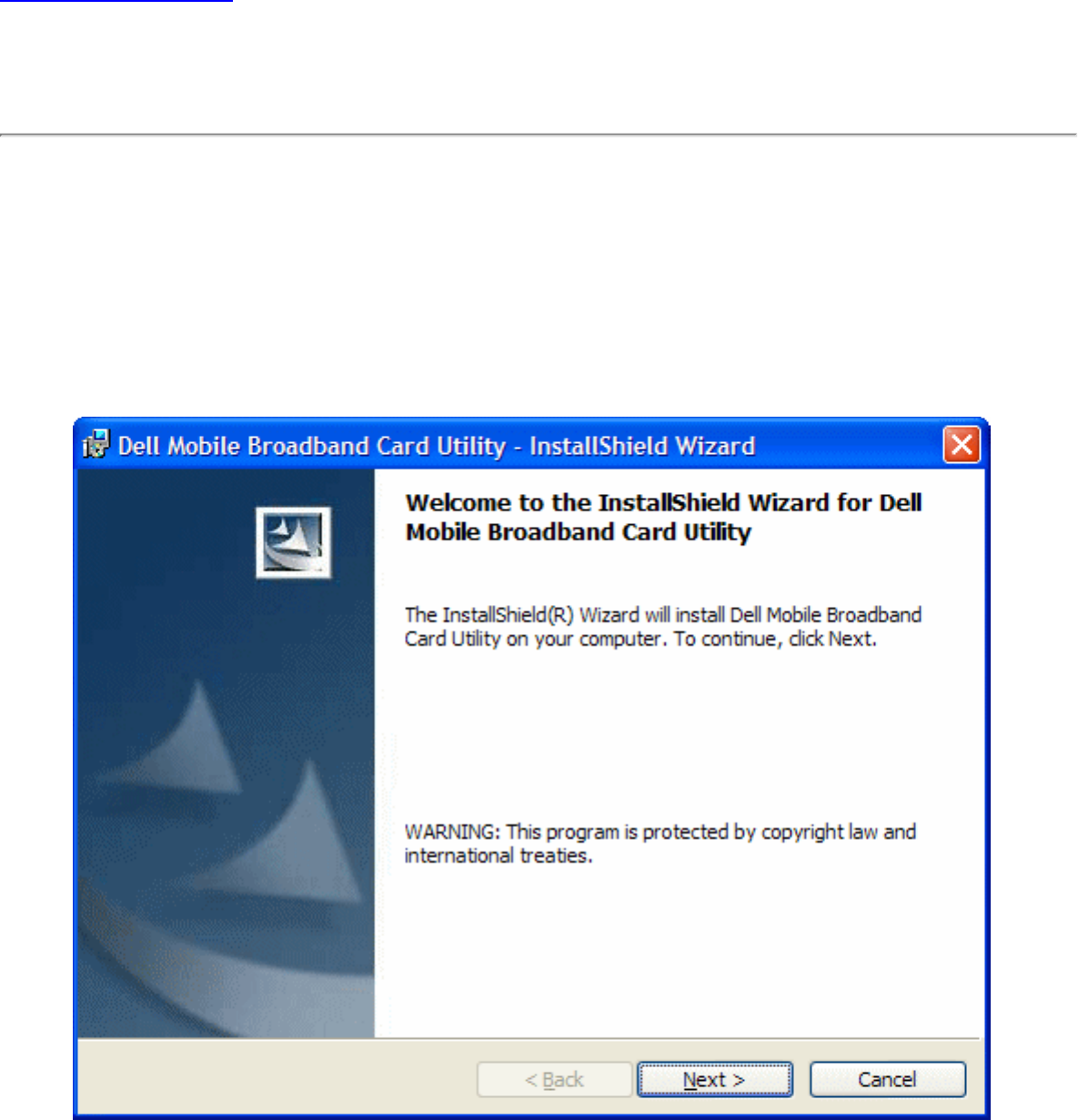
Installation: Dell Mobile Broadband Card Utility User's Guide
Back to Contents Page
Installation: DellTM Mobile Broadband Card Utility User's Guide
If the Dell Mobile Broadband Card Utility software was not pre-installed by Dell (generally the case if the
Dell Mobile Broadband 5520 Card was purchased separately), then follow the installation instructions,
listed below, to install the Dell Mobile Broadband Card Utility software.
1. Insert the Dell Mobile Broadband Card Utility CD into your notebook computer. The install program
presents you with the Welcome to the InstallShield Wizard for Dell Mobile Broadband Card Utility
screen.
2. Click Next. The Ready to Install the Program screen appears.
file:///C|/Work/NVTL/Phase3/PDFRequest/HTML_Guide_Cingular/DellMobileBroadbandCardUtility/install.htm (1 of 4)5/8/2007 1:03:27 AM
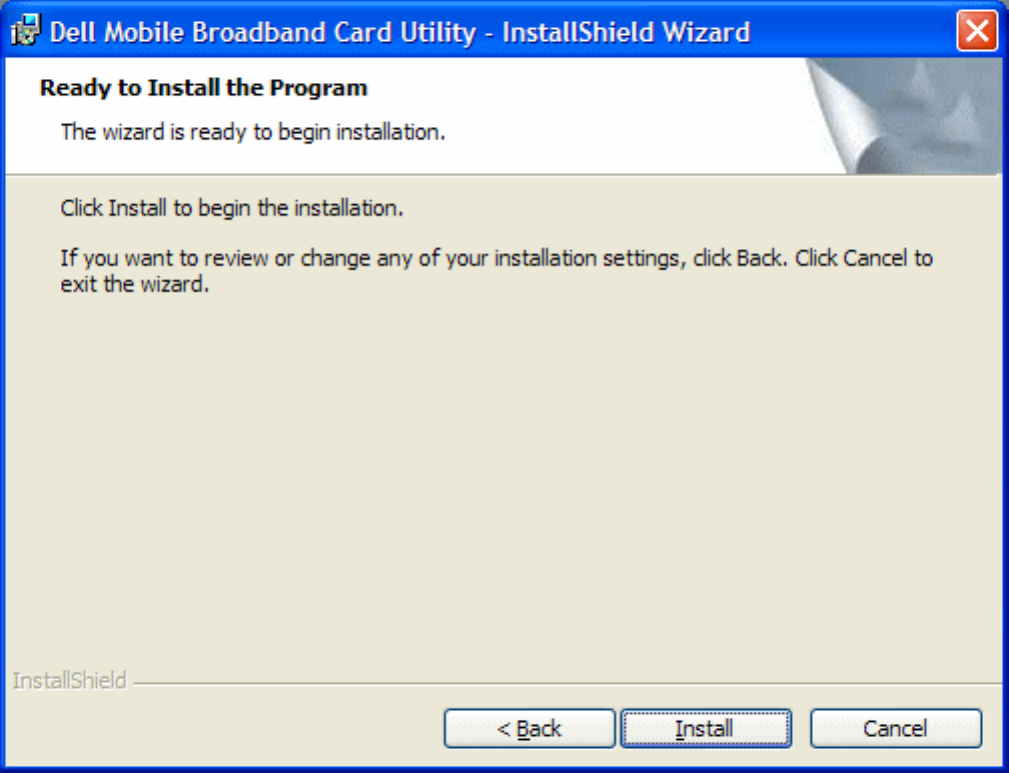
Installation: Dell Mobile Broadband Card Utility User's Guide
3. In the Ready to the Install the Program screen, click Install. As the program is installed, the
Installing Dell Mobile Broadband Card Utility screen shows the installation progress.
file:///C|/Work/NVTL/Phase3/PDFRequest/HTML_Guide_Cingular/DellMobileBroadbandCardUtility/install.htm (2 of 4)5/8/2007 1:03:27 AM
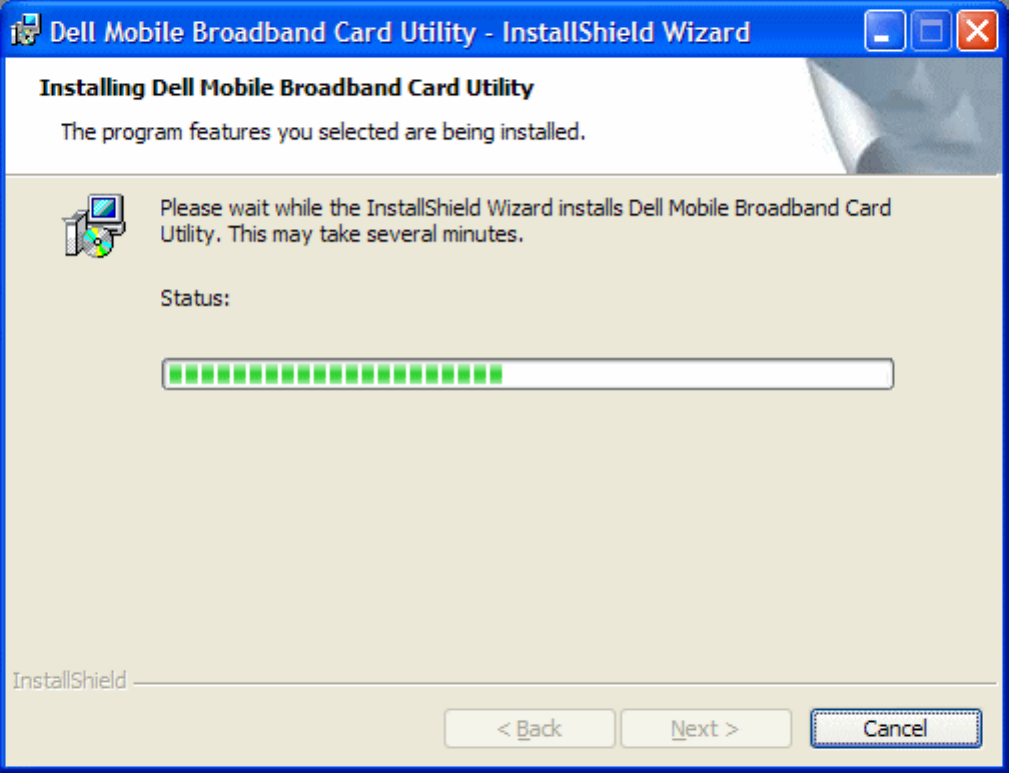
Installation: Dell Mobile Broadband Card Utility User's Guide
When the installation completes, the InstallShield Wizard Completed screen appears.
file:///C|/Work/NVTL/Phase3/PDFRequest/HTML_Guide_Cingular/DellMobileBroadbandCardUtility/install.htm (3 of 4)5/8/2007 1:03:27 AM
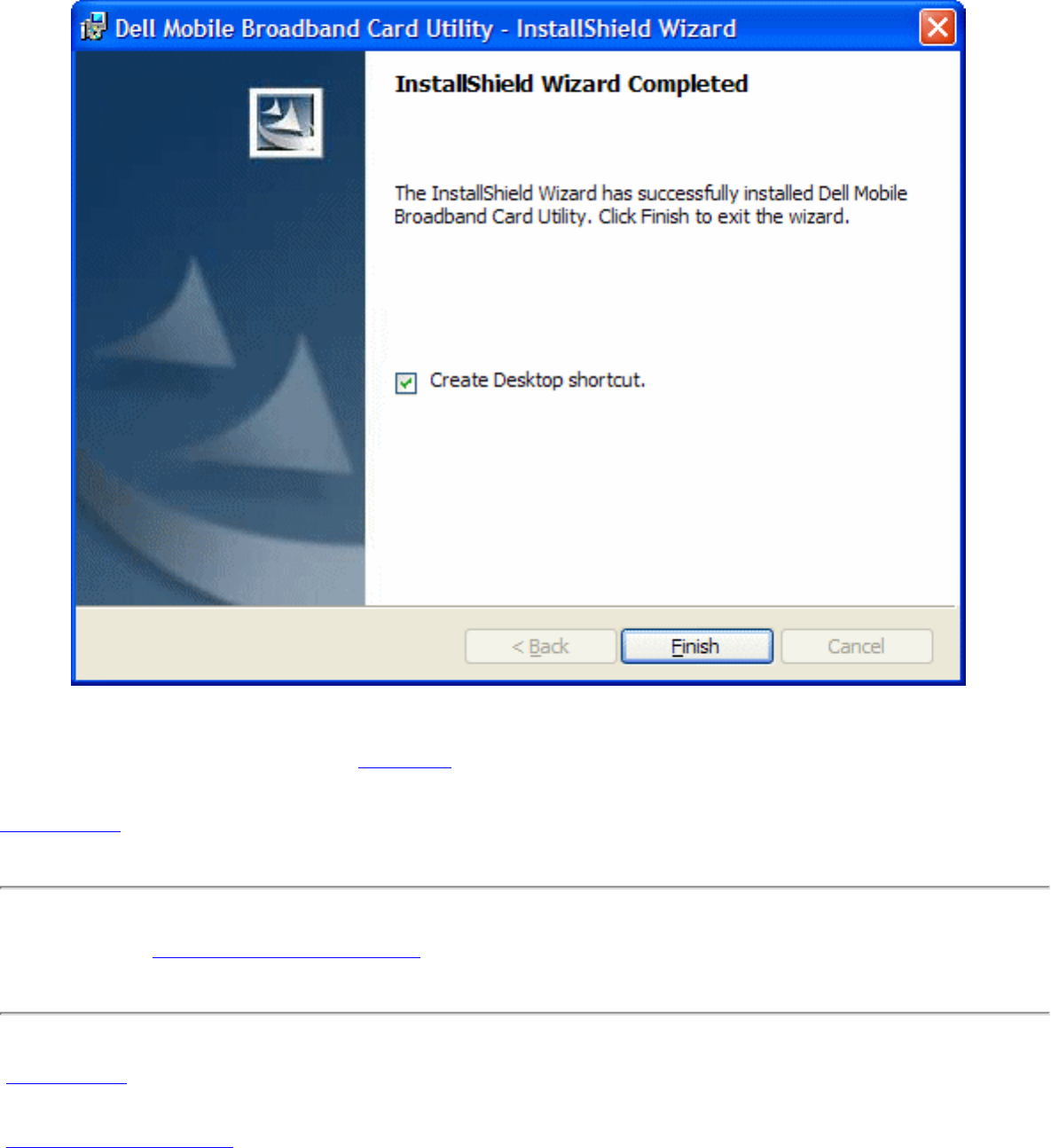
Installation: Dell Mobile Broadband Card Utility User's Guide
4. In the InstallShield Wizard Completed screen, click Finish. For instructions on launching the
utility and getting connected, click here.
Top of Page
Please read all restrictions and disclaimers.
Top of Page
Back to Contents Page
file:///C|/Work/NVTL/Phase3/PDFRequest/HTML_Guide_Cingular/DellMobileBroadbandCardUtility/install.htm (4 of 4)5/8/2007 1:03:27 AM

Using Dell Mobile Broadband Card Utility: Dell Mobile Broadband Card Utility User's Guide
Back to Contents Page
Using the DellTM Mobile Broadband Card Utility: Dell Mobile
Broadband Card Utility User's Guide
The Dell Mobile Broadband Card Utility and your mobile broadband card allow you to easily connect to the
wireless Internet from your notebook computer. It provides easy-to-use applications for creating
connection profiles, sending and receiving SMS messages, and diagnosing connection problems.
Getting Around the Utility
Connecting
SMS Text Messaging
Advanced Settings
Please read all restrictions and disclaimers.
Back to Contents Page
file:///C|/Work/NVTL/Phase3/PDFRequest/HTML_Guide_Cingular/DellMobileBroadbandCardUtility/usage.htm5/8/2007 1:03:27 AM
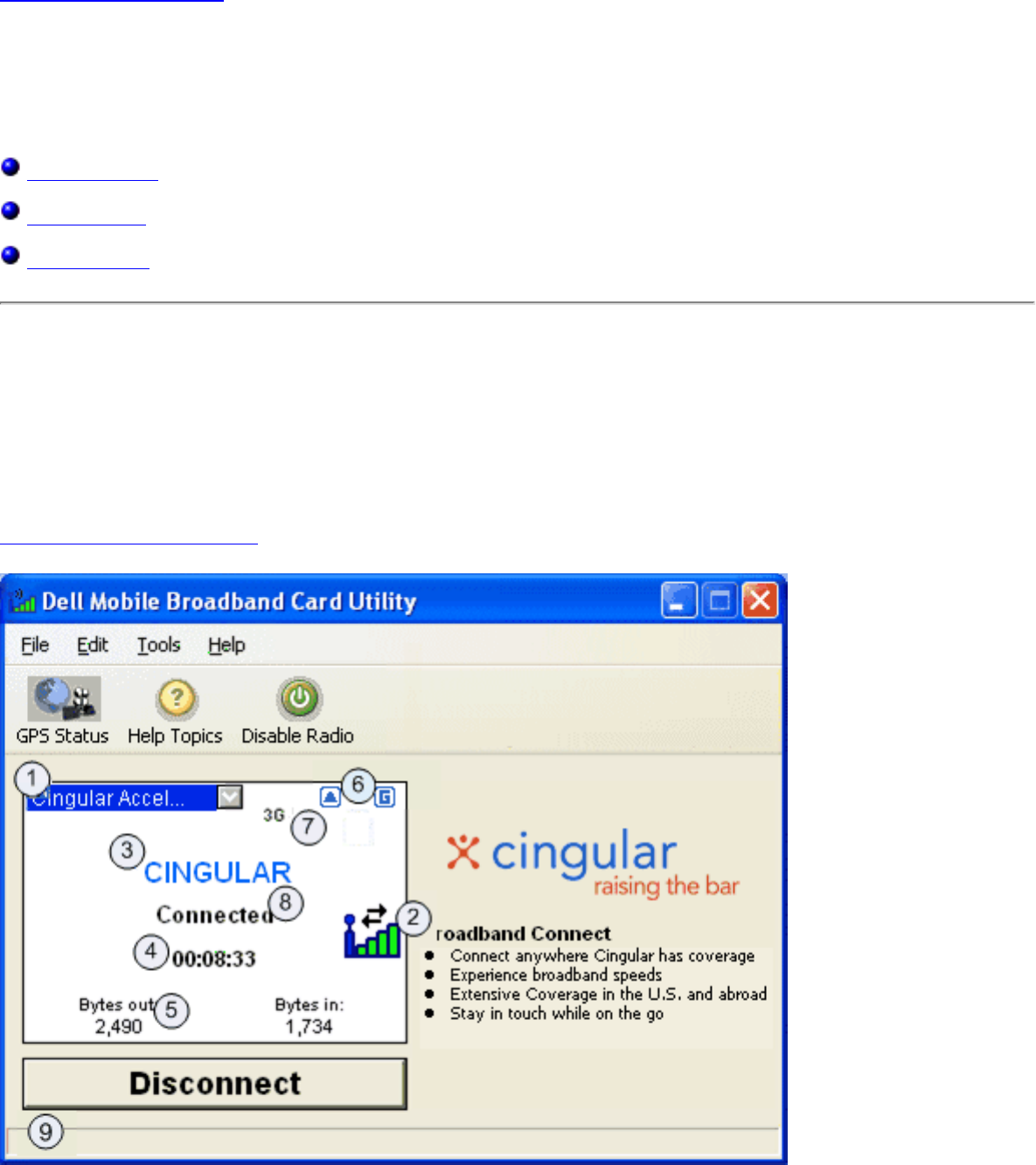
Getting Around the Utility: Dell Mobile Broadband Card Utility User's Guide
Back to Contents Page
Getting Around the Utility: DellTM Mobile Broadband Card Utility
User's Guide
Main Window
Status Pane
System Tray
Main Window
The Dell Mobile Broadband Card Utility will open with the main window by default. This view is where you
manage your broadband connections. The main window displays the network connections available. In
addition, the Main Window displays strength of your mobile broadband connection, your current
connection state, elapsed time of the connection and the connection status. For more information, see
Connecting to the Network.
file:///C|/Work/NVTL/Phase3/PDFRequest/HTML_Guide_Cingular/DellMobileBroadbandCardUtility/gettings.htm (1 of 6)5/8/2007 1:03:28 AM
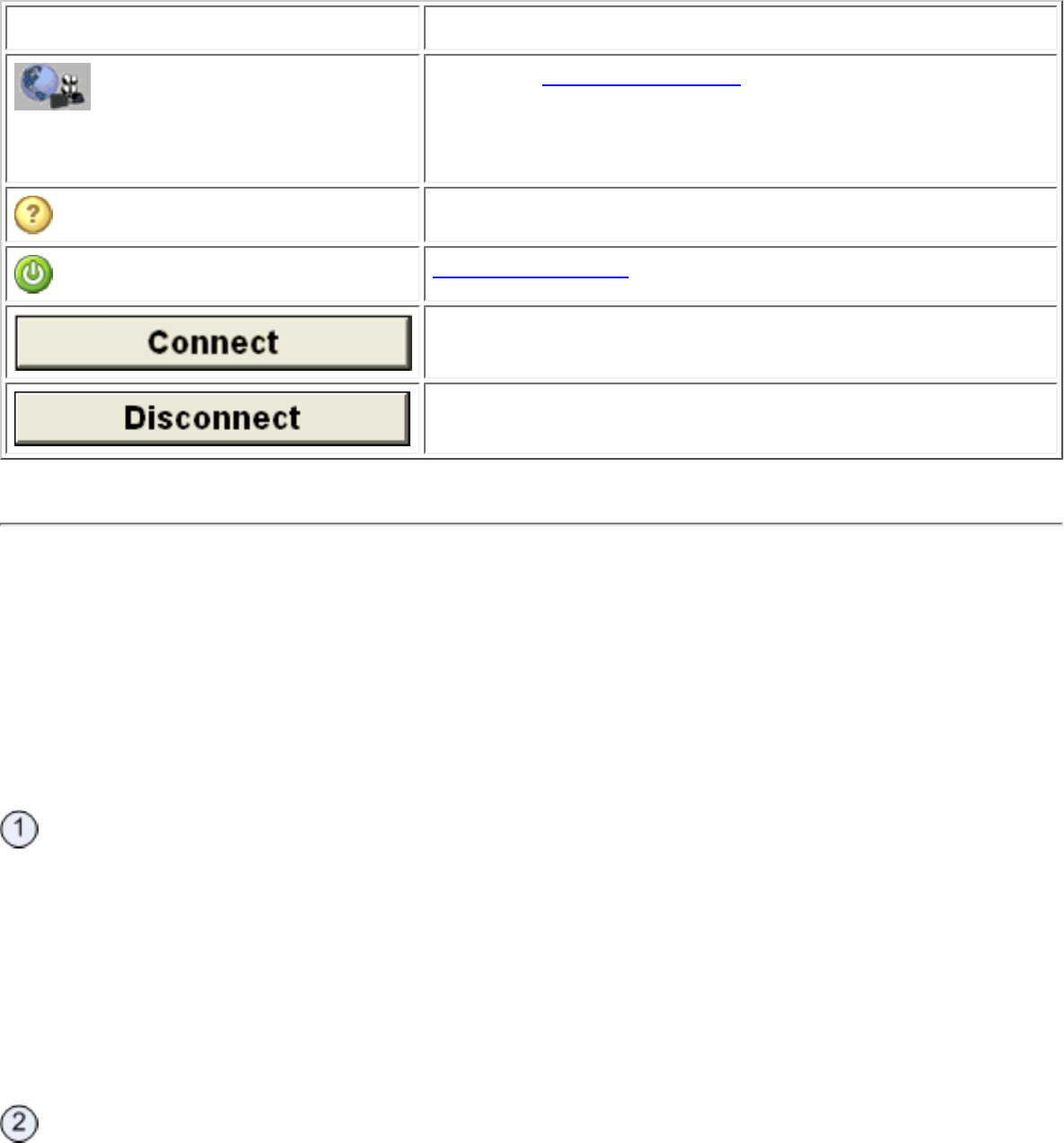
Getting Around the Utility: Dell Mobile Broadband Card Utility User's Guide
The Main Window buttons allow you to connect to the network and access additional Dell Mobile
Broadband Card Utility applications and features.
Button Description
Opens the GPS Status window. GPS is available only on
supported systems. The Dell Mobile Broadband Card Utility
determines whether your system is supported during
installation.
Opens the online help.
Enables or disables the Dell Mobile Broadband Card.
Connects you to the network.
Disconnects you from the network.
Status Pane
Information regarding your current network connection can be seen in the Status pane in the middle of the
Dell Mobile Broadband Card Utility main window. Status information is displayed during the connection
process as well as while connected. When not connected, the status text in the lower left corner will
display "Not connected" for the currently selected network. The timer will display "00:00:00". Once
connected, the status text will display "Connected" and the elapsed timer will begin to run.
Profile Selector
Displays your service provider’s profile, which includes information required to connect to the network. The
default profile is preset and locked.
Main Window Status Indicators
The Main Window status indicators provide information about the current network connection.
Signal Bar
Indicates the quality of the broadband connection. A weak signal may result in reduced data speeds or the
inability to connect. To improve the signal quality, try changing the orientation or position of your computer.
file:///C|/Work/NVTL/Phase3/PDFRequest/HTML_Guide_Cingular/DellMobileBroadbandCardUtility/gettings.htm (2 of 6)5/8/2007 1:03:28 AM

Getting Around the Utility: Dell Mobile Broadband Card Utility User's Guide
Service Provider Name
Displays the name of the currently connected service provider.
Connection Duration
Displays the number of hours, minutes, and seconds the current connection has been active.
Bytes Out/Bytes In
Displays the number of bytes received by and sent from your computer during the current session. This is
not related to your service provider's billing information.
Status Icon Display
Indicates the following:
Roaming: The device is roaming away from the home network. Additional charges may apply for
connections.
Locked: The device is locked. When in this state, connection is disabled.
SMS: A new SMS text message has been received.
GPS: GPS is enabled.
Mobile Broadband Technology
The Mobile Broadband Technology Display indicates which of the following mobile broadband
technologies are used for the current connection.
Technology Description
GPRS General Packet Radio Service. GPRS is a packet-based broadband service with
download speeds up to 86kbps. GPRS is considered an evolutionary step to more
advanced technologies such as EDGE and WCDMA.
EDGE Enhanced Data GSM Environment OR Enhanced Data for Global Evolution. EDGE
is an enhanced version of GPRS that enables the delivery of multimedia and other
broadband applications to mobile devices. It is designed to deliver data downloads
at rates up to 237kbps and is considered an evolutionary step to 3G/UMTS.
WCDMA Wideband Code Division Multiple Access. Based on the GSM technology evolution
roadmap, WCDMA supports upload and download speeds up to 384kbps.
file:///C|/Work/NVTL/Phase3/PDFRequest/HTML_Guide_Cingular/DellMobileBroadbandCardUtility/gettings.htm (3 of 6)5/8/2007 1:03:28 AM

Getting Around the Utility: Dell Mobile Broadband Card Utility User's Guide
HSDPA High Speed Downlink Packet Access. HSDPA is an enhanced version of WCDMA
that supports wireless broadband connection with download speeds up to 3.6 Mbps
This enhanced 3G technology quickly enables download high-bandwidth multimedia
files, high resolution graphics and other complex files, and view email attachments
at broadband-like speeds.
Mobile Broadband Card State
Mobile broadband card State messages appear in the main window and indicate the current state of the
mobile broadband card. For example, when the mobile broadband card is ready to connect, the "Ready"
message is displayed. When you are connected, the "Connected" message is displayed. The following
lists the possible messages and a description of each:
Mobile
Broadband
Card State
Description
Activation in
Progress... The mobile broadband card is being activated.
Initializing Card The mobile broadband card is initializing.
Ready The mobile broadband card is ready to connect.
Connecting... The mobile broadband card is connecting to the network.
Authenticating... Your ISP is authenticating your username and password.
Connected The mobile broadband card is connected to the network.
Disconnecting The mobile broadband card is disconnecting from the network.
Disconnected The mobile broadband card is disconnected from the network.
No Card
Detected The mobile broadband card is disabled.
SIM Not
Activated The SIM card is not activated.
SIM Not Found The SIM card is not inserted.
Searching for
Network... The mobile broadband card is searching for a network.
No Service No network service is available.
file:///C|/Work/NVTL/Phase3/PDFRequest/HTML_Guide_Cingular/DellMobileBroadbandCardUtility/gettings.htm (4 of 6)5/8/2007 1:03:28 AM
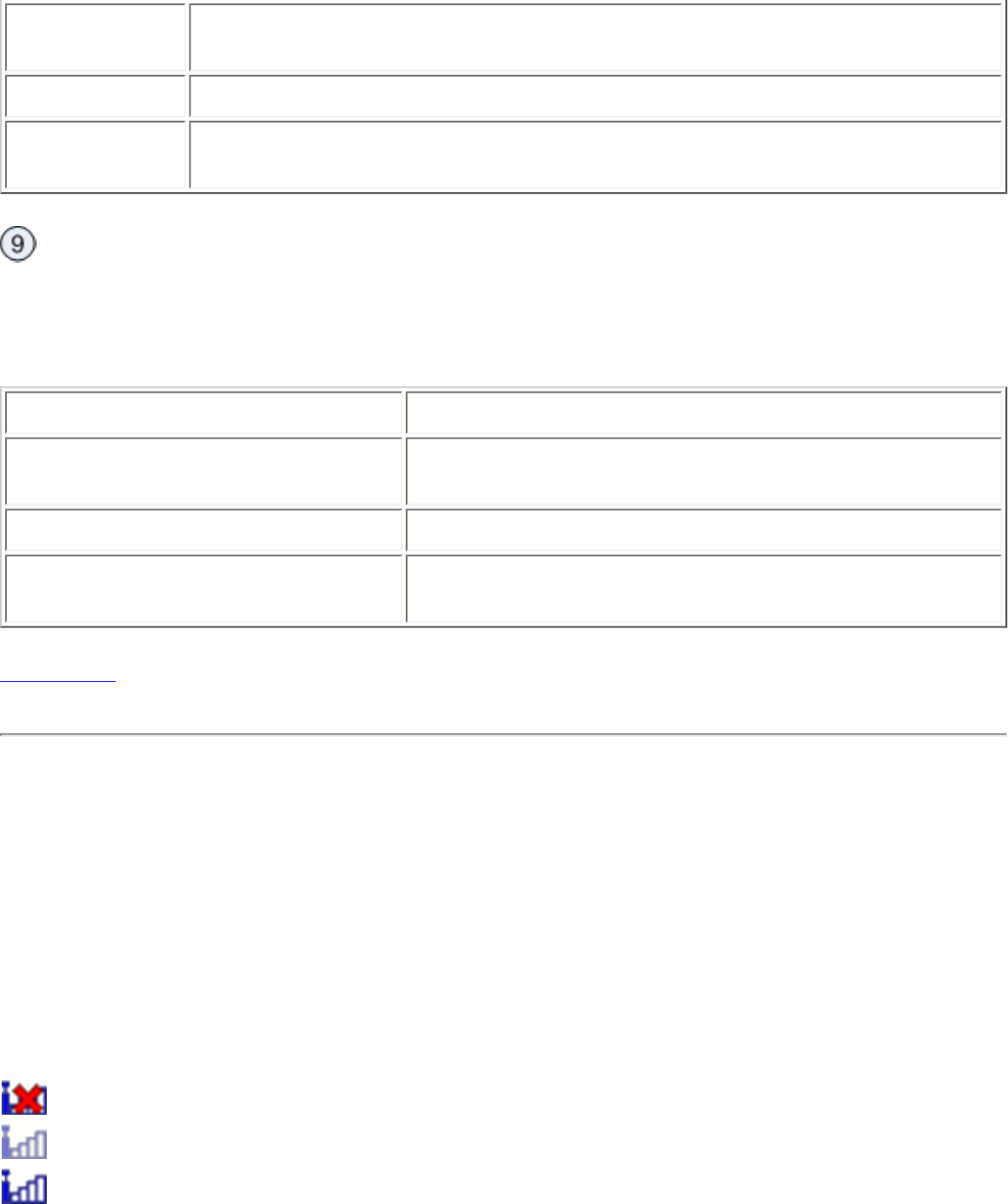
Getting Around the Utility: Dell Mobile Broadband Card Utility User's Guide
Exiting... The Dell Mobile Broadband Card Utility is exiting and the mobile broadband card is
disconnecting.
Device is Locked The mobile broadband card is locked.
Radio Disabled Indicates that the mobile broadband card has been disabled. It is required that the
mobile broadband card be disabled before boarding a plane.
Status Bar Messages
Status messages appear in the status bar actions you should take. The following lists the possible status
bar messages and a description of each:
Status Bar Message Description
Press “Connect” to access the Carrier
network. The internal modem is ready to connect.
To unlock the device press "Unlock". The internal modem is locked.
To enable radio click "Enable Radio". Indicates that the internal modem has been disabled. The
modem must be disabled before boarding a plane.
Top of Page
System Tray
In addition to the state messages displayed in the Status pane, the current status is indicated by the
system tray icons.
● Double-click on the system tray icon to start the Dell Mobile Broadband Card Utility.
● Right-click on the system tray icon to display a menu with other options.
The following shows the status tray icons and a description of each:
Broadband disabled or card not activated.
No card detected or hardware initializing.
Card detected and searching for network. No service yet.
file:///C|/Work/NVTL/Phase3/PDFRequest/HTML_Guide_Cingular/DellMobileBroadbandCardUtility/gettings.htm (5 of 6)5/8/2007 1:03:28 AM

Getting Around the Utility: Dell Mobile Broadband Card Utility User's Guide
Card is in manual connect mode and ready for connection. Use the icon to open the connection
manager to connect Mobile Broadband when needed.
Card is in auto-connect mode and may be connected. Use the icon to open the connection manager
to see current connection status when needed.
Attached to the network and ready to connect.
Connected to data service.
Top of Page
Please read all restrictions and disclaimers.
Top of Page
Back to Contents Page
file:///C|/Work/NVTL/Phase3/PDFRequest/HTML_Guide_Cingular/DellMobileBroadbandCardUtility/gettings.htm (6 of 6)5/8/2007 1:03:28 AM
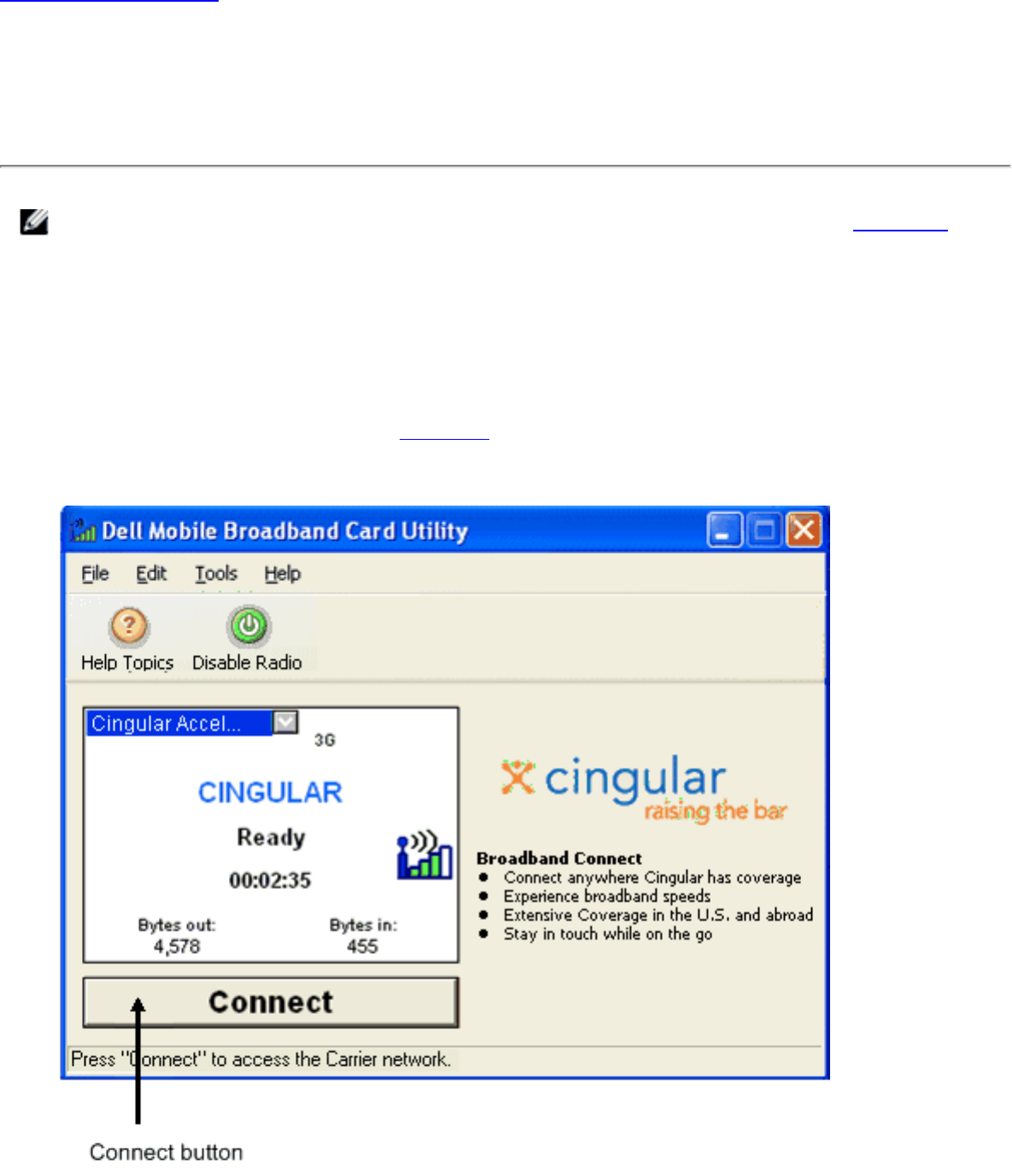
Connecting to the Network: Dell Mobile Broadband Card Utility User's Guide
Back to Contents Page
Connecting to the Network: DellTM Mobile Broadband Card
Utility User's Guide
NOTE: Before connecting ensure your Dell Mobile Broadband Card is activated. Click here for
instructions on activating.
Once your mobile broadband card is activated, connecting to the Internet is as simple as selecting a
connection profile and clicking the Connect button.
1. In the Main window, your pre-configured profile is already selected in the drop-down list. For more
information on how to use profiles, click here.
2. Click the Connect button.
file:///C|/Work/NVTL/Phase3/PDFRequest/HTML_Guide_Cingular/DellMobileBroadbandCardUtility/connect.htm (1 of 2)5/8/2007 1:03:28 AM

Connecting to the Network: Dell Mobile Broadband Card Utility User's Guide
NOTE: Check with your service provider to ensure you are in a coverage area before
connecting. Note that usage data is for informational purposes only and cannot be used to verify
usage data with your service provider.
NOTE: You can also set your mobile broadband card to automatically connect to the network
when you start your computer. For more information, see Configuration.
Once connected, the Connect button changes to Disconnect. Click the button to end your current
connection. To connect to any other network shown, select it from the Profile list, and then click Connect.
NOTE: If your connection fails, see Troubleshooting.
Top of Page
Please read all restrictions and disclaimers.
Top of Page
Back to Contents Page
file:///C|/Work/NVTL/Phase3/PDFRequest/HTML_Guide_Cingular/DellMobileBroadbandCardUtility/connect.htm (2 of 2)5/8/2007 1:03:28 AM

Managing Profiles: Dell Mobile Broadband Card Utility User's Guide
Back to Contents Page
Managing Profiles: DellTM Mobile Broadband Card Utility User's
Guide
About Profiles
Creating Profiles
Profile Settings
Viewing and Editing Profiles
Deleting Profiles
Importing and Exporting Profiles
About Profiles
Connecting to the network requires a unique set of connection settings. You may have more than one
connection account, each with its own settings. A profile is a complete set of connection information
required for connecting to the network. Profiles allow you to define the connection settings, and easily
connect to the network.
NOTE: Default connection profiles have already been created and loaded onto your notebook
computer.
file:///C|/Work/NVTL/Phase3/PDFRequest/HTML_Guide_Cingular/DellMobileBroadbandCardUtility/profiles.htm (1 of 12)5/8/2007 1:03:30 AM
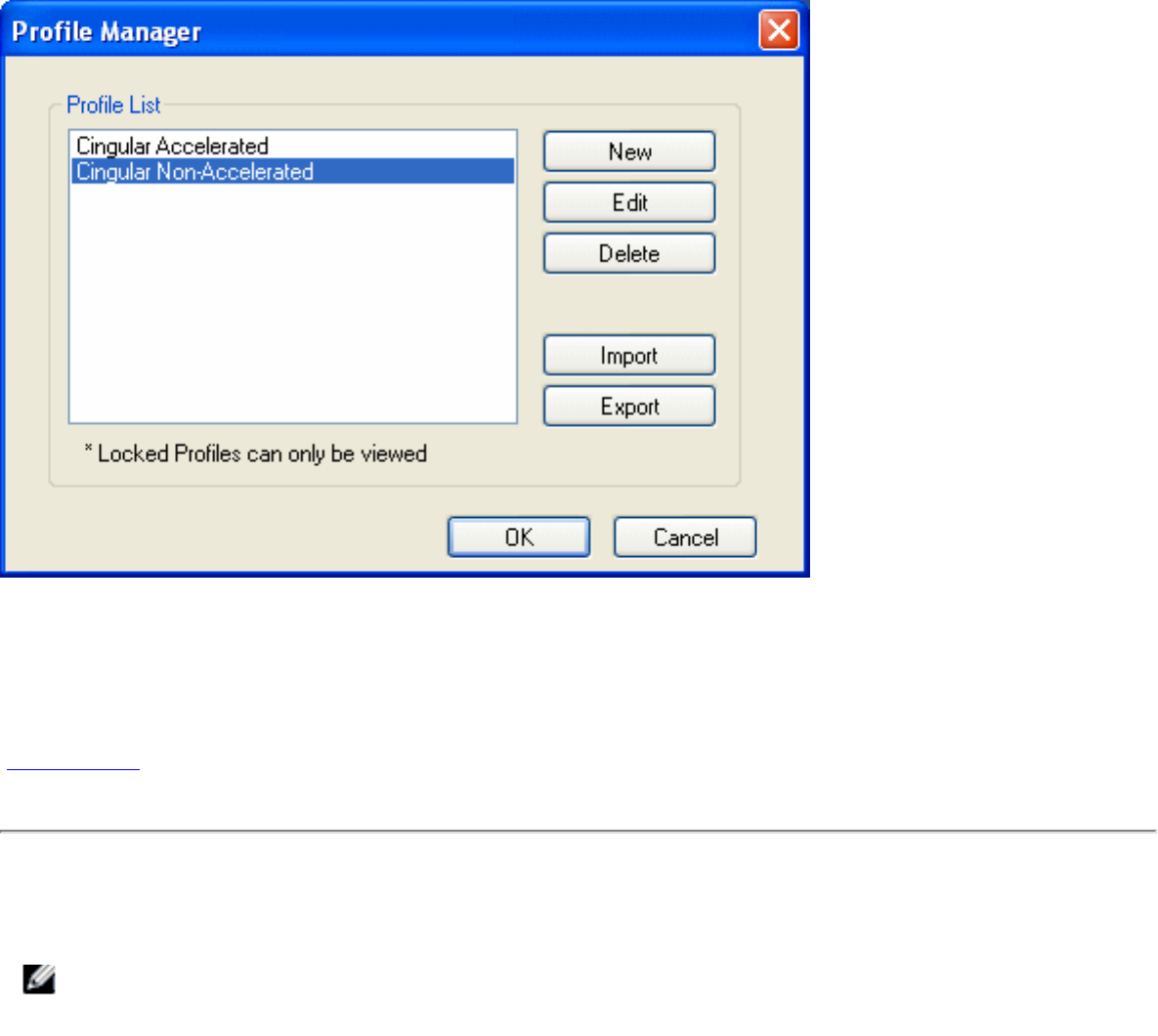
Managing Profiles: Dell Mobile Broadband Card Utility User's Guide
The Profile Manager allows you to view your preloaded profile and also create, edit, view, and delete new
profiles. A profile creation wizard leads you through the steps to create a new profile. An asterisk next to a
profile name indicates a preloaded profile, which is locked. You cannot edit a locked profile.
Top of Page
Creating Profiles
NOTE: Your service provider can assist you in making the correct selections for your new profile.
To create a profile:
1. In the Main window, select Profile Manager from the Edit menu.
2. Click the New button. The first screen of the Profile Wizard appears.
file:///C|/Work/NVTL/Phase3/PDFRequest/HTML_Guide_Cingular/DellMobileBroadbandCardUtility/profiles.htm (2 of 12)5/8/2007 1:03:30 AM
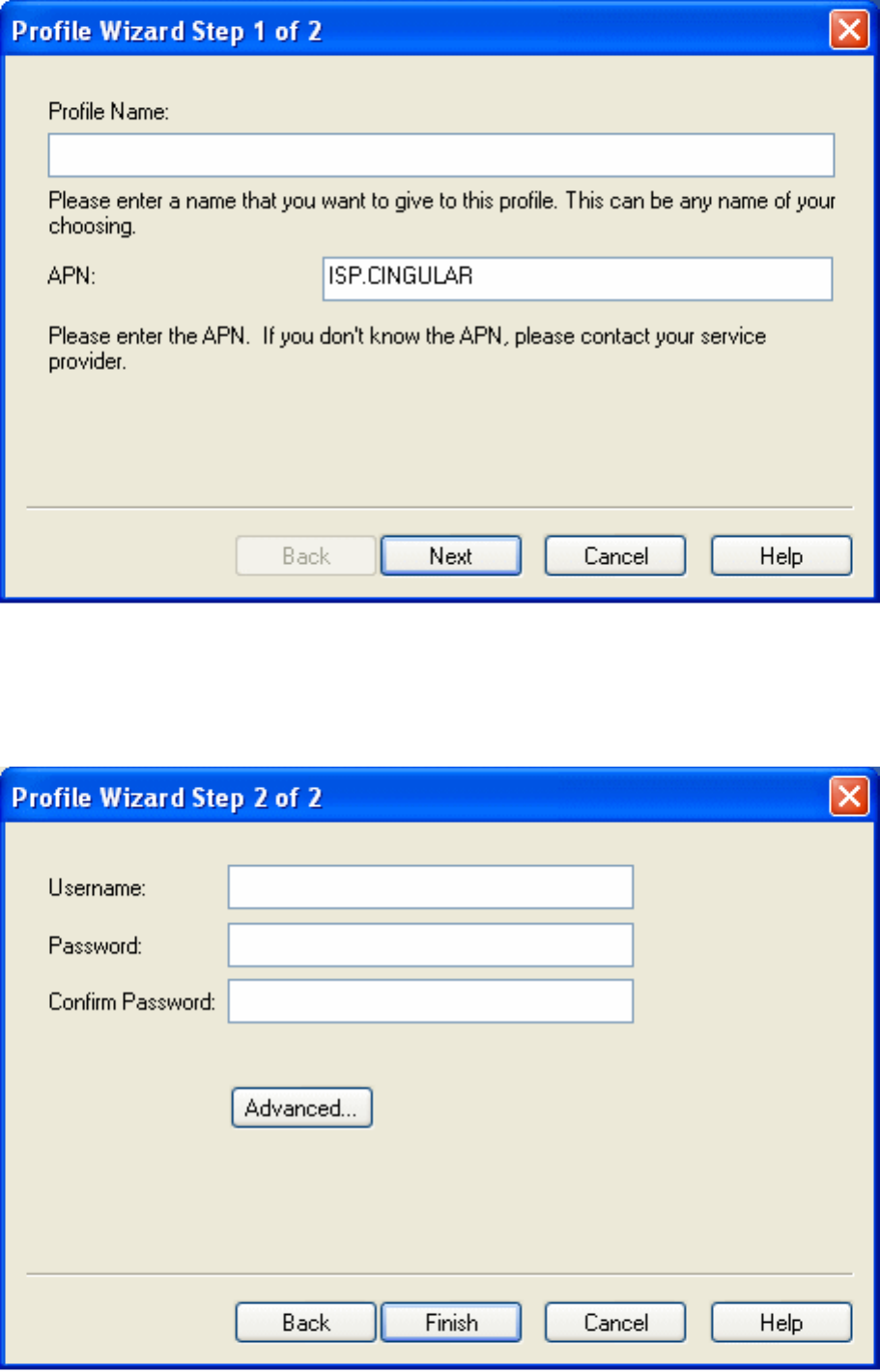
Managing Profiles: Dell Mobile Broadband Card Utility User's Guide
3. In the Profile Name box, enter a name to identify the profile and select a connection type.
4. In the APN box, enter the APN. If you don't know your APN, contact your service provider.
5. Click Next to display the next wizard screen.
file:///C|/Work/NVTL/Phase3/PDFRequest/HTML_Guide_Cingular/DellMobileBroadbandCardUtility/profiles.htm (3 of 12)5/8/2007 1:03:30 AM

Managing Profiles: Dell Mobile Broadband Card Utility User's Guide
6. In the Username box, enter your username or use the default username provided (recommended).
The username must be valid with your service provider.
7. In the Password box, enter your password or use the default password provided (recommended).
The password must be valid with your service provider.
8. In the Confirm Password box, re-enter the password you entered in the previous step, and click
Finish.
9. To access the Advanced dialog box to enter TCP/IP or VPN information, click Advanced. The
Advanced options are identical to the TCP/IP and VPN tabs of the Edit Profile dialog box. For
information on using these tabs, see Profile Settings.
10. Click Finish.
11. In the Profile Manager window, click OK.
Top of Page
Profile Settings
Profile settings are grouped as follows:
● General
● TCP/IP
● VPN
Each group has its own tab in the Profile Manager. When you select a locked profile in the Profile
Manager, the View button is displayed, allowing you to view the profile settings. When you select an
unlocked profile, the Edit button appears, enabling you to edit the profile settings.
General Settings
The General tab displays general connection profile information. The following are the General settings
associated with a connection profile.
file:///C|/Work/NVTL/Phase3/PDFRequest/HTML_Guide_Cingular/DellMobileBroadbandCardUtility/profiles.htm (4 of 12)5/8/2007 1:03:30 AM
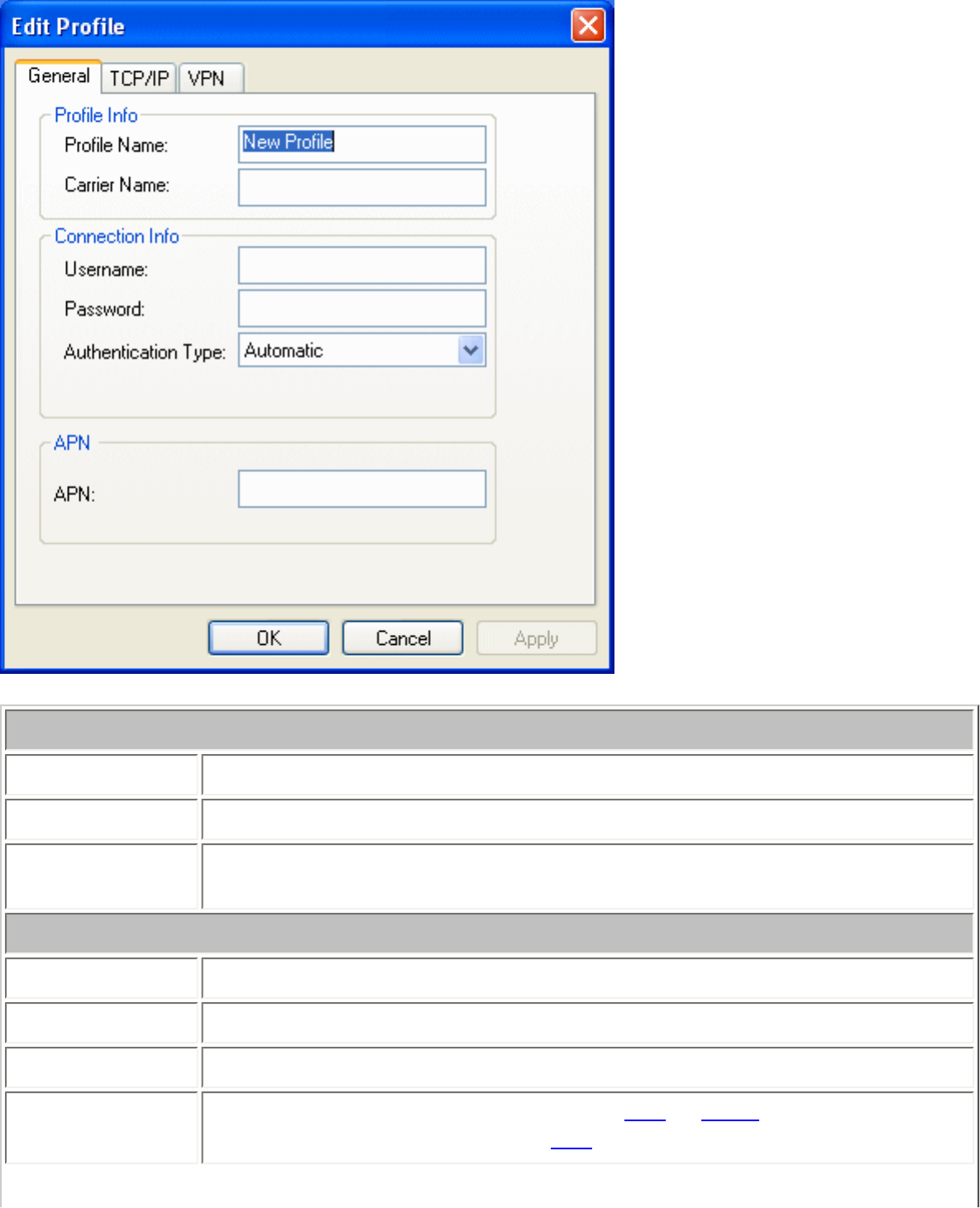
Managing Profiles: Dell Mobile Broadband Card Utility User's Guide
Profile Info
Field Description
Profile Name A name to identify the profile. You can enter any name.
Carrier Name The name of your broadband carrier. Get this information from your service
provider.
Connection Info
Field Description
User Name Your user name. Get this from your service provider.
Password Your password. Get this from your service provider.
Authentication
Type The type of authentication to use: Automatic, PAP, or CHAP. Both PAP and
CHAP are types of authentication for PPP. Get this from your service provider.
file:///C|/Work/NVTL/Phase3/PDFRequest/HTML_Guide_Cingular/DellMobileBroadbandCardUtility/profiles.htm (5 of 12)5/8/2007 1:03:30 AM
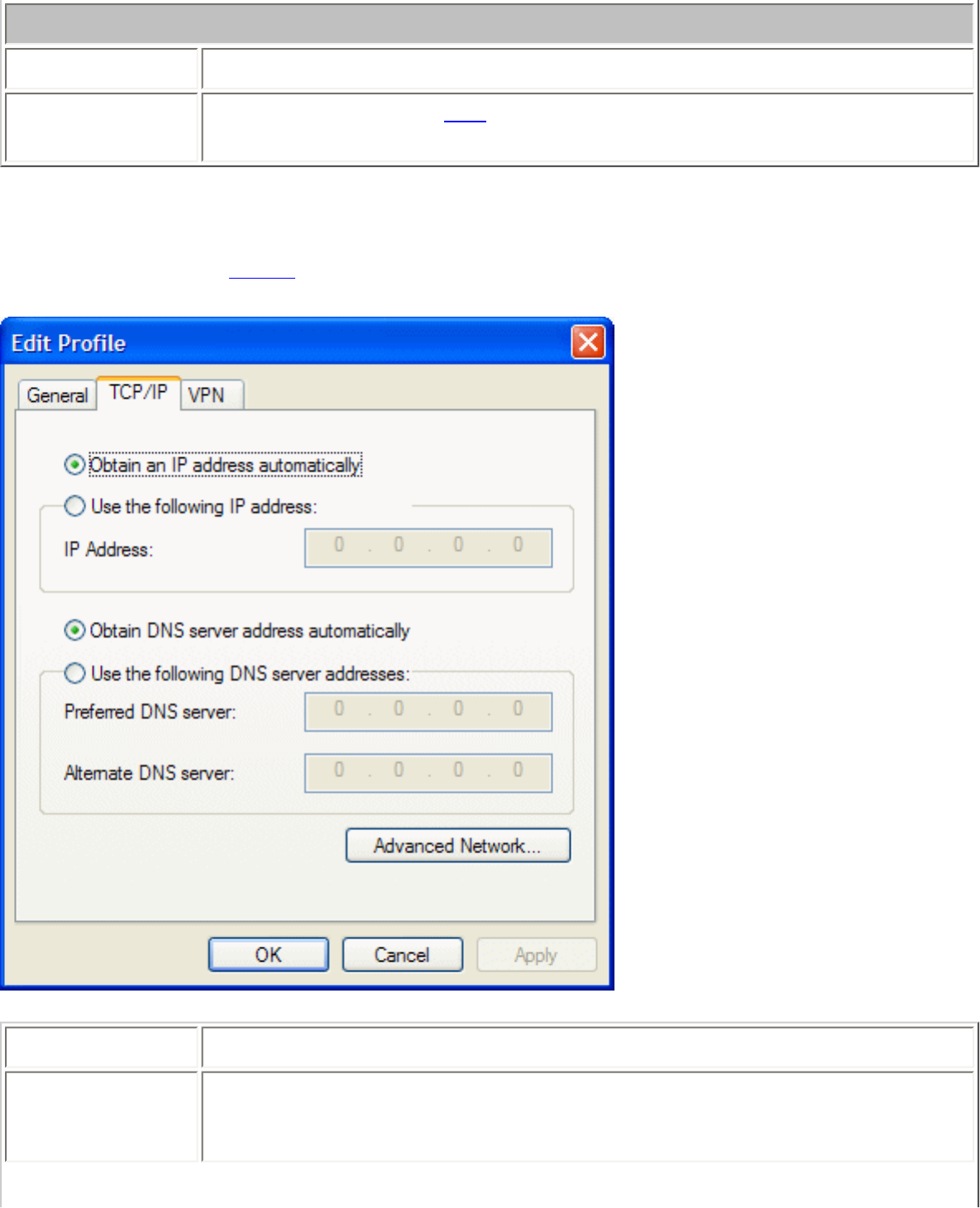
Managing Profiles: Dell Mobile Broadband Card Utility User's Guide
APN
Field Description
APN The Access Point Name (APN), which provides routing information for GPRS. Get
this from your service provider.
TCP/IP Settings
The TCP/IP tab displays TCP/IP settings.
Field Description
Obtain An IP
Address
Automatically
Select this option to obtain a dynamic IP address.
file:///C|/Work/NVTL/Phase3/PDFRequest/HTML_Guide_Cingular/DellMobileBroadbandCardUtility/profiles.htm (6 of 12)5/8/2007 1:03:30 AM

Managing Profiles: Dell Mobile Broadband Card Utility User's Guide
Use The
Following IP
Address
Select this option to enable a static IP rather than a dynamic IP address. A static
IP is an assigned IP Address that does not change.
IP Address The IP address to use for the static IP.
Obtain DNS
Server Address
Automatically
Select this check box if you want to automatically obtain a DNS server address.
Use The
Following DNS
Server Addresses
Select this check box if you want to specify your own DNS server addresses.
Preferred DNS
Server The IP address of the first DNS server to look for.
Alternate DNS
Server The IP address of a backup DNS server to look for.
Advanced Network Click this button if you want to open the Advanced dialog box and specify WINS
and Proxy information. For more information, see the Advanced dialog box
description below.
The Advanced dialog box displays WINS/Proxy settings.
file:///C|/Work/NVTL/Phase3/PDFRequest/HTML_Guide_Cingular/DellMobileBroadbandCardUtility/profiles.htm (7 of 12)5/8/2007 1:03:30 AM
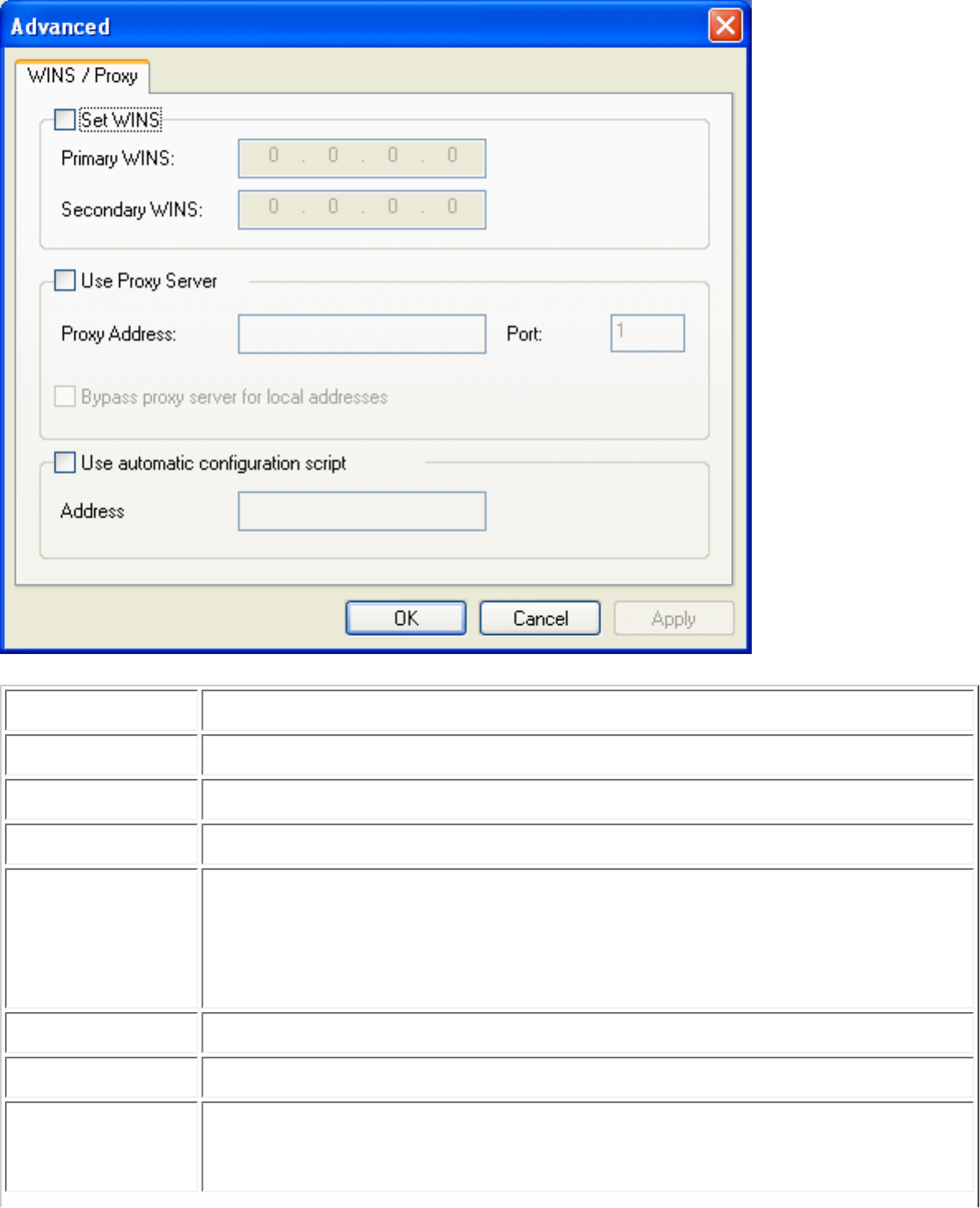
Managing Profiles: Dell Mobile Broadband Card Utility User's Guide
Field Description
Set WINS Select this check box to specify WINS settings.
Primary WINS The IP address of the first WINS server to look for.
Secondary WINS The IP address of a backup WINS server to look for.
Use Proxy Server Enables or disables proxy settings. A proxy server acts as a firewall or security
barrier between your intranet and the Internet, preventing other people on the
Internet from gaining access to confidential information on your internal network
or computer. Your telephony system administrator can provide the correct name
or IP address to enter here.
Proxy Address The IP address for the proxy.
Port The port listened to by the proxy.
Bypass Proxy
Server for Local
Addresses
Select this check box if you want to bypass the proxy server for local addresses.
file:///C|/Work/NVTL/Phase3/PDFRequest/HTML_Guide_Cingular/DellMobileBroadbandCardUtility/profiles.htm (8 of 12)5/8/2007 1:03:30 AM
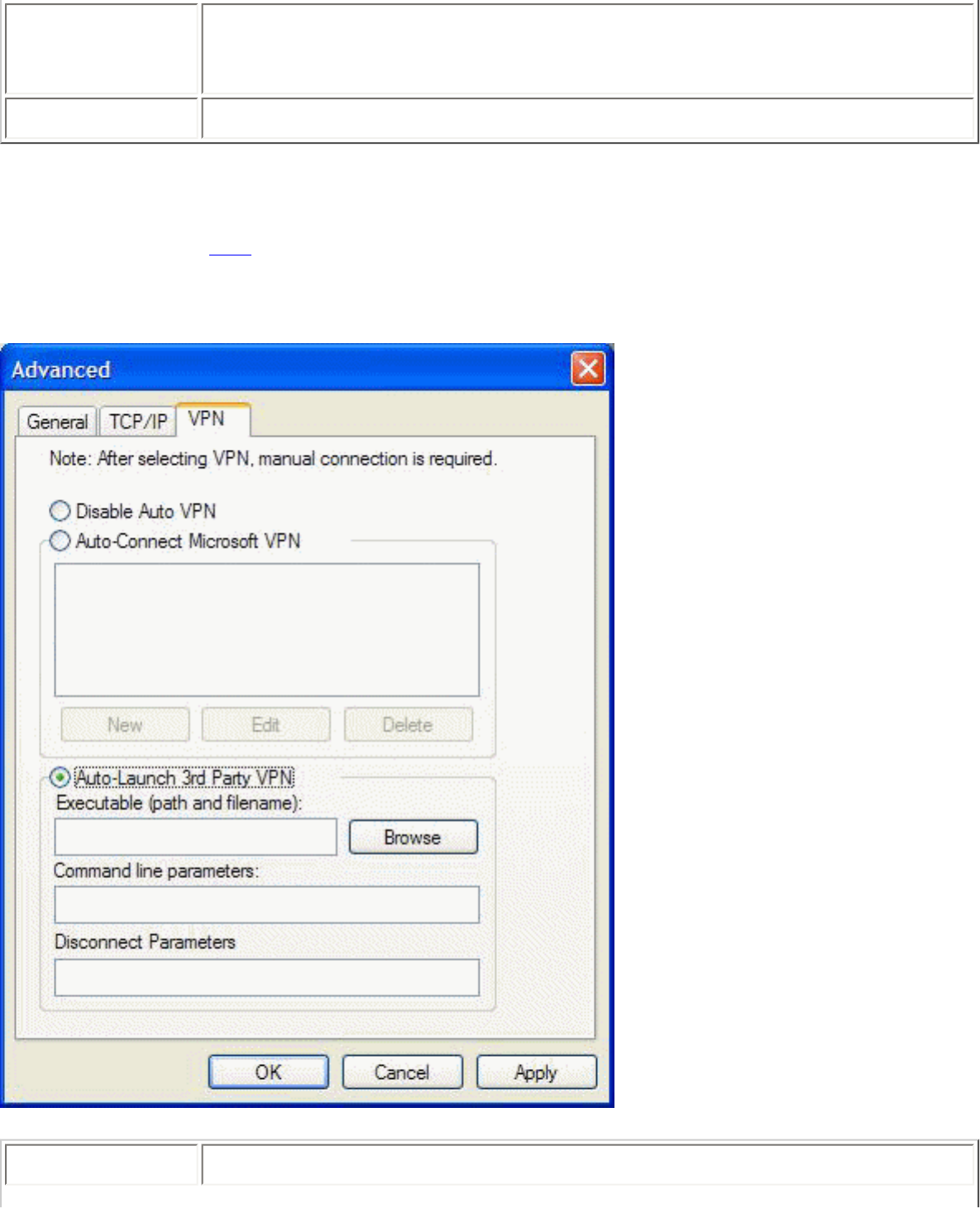
Managing Profiles: Dell Mobile Broadband Card Utility User's Guide
Use Automatic
Configuration
Script
Select this check box if you want to use a configuration script.
Address Enter the URL of the configuration script.
VPN Settings
You can specify that a VPN be associated with a 3G connection. When a successful 3G connection is
made, the associated VPN connection will also be made. This tab allows you to choose a VPN or disable
this feature in the connection profile.
Field Description
file:///C|/Work/NVTL/Phase3/PDFRequest/HTML_Guide_Cingular/DellMobileBroadbandCardUtility/profiles.htm (9 of 12)5/8/2007 1:03:30 AM

Managing Profiles: Dell Mobile Broadband Card Utility User's Guide
Disable Auto VPN Select this option if you do not want to automatically connect to the VPN when the
connection is made.
Auto-Connect
Microsoft VPN Select this option if you want to automatically connect using the VPN. Selecting
this option enables the New, Edit, and Delete buttons.
New Click this button to enter a new VPN profile. Click the Auto-Connect Microsoft
VPN option to enable this button.
Edit Click this button to edit an existing VPN profile. Click on an existing VPN profile to
enable this button.
Delete Click this button delete enter a VPN profile. Click on an existing VPN profile to
enable this button.
Auto-Launch 3rd
Party VPN Click this option to automatically launch a third-party VPN on connection.
Executable (path
and filename) Enter a path and the file name to the third-party VPN executable program. Click
Browse to locate the file in the Open dialog box.
Command Line
Parameters Enter any command line parameters required by the third-party VPN.
Disconnect
Parameters Enter any disconnect command line parameters supported by the third-party VPN.
Viewing and Editing Profiles
You can edit the connection information of an existing profile unless the profile is locked. A locked profile
is indicated by an asterisk (*) in the Profile Manager's Profile List. A locked profile can only be viewed.
To view a locked profile:
1. In the Main window, select Profile Manager from the Edit menu.
2. In the Profile List, click on the profile you want to view.
3. Click View. The Edit Profile window appears with the editing options disabled.
4. Click on the General, TCP/IP, or VPN tabs and view any of the profile settings.
5. Click OK or Cancel to close the dialog box.
To edit a profile:
1. In the Main window, select Profile Manager from the Edit menu.
2. In the Profile List, click on the profile you want to edit.
3. Click Edit. The Edit Profile window appears.
4. Click on the General, TCP/IP, or VPN tabs and edit any of the settings of the currently selected
profile.
file:///C|/Work/NVTL/Phase3/PDFRequest/HTML_Guide_Cingular/DellMobileBroadbandCardUtility/profiles.htm (10 of 12)5/8/2007 1:03:30 AM

Managing Profiles: Dell Mobile Broadband Card Utility User's Guide
5. Click OK.
Top of Page
Deleting Profiles
To delete a profile:
1. In the Main window, select Profile Manager from the Edit menu.
2. In the Profile List, click on the connection you want to delete.
3. Click the Delete button.
NOTE: You cannot delete the default profile. The default profile is indicated by an asterisk (*).
Top of Page
Importing and Exporting Profiles
You can export profile information to an XML file or import profile information into Profile Manager from an
XML file that contains valid profile information.
To import a profile:
1. In the Main window, select Profile Manager from the Edit menu.
2. Click the Import button.
3. In the Open dialog box, locate the profile to import, and click Open. A valid profile must be in XML
format and saved with a .xml extension.
To export a profile:
1. In the Main window, select Profile Manager from the Edit menu.
2. In the Profile List, click on the profile you want to export.
3. Click the Export button.
4. In the Save As dialog box, locate the directory where you want to save the profile, enter a name for
the profile, and click Save. The profile will be saved to XML format. The file must have a .xml
extension.
file:///C|/Work/NVTL/Phase3/PDFRequest/HTML_Guide_Cingular/DellMobileBroadbandCardUtility/profiles.htm (11 of 12)5/8/2007 1:03:30 AM

Glossary: Dell Mobile Broadband Card Utility User's Guide
Back to Contents Page
Glossary: DellTM Mobile Broadband Card Utility User's Guide
APN
Access Point Name. Provides routing information for GPRS. The APN consists of two parts; the Network
ID, which identifies the external service requested by a user of the GPRS service, and the Operator ID,
which specifies routing information.
bps
Bits per second. Rate of data flow.
Broadband
High-capacity high-speed, transmission channel with a wider bandwidth than conventional copper
telephone lines. Broadband channels can carry video, voice, and data simultaneously.
CDMA
Code Division Multiple Access. A digital cellular technology using spread-spectrum techniques that is the
common platform for 3G technologies.
CHAP
Challenge Handshake Authentication Protocol. A method of user authentication that uses random values.
file:///C|/Work/NVTL/Phase3/PDFRequest/HTML_Guide_Cingular/DellMobileBroadbandCardUtility/glossary.htm (1 of 6)5/8/2007 1:03:30 AM

Glossary: Dell Mobile Broadband Card Utility User's Guide
EDGE
Enhanced Data GSM Environment OR Enhanced Data for Global Evolution. EDGE is an enhanced
version of GPRS that enables the delivery of multimedia and other broadband applications to mobile
devices. It is designed to deliver data downloads at rates up to 237kbps and is considered an evolutionary
step to 3G/UMTS.
Firewall
A hardware or software boundary that protects a network or single notebook from unwanted outside traffic.
GPRS
General Packet Radio Service. GPRS is a packet-based broadband service with download speeds up to
86kbps. GPRS is considered an evolutionary step to more advanced technologies such as EDGE and
WCDMA.
GPS
Global Positioning System. A satellite-based navigation system that indicates your current position,
including latitude, longitude, and altitude.
HSDPA
High Speed Downlink Packet Access. HSDPA is an enhanced version of WCDMA that supports
broadband connections with download speeds up to 3.6 Mbps. This enhanced 3G technology enables the
download of high-bandwidth multimedia files, high resolution graphics, and other complex files, and
viewing email attachments at broadband-like speeds.
ISP
Internet Service Provider. Also referred to as the service carrier, an ISP provides Internet connection
file:///C|/Work/NVTL/Phase3/PDFRequest/HTML_Guide_Cingular/DellMobileBroadbandCardUtility/glossary.htm (2 of 6)5/8/2007 1:03:30 AM

Glossary: Dell Mobile Broadband Card Utility User's Guide
service.
IP
Internet Protocol. The mechanism by which packets are routed between computers on a network.
Kbps
Kilobits (1024 bits) per second – rate of data flow.
LAN
Local Area Network. A data network confined to limited area with moderate to high data rates.
Mbps
Megabits (1,048,576 bits) per second - rate of data flow
NDIS
Network Driver Interface Specification. A Windows device driver interface that enables support for multiple
network protocols.
NMEA
National Marine Electronics Association. A data specification for communication between marine
electronics using GPS receivers.
file:///C|/Work/NVTL/Phase3/PDFRequest/HTML_Guide_Cingular/DellMobileBroadbandCardUtility/glossary.htm (3 of 6)5/8/2007 1:03:30 AM

Glossary: Dell Mobile Broadband Card Utility User's Guide
PAP
Password Authentication Protocol. A method of user authentication using user names and passwords.
PIN Code
Personal Identity Number. A code that is linked to your SIM card for security. This four-digit code gives
you access to the SIM card and allows you to access your service provider’s network.
Proxy
A firewall mechanism that replaces the IP address of a host on the internal (protected) network with its
own IP address for all traffic passing through it.
PUK Code
Pin Unlock Code. PUK is the code required to unlock a GSM SIM card that has disabled itself after an
incorrect PIN code was entered three times in a row. If an incorrect PUK code is entered 5 to 10 times, the
SIM card will permanently block (disable) itself.
SMS
Short Messaging Service. Short text messages of no more than 160 characters sent and received by
broadband devices.
TCP/IP
Transmission Control Protocol/Internet Protocol. A protocol for communicating over the Internet.
file:///C|/Work/NVTL/Phase3/PDFRequest/HTML_Guide_Cingular/DellMobileBroadbandCardUtility/glossary.htm (4 of 6)5/8/2007 1:03:30 AM

Glossary: Dell Mobile Broadband Card Utility User's Guide
UMTS
Universal Mobile Telecommunications System. A third generation (3G) mobile communications technology
that offers peak data transmission speeds of up to 2 megabits per second (Mbps). UMTS uses WCDMA
technology, and the two terms are often used interchangeably with each other.
VPN
Virtual Private Network. A way to communicate through a dedicated server securely to a corporate
network over the Internet.
WAN
Wide Area Network. A network which uses common carrier-provided lines. Contrasts with LAN.
WCDMA
Wideband Code Division Multiple Access. Based on the GSM technology evolution roadmap, WCDMA
supports upload and download speeds up to 384kbps.
WINS
Windows Internet Naming Service. A system that determines the IP address associated with a particular
network computer.
WWAN
Wireless Wide Area Network. A communications technology that utilizes digital mobile phone systems to
access data from any location in the range of a cell tower that is connected to a data-enabled network.
file:///C|/Work/NVTL/Phase3/PDFRequest/HTML_Guide_Cingular/DellMobileBroadbandCardUtility/glossary.htm (5 of 6)5/8/2007 1:03:30 AM

Glossary: Dell Mobile Broadband Card Utility User's Guide
WWAN Device
Wireless Phone and cable or 3G UMTS PC Card.
Please read all restrictions and disclaimers.
Top of Page
Back to Contents Page
file:///C|/Work/NVTL/Phase3/PDFRequest/HTML_Guide_Cingular/DellMobileBroadbandCardUtility/glossary.htm (6 of 6)5/8/2007 1:03:30 AM

Advanced Settings: Dell Mobile Broadband Card Utility User's Guide
Back to Contents Page
Advanced Settings: DellTM Mobile Broadband Card Utility User's
Guide
Introduction
Disable Dell Mobile Broadband Card
VPN
Managing Profiles
Using GPS
Configuration
Additional Features
Introduction
The Dell Mobile Broadband Card Utility offers you the ability to enable or disable your mobile broadband
card, set up a Virtual Private Network (VPN) for your mobile broadband connection, configure different
connection profiles, and much more.
NOTE: Ensure you are familiar with the functions of these settings prior to changing
them.
Top of Page
Disable Dell Mobile Broadband Card
To disable the Dell Mobile Broadband Card, select Disable Radio from the File menu. To enable the card,
select Enable Radio Off from the File menu.
NOTE: You must disable the Dell Mobile Broadband Card to comply with safety regulations
before boarding a plane. For more information, see Safety Information.
file:///C|/Work/NVTL/Phase3/PDFRequest/HTML_Guide_Cingular/DellMobileBroadbandCardUtility/advanced.htm (1 of 9)5/8/2007 1:03:31 AM

Advanced Settings: Dell Mobile Broadband Card Utility User's Guide
Top of Page
VPN
For a description of VPN settings, see Profile Settings.
To configure a VPN:
1. In the Main window, select Profile Manager from the Edit menu.
2. Click the VPN tab.
3. Configure the settings as required for your VPN.
4. Click OK.
NOTE: VPN configurations are not supported when the Dell Mobile Broadband Card is enabled
for Auto-Connect at Startup.
Top of Page
Managing Profiles
Profiles allow you to easily maintain your connection settings. For information on using profiles, see
Managing Profiles.
Top of Page
Using GPS
NOTE: GPS is available only on supported systems. The Dell Mobile Broadband Card Utility
determines whether your system is supported during installation.
The Global Positioning System (GPS) is a satellite-based navigation system that indicates your current
postion, including latitude, longitude, and altitude.
file:///C|/Work/NVTL/Phase3/PDFRequest/HTML_Guide_Cingular/DellMobileBroadbandCardUtility/advanced.htm (2 of 9)5/8/2007 1:03:31 AM
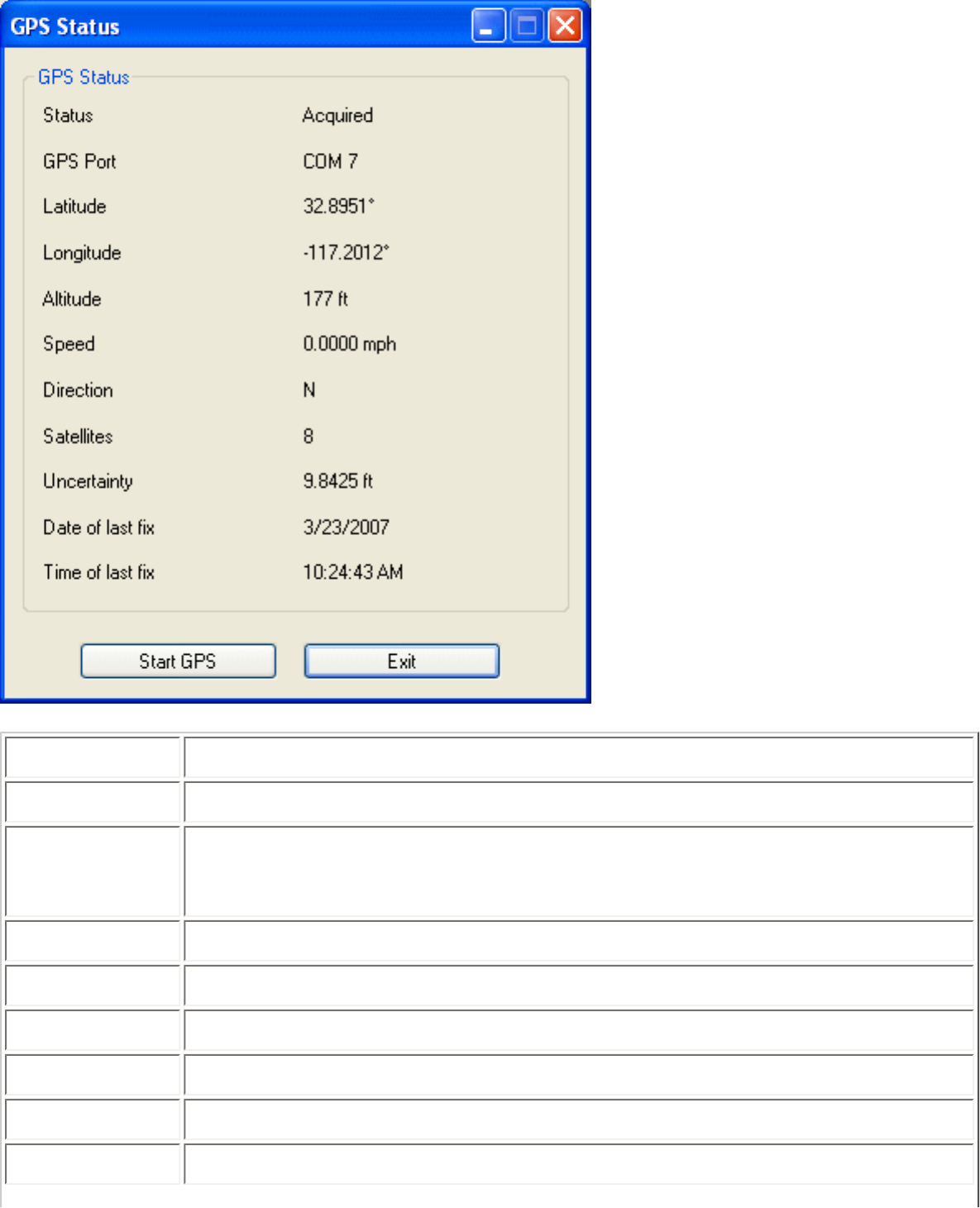
Advanced Settings: Dell Mobile Broadband Card Utility User's Guide
Item Description
Status Current GPS status—Idle, Searching, or Acquired.
GPS Port The COM port that the NMEA data can be read from. Regardless of GPS operation,
the NMEA COM port will be available and can be opened; however, if GPS is
disabled no NMEA data will be sent.
Latitude Latitude of the last GPS acquisition.
Longitude Longitude of the last GPS acquisition.
Altitude Altitude of the last GPS acquisition.
Speed Velocity as of the last GPS acquisition.
Direction Bearing as of the last GPS acquisition.
Satellites Number of satellites currently acquired.
file:///C|/Work/NVTL/Phase3/PDFRequest/HTML_Guide_Cingular/DellMobileBroadbandCardUtility/advanced.htm (3 of 9)5/8/2007 1:03:31 AM

Advanced Settings: Dell Mobile Broadband Card Utility User's Guide
Uncertainty Your GPS position may “drift” slightly, which can cause a small inaccuracy in the
Speed reading but a potentially larger variance in the Direction reading. This
number indicates the possible variance between the Direction value and your actual
bearing.
Date of Last Fix Network date of the last GPS acquisition.
Time of Last Fix Network time of the last GPS acquisition.
To use GPS:
1. In the Main window, select GPS Status from the Tools menu, or click the GPS Status button in
the tool bar.
2. In the GPS Status window, click Start GPS.
If the GPS position cannot be obtained within 5 minutes, a warning message appears: “Unable to
obtain a GPS fix. Please make sure you have a clear view of the sky. Would you like to stop GPS?”
Make sure the system has a clear view of the sky and click Continue Searching, or click Stop.
3. Once location information appears in the GPS window, open the mapping software and configure
the correct COM port. The GPS COM port can be found in the GPS Status window as shown
above.
To disable GPS:
NOTE: Disabling the Mobile Broadband Card will not disable GPS. Follow the instructions below to
stop GPS operation.
1. In the Main window, select GPS Status from the Tools menu, or click the GPS Status button in
the tool bar.
2. In the GPS Status window, click Exit.
Top of Page
Configuration
Configuring the General Settings
You can customize how the Dell Mobile Broadband Card Utility appears on the desktop and its connection
behavior. You can configure it to launch on startup and specify the profile to use. You can also configure it
to be displayed on top of other running applications and configure the lock code.
file:///C|/Work/NVTL/Phase3/PDFRequest/HTML_Guide_Cingular/DellMobileBroadbandCardUtility/advanced.htm (4 of 9)5/8/2007 1:03:31 AM
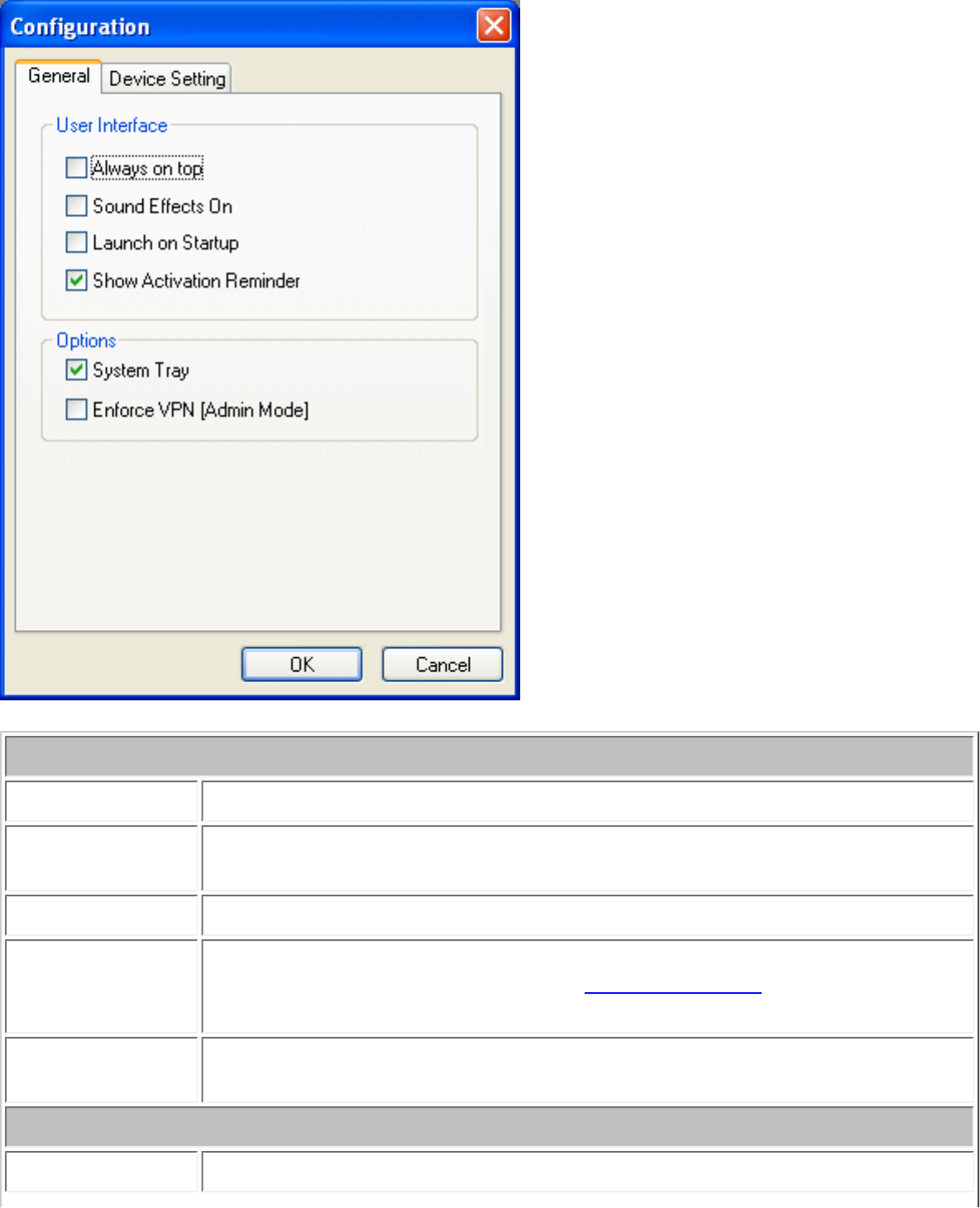
Advanced Settings: Dell Mobile Broadband Card Utility User's Guide
User Interface
Option Description
Always On Top Select this option to always display the Dell Mobile Broadband Card Utility on top
of other applications.
Sound Effects On Select this option to turn on sound effects.
Launch On Startup Select this option if you want to launch the Dell Mobile Broadband Card Utility
when you start your notebook computer. Connection logging is not available if you
select this option.
Show Activation
Reminder Select this option if you want to be reminded when you start the Dell Mobile
Broadband Card Utility to activate your card if it is not yet activated.
Options
Option Description
file:///C|/Work/NVTL/Phase3/PDFRequest/HTML_Guide_Cingular/DellMobileBroadbandCardUtility/advanced.htm (5 of 9)5/8/2007 1:03:31 AM

Advanced Settings: Dell Mobile Broadband Card Utility User's Guide
System Tray Set this option if you want the Dell Mobile Broadband Card to display status icons
in the status bar.
Enforce VPN
(Admin Mode) Set this option if you want to require a VPN connection when the Dell Mobile
Broadband Card Utility starts up. You must have Windows administrator privileges
to set this option.
To configure the General settings:
1. In the Main window, select Configuration from the Edit menu.
2. In the Configuration dialog box, click the General tab if it is not already selected, and set any of
the following:
❍ To always display the Dell Mobile Broadband Card Utility on top of other applications, select
Always On Top.
❍ To turn sound effects on or off, select or deselect Sound Effects On.
❍ To launch the utility on startup, select Launch on Startup. You must have administrator
privileges to modify this setting.
❍ To show an activation reminder if you have not yet activated your card, select Show
Activation Reminder.
3. To close the dialog box and save your settings, click OK.
Configuring the Device Settings
You can configure your mobile broadband card to automatically connect to the network when you power
up your system or manually connect and disconnect using the Connect/Disconnect button in the main
window. You can also require a PIN code to unlock your mobile broadband card on startup.
file:///C|/Work/NVTL/Phase3/PDFRequest/HTML_Guide_Cingular/DellMobileBroadbandCardUtility/advanced.htm (6 of 9)5/8/2007 1:03:31 AM
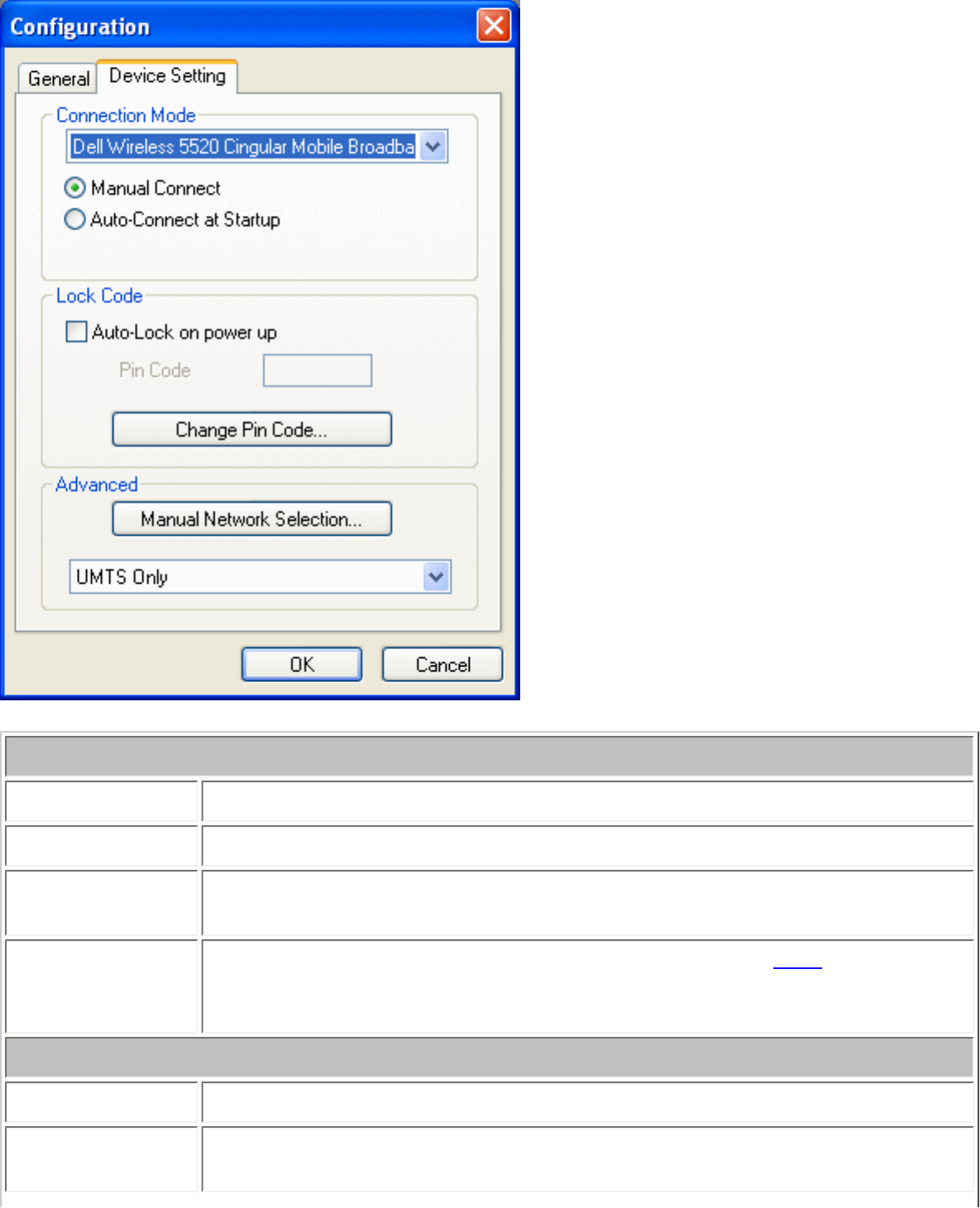
Advanced Settings: Dell Mobile Broadband Card Utility User's Guide
Connection Mode
Option Description
Connection Mode Select your mobile broadband card.
Manual Connect Select this option if you want to manually connect and disconnect from the
network.
Auto-Connect At
Startup Select this option if you want to auto-connect at startup using NDIS. If you choose
this option, the card will be up, running, and connected by the time you log into
Windows.
Lock Code
Option Description
Auto-Lock On
Power Up Set this option to require a PIN code to unlock your mobile broadband card when
you start up.
file:///C|/Work/NVTL/Phase3/PDFRequest/HTML_Guide_Cingular/DellMobileBroadbandCardUtility/advanced.htm (7 of 9)5/8/2007 1:03:31 AM
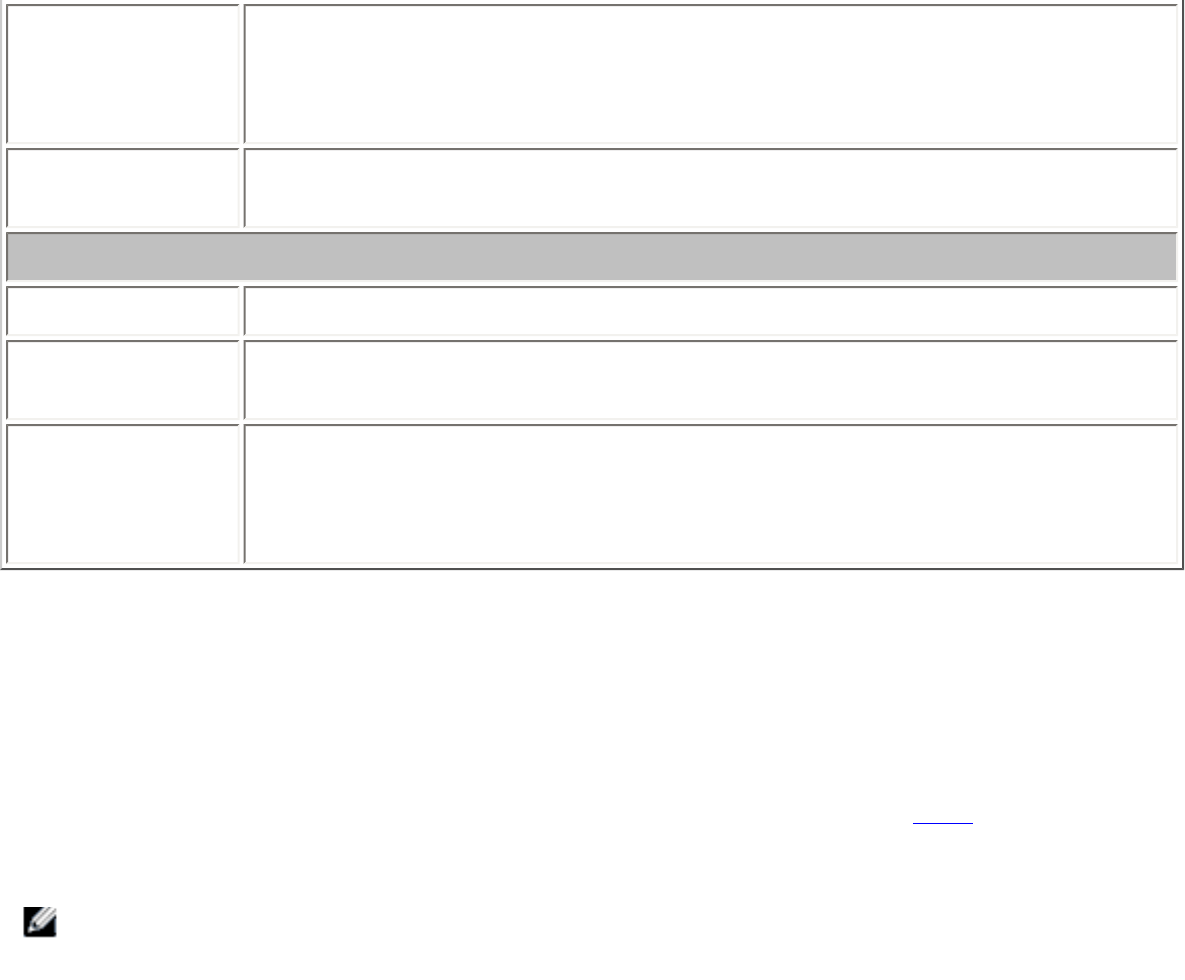
Advanced Settings: Dell Mobile Broadband Card Utility User's Guide
Pin Code If you select the Auto-Lock On Power Up option, enter the PIN code in this text
box that will be required to unlock your mobile broadband card. If you unlock your
mobile broadband card using the PUK code provided by your service provider, the
PIN code is automatically set to "0000".
Change Pin
Code... Click this button to open the Change Pin Code dialog box and change your PIN
code.
Advanced
Option Description
Manual Network
Selection... Click this button to open the Manual Network selection dialog box and choose a
network.
Network Type
drop-down list Select a network type from the drop-down list. The network type—Automatic,
GPRS Only, or UMTS Only—determine the type of network to look for when your
notebook computer starts up. Select Automatic to look for the best network
available of either type.
To configure the connection settings:
1. In the Main window, select Configuration from the Edit menu.
2. In the Configuration dialog box, click the Device Setting tab, and set any of the following:
❍ In the Connection Mode drop-down list, select your mobile broadband card.
❍ Select a connection mode option: Manual Connect to manually control the connection, or
Auto-Connect At Startup to connect automatically at startup using NDIS.
3. To close the dialog box and save your settings, click OK.
NOTE: If you choose Auto-Connect At Startup mode, you will always be connected when you
start your computer provided you are in a data service coverage area.
To configure the lock code settings:
1. In the Main window, select Configuration from the Edit menu.
2. In the Configuration dialog box, click the Device Setting tab, and set any of the following:
❍ To require a PIN code to unlock your notebook computer, select the Auto-Lock On Power
Up check box and enter the PIN code in the Pin Code box.
❍ To change the PIN code, click the Change Pin Code... button to open the Change Pin
Code dialog box, enter the current PIN code in the Current Code box and the new code in
the New Code and New Code Confirm boxes, and click OK.
3. To close the Configuration dialog box and save your settings, click OK.
To configure the Advanced settings:
file:///C|/Work/NVTL/Phase3/PDFRequest/HTML_Guide_Cingular/DellMobileBroadbandCardUtility/advanced.htm (8 of 9)5/8/2007 1:03:31 AM

Advanced Settings: Dell Mobile Broadband Card Utility User's Guide
1. In the Main window, select Configuration from the Edit menu.
2. In the Configuration dialog box, click the Device Setting tab, and set any of the following:
3. To select a network manually, click Manual Network Selection....
In the Manual Network Selectiondialog box, select the network and click OK. In the drop-down list
box, select a network type to look for on startup.
4. To close the Configuration dialog box and save your settings, click OK.
Top of Page
Additional Features
Additional features include:
● Device Properties
● Connection Log
● Copyright, date, and version information
For information on these additional features, see Additional Features.
Please read all restrictions and disclaimers.
Top of Page
Back to Contents Page
file:///C|/Work/NVTL/Phase3/PDFRequest/HTML_Guide_Cingular/DellMobileBroadbandCardUtility/advanced.htm (9 of 9)5/8/2007 1:03:31 AM

Safety Information: Dell Mobile Broadband Card Utility User's Guide
Back to Contents Page
Safety Information: DellTM Mobile Broadband Card Utility User's
Guide
SAR Information
Safety Hazards
SAR Information
FCC Radiation Exposure Statement
The radiated output power of the Dell Wireless Mobile Broadband device is far below the FCC radio
frequency exposure limits. Nevertheless, the Dell Wireless Mobile Broadband devices should be used in
such a manner that the potential for human contact during normal operation is minimized. To avoid the
possibility of exceeding the FCC radio frequency exposure limits, you should keep a distance of at least 20
cm between you (or any other person in the vicinity) and the antenna that is built into the notebook.
This device has been evaluated for and shown compliant with the FCC RF exposure limits under mobile
exposure conditions (antennas are at least 20 cm from a person's body) when installed in Dell regular
notebooks. This device when installed in Dell tablet notebooks has also been evaluated for and shown
compliant with the FCC RF exposure limits under portable exposure conditions (antennas are within 20 cm
of a person's body). Details of the authorized configurations can be found at http://www.fcc.gov/oet/ea/ by
entering the FCC ID number on the device.
file:///C|/Work/NVTL/Phase3/PDFRequest/HTML_Guide_Cingular/DellMobileBroadbandCardUtility/safety.htm (1 of 6)5/8/2007 1:03:32 AM
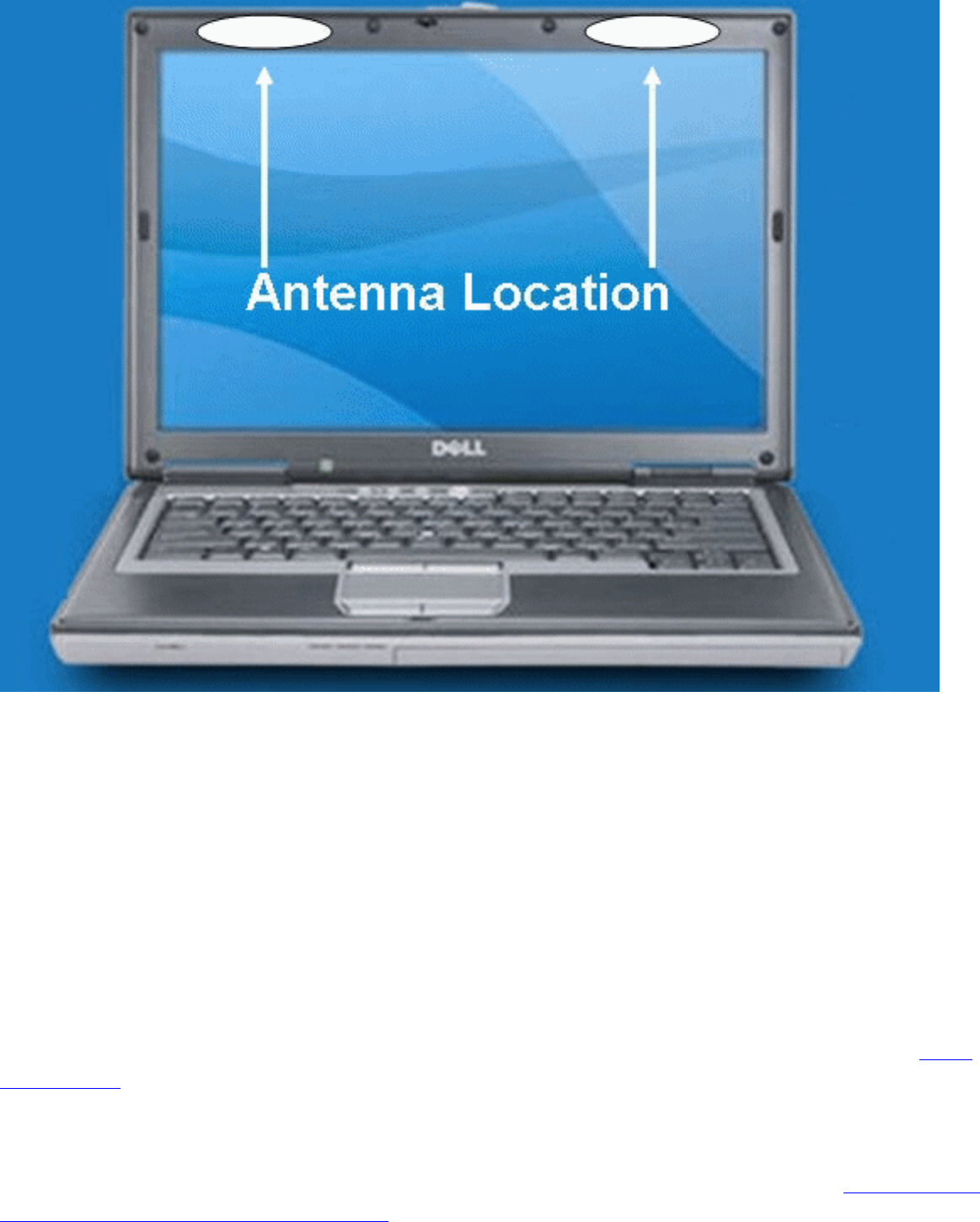
Safety Information: Dell Mobile Broadband Card Utility User's Guide
CONSUMER INFORMATION ABOUT RADIO FREQUENCY EMISSIONS
Your wireless solution, which contains a radio transmitter and receiver, emits radio frequency energy
during use. The following consumer information addresses commonly asked questions about the health
effects of wireless devices.
Are Wireless Devices Safe?
Scientific research on the subject of wireless devices and radio frequency ("RF") energy has been
conducted worldwide for many years, and continues. In the United States, the Food and Drug
Administration ("FDA") and the Federal Communications Commission ("FCC") set policies and procedures
for wireless devices. The FDA and the FCC have created a joint website, "Cell Phone Facts - Consumer
Information on Wireless Devices," which states that "[t]he available scientific evidence does not show that
any health problems are associated with using wireless devices," while noting that "[t]here is no proof,
however, that wireless devices are absolutely safe." You can access the joint FDA/FCC website at http://
www.fda.gov. You can also contact the FDA toll-free at (888) 463-6332 or (888) INFO-FDA. In June 2000,
the FDA entered into a cooperative research and development agreement through which additional
scientific research will be conducted. The FCC issued its own website publication stating that "[t]here is no
scientific evidence that proves that wireless device usage can lead to cancer or a variety of other
problems, including headaches, dizziness or memory loss." This publication is available at http://www.fcc.
gov/cgb/consumerfacts/mobilephone.html or through the FCC at (888) 225-5322 or (888) CALL-FCC.
file:///C|/Work/NVTL/Phase3/PDFRequest/HTML_Guide_Cingular/DellMobileBroadbandCardUtility/safety.htm (2 of 6)5/8/2007 1:03:32 AM

Safety Information: Dell Mobile Broadband Card Utility User's Guide
What Does "SAR" Mean?
In 1996, the FCC, working with the FDA, the U.S. Environmental Protection Agency, and other agencies,
established RF exposure safety guidelines for wireless devices in the United States. Before a wireless
device is available for sale to the public, it must be tested by the manufacturer and certified to the FCC
that it does not exceed limits established by the FCC. One of these limits is expressed as a Specific
Absorption Rate, or "SAR". SAR is a measure of the rate of absorption of RF energy in the body. Tests for
SAR are conducted with the device transmitting at its highest power level in all tested frequency bands.
Since 1996, the FCC has required that the SAR of handheld wireless devices not exceed 1.6 watts per
kilogram, averaged over one gram of tissue. Although the SAR is determined at the highest power level,
the actual SAR value of a wireless device while operating can be less than the reported SAR value. This is
because the SAR value may vary from call to call, depending on factors such as proximity to a cell site
and the proximity of the device to the body while in use. For more information about SARs, see the FCC's
OET Bulletins 56 and 65 at http://www.fcc.gov/Bureaus/Engineering_Technology/Documents/bulletins and
http://www.fcc.gov/oet/fccid, or visit the Cellular Telecommunications Industry Association website at http://
www.ctia.org/wireless_consumers/health_and_safety/index.cfm/AID/152. You may also wish to contact
the manufacturer of your device.
Do Wireless Devices Pose Any Special Risks to Children?
The FDA/FCC website states that "[t]he scientific evidence does not show a danger to users of wireless
communication devices including children." The FDA/FCC website further states that "[s]ome groups
sponsored by other national governments have advised that children be discouraged from using wireless
devices at all. For example, the government in the United Kingdom ["UK"] distributed leaflets containing
such a recommendation in December 2000. [The UK] noted that no evidence exists that using a wireless
device causes brain tumors or other ill effects. [The UK's] recommendation to limit wireless device use by
children was strictly precautionary; it was not based on scientific evidence that any health hazard exists."
A copy of the UK's leaflet is available at http://www.dh.gov.uk (search "mobile"), or you can write to:
NRPB, Chilton, Didcot, Oxon OX11 0RQ, United Kingdom. Copies of UK's annual reports on mobile
devices and RF are available online at http://www.iegmp.org.uk and http://www.hpa.org.uk/radiation/
(search "mobile"). Parents who wish to reduce their children's RF exposure may choose to restrict their
children's wireless device use.
Where Can I Obtain Further Information?
For further information, see the following additional resources (websites current as of January 2005)
U.S. Food and Drug Administration
FDA Consumer magazine
November-December 2000
Telephone: (888) INFO-FDA
http://www.fda.gov/fdac/features/2000/600_phone.html
U.S. Federal Communications Commission
445 12th St. S.W.
Washington, D.C. 20554
Telephone: (888) 225-5322
http://www.fcc.gov/oet/rfsafety
file:///C|/Work/NVTL/Phase3/PDFRequest/HTML_Guide_Cingular/DellMobileBroadbandCardUtility/safety.htm (3 of 6)5/8/2007 1:03:32 AM

Safety Information: Dell Mobile Broadband Card Utility User's Guide
Independent Expert Group on Mobile Devices
http://www.iegmp.org.uk
Royal Society of Canada
Expert Panel on Potential Health Risks of Radiofrequency Fields from Wireless Telecommunications
Devices
283 Sparks Street
Ottawa, Ontario K1R 7X9
Canada
Telephone: (613) 991-6990
http://www.rsc.ca/index.php?page=expert_panels_rf&lang_id=1&page_id=120
World Health Organization
Avenue Appia 20
1211 Geneva 27
Switzerland
Telephone: 011 41 22 791 21 11
http://www.who.int/mediacentre/factsheets/fs193/en/
International Commission on Non-Ionizing Radiation Protection
c/o Bundesamt fur Strahlenschutz
Ingolstaedter Landstr.1
85764 Oberschleissheim
Germany
Telephone: 011 49 1888 333 2156
http://www.icnirp.de
American National Standards Institute
1819 L Street, N.W., 6th Floor
Washington, D.C. 20036
(202) 293-8020
http://www.ansi.org
National Council on Radiation Protection and Measurements
7910 Woodmont Avenue, Suite 800
Bethesda, MD 20814-3095
Telephone: (301) 657-2652
http://www.ncrponline.org
Engineering in Medicine and Biology Society, Committee on Man and Radiation (COMAR), of the Institute
of Electrical and Electronics Engineers
http://ewh.ieee.org/soc/embs/comar/
Top of Page
file:///C|/Work/NVTL/Phase3/PDFRequest/HTML_Guide_Cingular/DellMobileBroadbandCardUtility/safety.htm (4 of 6)5/8/2007 1:03:32 AM

Safety Information: Dell Mobile Broadband Card Utility User's Guide
Safety Hazards
Do not operate the mobile broadband card in an environment that may be susceptible to radio interference
resulting in danger specifically;
● Areas where prohibited by the law
❍ Follow any special rules and regulations and obey all signs and notices. Always turn off the
mobile broadband card and power down the card when instructed to do so, or when you
suspect that it may cause interference or danger.
● Where explosive atmospheres may be present
❍ Do not operate your mobile broadband card in any area where a potentially explosive
atmosphere may exist. Sparks in such areas could cause an explosion or fire resulting in
bodily injury or even death. Be aware and comply with all signs and instructions.
❍ Users are advised not to operate the mobile broadband card while at a refueling point or
service station. Users are reminded to observe restrictions on the use of radio equipment in
fuel depots (fuel storage and distribution areas), chemical plants or where blasting
operations are in progress.
❍ Areas with a potentially explosive atmosphere are often but not always clearly marked.
Potential locations can include gas stations, below deck on boats, chemical transfer or
storage facilities, vehicles using liquefied petroleum gas (such as propane or butane), areas
where the air contains chemicals or particles, such as grain, dust or metal powders, and
any other area where you would normally be advised to turn off your vehicle engine.
● Near Medical and life support equipment
❍ Do not operate your mobile broadband card in any area where medical equipment, life
support equipment, or near any equipment that may be susceptible to any form of radio
interference. In such areas, the mobile broadband card must be turned off. The mobile
broadband card may transmit signals that could interfere with this equipment.
● On an aircraft, either on the ground or airborne
❍ In addition to FAA requirements, many airline regulations state that you must suspend
wireless operations before boarding an airplane. Ensure that the mobile broadband card is
turned off as described in Disable Dell Mobile Broadband Card before boarding aircraft in
order to comply with these regulations. The mobile broadband card can transmit signals
that could interfere with various onboard systems and controls.
● While operating a vehicle
❍ The driver or operator of any vehicle should not operate a wireless data device while in
control of a vehicle. Doing so will detract from the driver or operator's control and operation
of that vehicle. In some countries, operating such communications devices while in control
of a vehicle is an offence.
● Electrostatic Discharge (ESD)
❍ Electrical and electronic devices are sensitive to electrostatic discharge (ESD). Software will
attempt to re-initialize a connection should a substantial electrostatic discharge cause the
device to reset. If the software is not operational after an ESD occurrence, then restart the
modem software application.
❍ Inserting and removing the SIM card—precautions against electrostatic discharge (ESD).
Do not touch the SIM card connectors. As a precaution, always make sure that the data
file:///C|/Work/NVTL/Phase3/PDFRequest/HTML_Guide_Cingular/DellMobileBroadbandCardUtility/safety.htm (5 of 6)5/8/2007 1:03:32 AM

Safety Information: Dell Mobile Broadband Card Utility User's Guide
card is already in your hand before you insert or remove the SIM card.
NOTE: The Dell Mobile Broadband Card and SIM card do not support hot swap.
Ensure the system is powered down prior to installing or removing the devices.
Please read all restrictions and disclaimers.
Top of Page
Back to Contents Page
file:///C|/Work/NVTL/Phase3/PDFRequest/HTML_Guide_Cingular/DellMobileBroadbandCardUtility/safety.htm (6 of 6)5/8/2007 1:03:32 AM

Additional Features: Dell Mobile Broadband Card Utility User's Guide
Back to Contents Page
Additional Features: DellTM Mobile Broadband Card Utility
User's Guide
Introduction
Viewing Device Properties
Viewing the Connection Log
Viewing Copyright, Date, and Version Information
Introduction
You can view properties for the mobile broadband card, a report on current and past connections, and
copyright, date, version information for the Dell Mobile Broadband Card Utility.
Top of Page
Viewing Device Properties
The Device Properties dialog box displays information about the mobile broadband card that may be used
for customer support issues. The dialog box displays the following information:
file:///C|/Work/NVTL/Phase3/PDFRequest/HTML_Guide_Cingular/DellMobileBroadbandCardUtility/features.htm (1 of 5)5/8/2007 1:03:33 AM
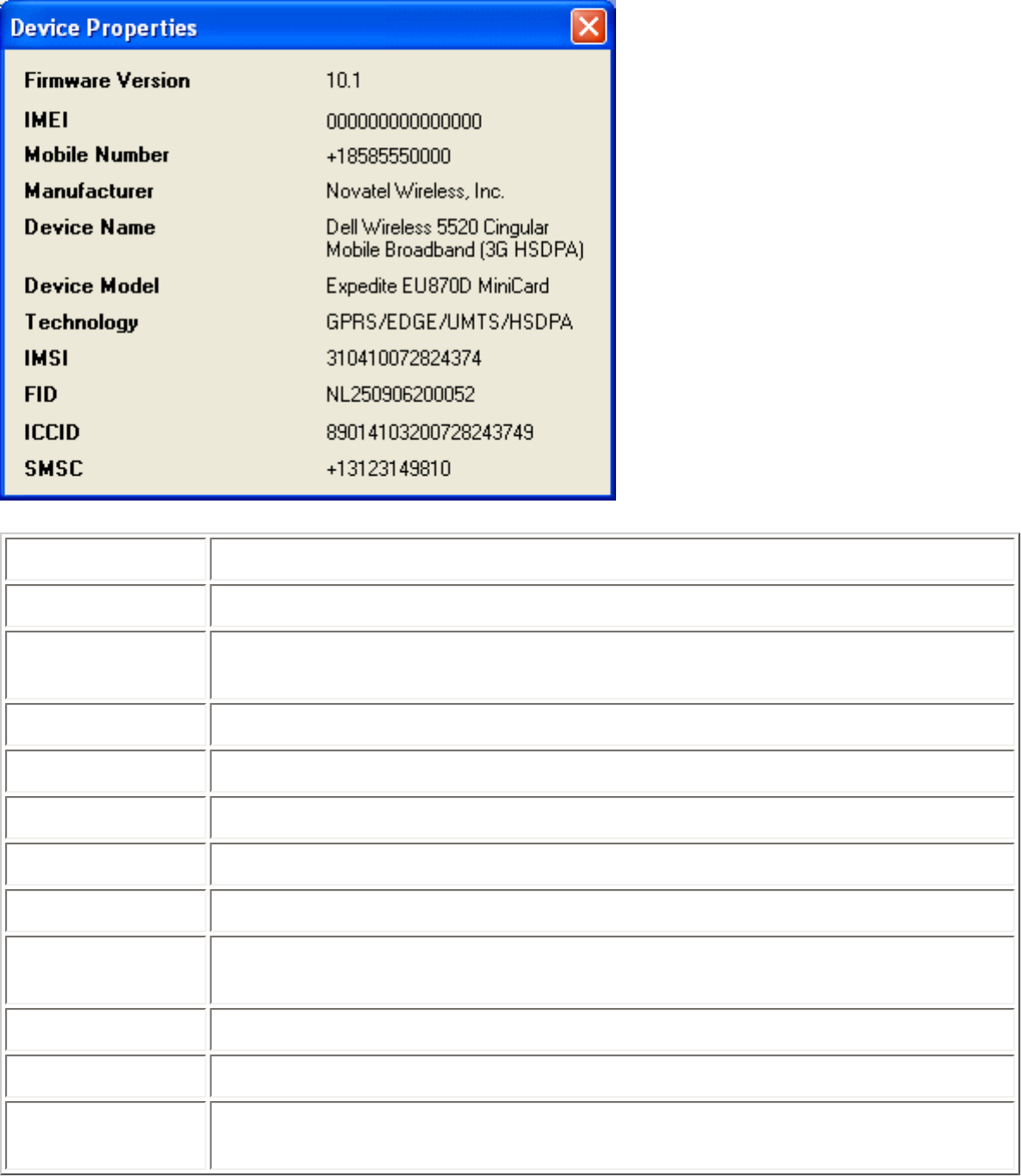
Additional Features: Dell Mobile Broadband Card Utility User's Guide
Property Description
Firmware Version The version of the mobile broadband card firmware.
IMEI International Mobile Equipment Identity. A unique number that identifies your
mobile broadband card on the network.
Mobile Number Mobile directory number of the mobile broadband card.
Manufacturer The name of the mobile broadband card manufacturer.
Device Name The mobile broadband card device name.
Device Model The mobile broadband card device number.
Technology The technology employed by the mobile broadband card.
IMSI International Mobile Subscriber Identity. A unique number that identifies network
mobile phone users.
FID Factory ID. This is a unique tracking number for factory builds.
ICCID Integrated Circuit Card ID. A unique number identifying your SIM card.
SMSC Short Message Service Center. The service center handling the transfer of text
messages.
To view properties:
file:///C|/Work/NVTL/Phase3/PDFRequest/HTML_Guide_Cingular/DellMobileBroadbandCardUtility/features.htm (2 of 5)5/8/2007 1:03:33 AM
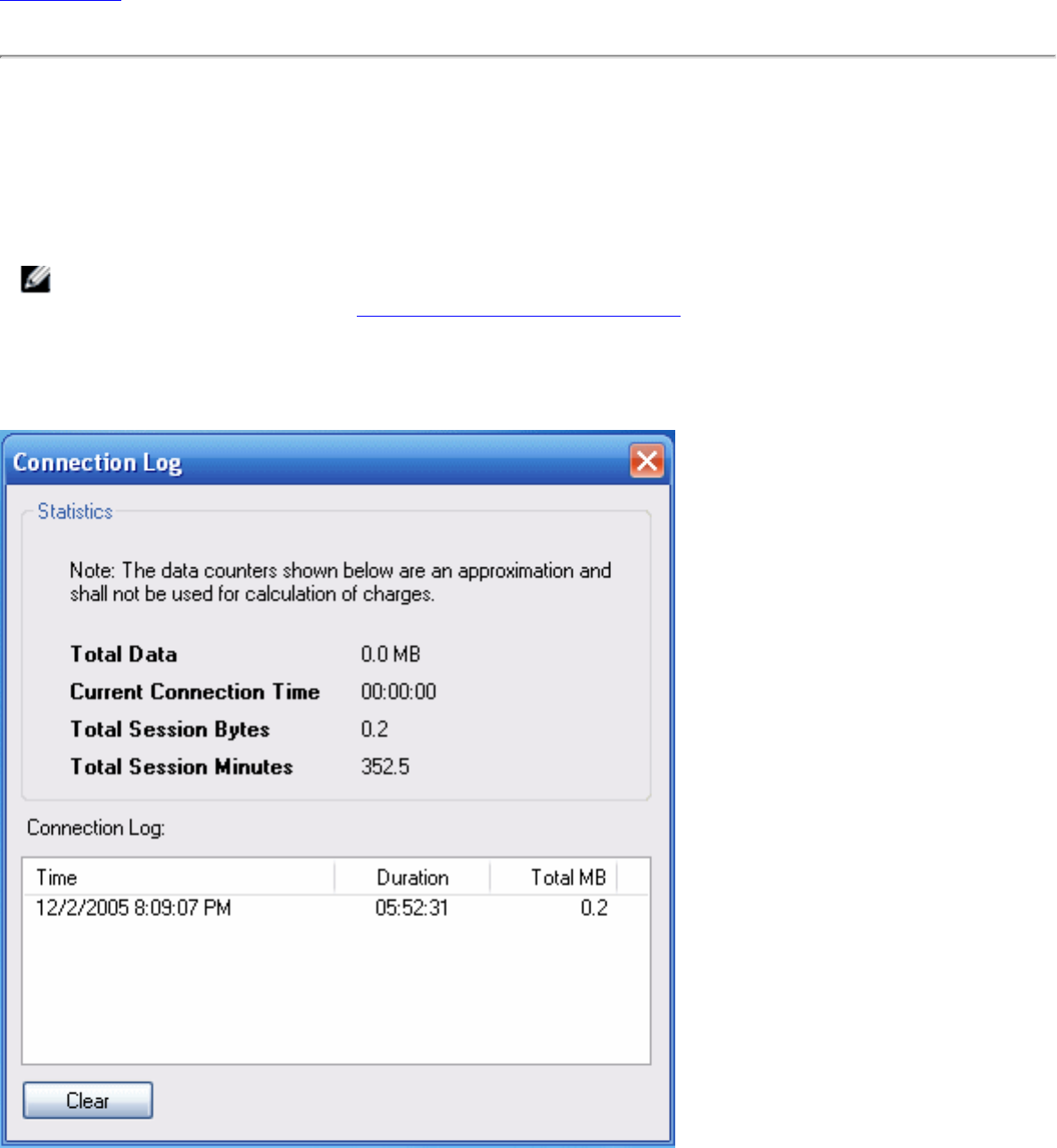
Additional Features: Dell Mobile Broadband Card Utility User's Guide
In the Main window, select Device Properties from the File menu.
Top of Page
Viewing the Connection Log
The Connection Log provides statistical information about the current connection as well as a history of
past connections.
NOTE: Connection logging is not available if you have enabled the Launch On Startup option.
For more information, see Configuring the General Settings
The following information is displayed for the current connection in the Connection Log dialog box:
file:///C|/Work/NVTL/Phase3/PDFRequest/HTML_Guide_Cingular/DellMobileBroadbandCardUtility/features.htm (3 of 5)5/8/2007 1:03:33 AM

Additional Features: Dell Mobile Broadband Card Utility User's Guide
Statistic Description
Total Data The total data sent. This is not related to your service provider's billing information.
Current
Connection Time The length of the current connection.
Total Session
Bytes The number of bytes sent and received during the current session.
Total Session
Minutes The number of minutes connected during the current session. This is not related
to your service provider's billing information.
The time, duration, and total MB of data exchanges are displayed for past sessions in the box at the
bottom of the dialog box.
To view the connection log:
1. In the Main window, select Connection Log from the Tools menu.
2. To clear the log at the bottom of the dialog box, click Clear.
3. To close the Report dialog box, click the Close box.
Top of Page
Viewing the Copyright, Date, and Version Information
The About dialog box displays copyright, date, and version information for the Dell Mobile Broadband Card
Utility installed on your computer.
To view the installed version:
1. In the Main window, select About from the Help menu to open the About dialog box.
2. To close the About dialog box, click the Close box.
Please read all restrictions and disclaimers.
Top of Page
file:///C|/Work/NVTL/Phase3/PDFRequest/HTML_Guide_Cingular/DellMobileBroadbandCardUtility/features.htm (4 of 5)5/8/2007 1:03:33 AM

Troubleshooting: Dell Mobile Broadband Card Utility User's Guide
Back to Contents Page
Troubleshooting: DellTM Mobile Broadband Card Utility User's
Guide
Common Problems and Solutions
About Self-Diagnostics
Running Self-Diagnostics
Diagnostic Error Messages and Resolutions
Getting Help
Common Problems and Solutions
The following are some common problems and solutions.
I cannot install the software
● You may not have administrator privileges.
1. Talk to your system administrator if applicable.
2. Log onto your computer as an administrator, or create a user account with administrator
privileges.
I don't have service
● Check that you have an active subscription plan from your service provider and that the service
has been activated.
● You may be in an area not covered by data coverage. Your mobile phone is a voice device and
most voice carriers have roaming agreements that provide a large coverage area. This may not be
the case for your data service. Check for data coverage with your service provider.
Dell Mobile Broadband Card Utility status is "No Card Detected"
● Make sure that no other software programs are open that may be using the Dell Mobile Broadband
Card.
I cannot connect to the Internet
● Your software may be incorrectly installed. Check that you have correctly installed the Dell Mobile
file:///C|/Work/NVTL/Phase3/PDFRequest/HTML_Guide_Cingular/DellMobileBroadbandCardUtility/trouble.htm (1 of 7)5/8/2007 1:03:33 AM

Troubleshooting: Dell Mobile Broadband Card Utility User's Guide
Broadband Card Utility software located on the CD that came with the product.
● You may not have an active subscription plan. Check that you have an active subscription plan
from your service provider and have activated the service.
● You may be experiencing a service issue. Perform a self-diagnostic to determine the problem. For
detailed instructions on performing a self-diagnostic, see Self-Diagnostics.
I cannot access my Dell Mobile Broadband Card using other software
● Ensure the Dell Mobile Broadband Card Utility has exited by selecting Exit from the File menu.
I have an indication of good signal strength but I am unable to connect
● You may not have an active subscription plan. Check that you have an active subscription plan
from your service provider.
When I run the Dell Mobile Broadband Card Utility software, the window "Searching for Network" is
continuously displayed.
● You may be out of your service coverage area. Check for good signal strength or contact your
service provider.
I cannot browse the Web
● You may not have an IP address. If you are certain that the user name, password, and APN are
correct, check to see if you are getting an IP address:
1. From the Start menu, select Run. In the Run window, type "Command" in the Open box and
click OK.
2. In the Command window, type "cd\" and press the Enter key to navigate to the root directory.
3. Type "ipconfig" and press the Enter key. Your IP address should appear on the screen. If
not, contact your service provider.
● Your server settings may be incorrect.
1. In Internet Explorer, select Internet Options > Connections from the Tools menu.
2. In Dial Up and Virtual Private Network Setting double-click on 3G Connection.
3. Check the appropriate boxes if you are using a proxy server.
● You may be experiencing DNS server problems
1. From the Start menu, select Run. In the Run window, type "Command" in the Open box and
click OK.
2. At the c: prompt, type "PING www.dell.com".
■ Response: Unknown host www.dell.com - This usually indicates a faulty DNS. Call
your service provider.
■ Response: Pinging www.dell.com with 32 bytes of data. This indicates the DNS is
working properly even if you do not receive a reply.
No information appears in the status window when I have GPS enabled
file:///C|/Work/NVTL/Phase3/PDFRequest/HTML_Guide_Cingular/DellMobileBroadbandCardUtility/trouble.htm (2 of 7)5/8/2007 1:03:33 AM

Troubleshooting: Dell Mobile Broadband Card Utility User's Guide
● The system must be outside or have a reasonably clear view of the sky. Try moving your notebook
computer outside or near a window.
● GPS may not be enabled. To enable GPS:
1. In the Main window, select GPS Status from the Tools menu, or click the GPS Status
button in the tool bar.
2. In the GPS Status window, click Start GPS.
If the GPS position cannot be obtained within 5 minutes, a warning message appears:
“Unable to obtain a GPS fix. Please make sure you have a clear view of the sky. Would you
like to stop GPS?” Make sure the system has a clear view of the sky and click Continue
Searching, or click Stop.
3. Once location information appears in the GPS window, open the mapping software and
configure the correct COM port. The GPS COM port can be found in the GPS Status
window.
Top of Page
About Self-Diagnostics
Self-Diagnostics allows you to diagnose problems with the mobile broadband card. Some of the problems
such as bad driver installation, poor network coverage, and unprovisioned Dell Mobile Broadband Card
can be detected. Self-Diagnostics performs the following tests:
● Software Test verifies that your drivers are installed correctly.
● Hardware Test verifies the full functionality of the mobile broadband card.
● Network Test verifies that the network is online available.
file:///C|/Work/NVTL/Phase3/PDFRequest/HTML_Guide_Cingular/DellMobileBroadbandCardUtility/trouble.htm (3 of 7)5/8/2007 1:03:33 AM
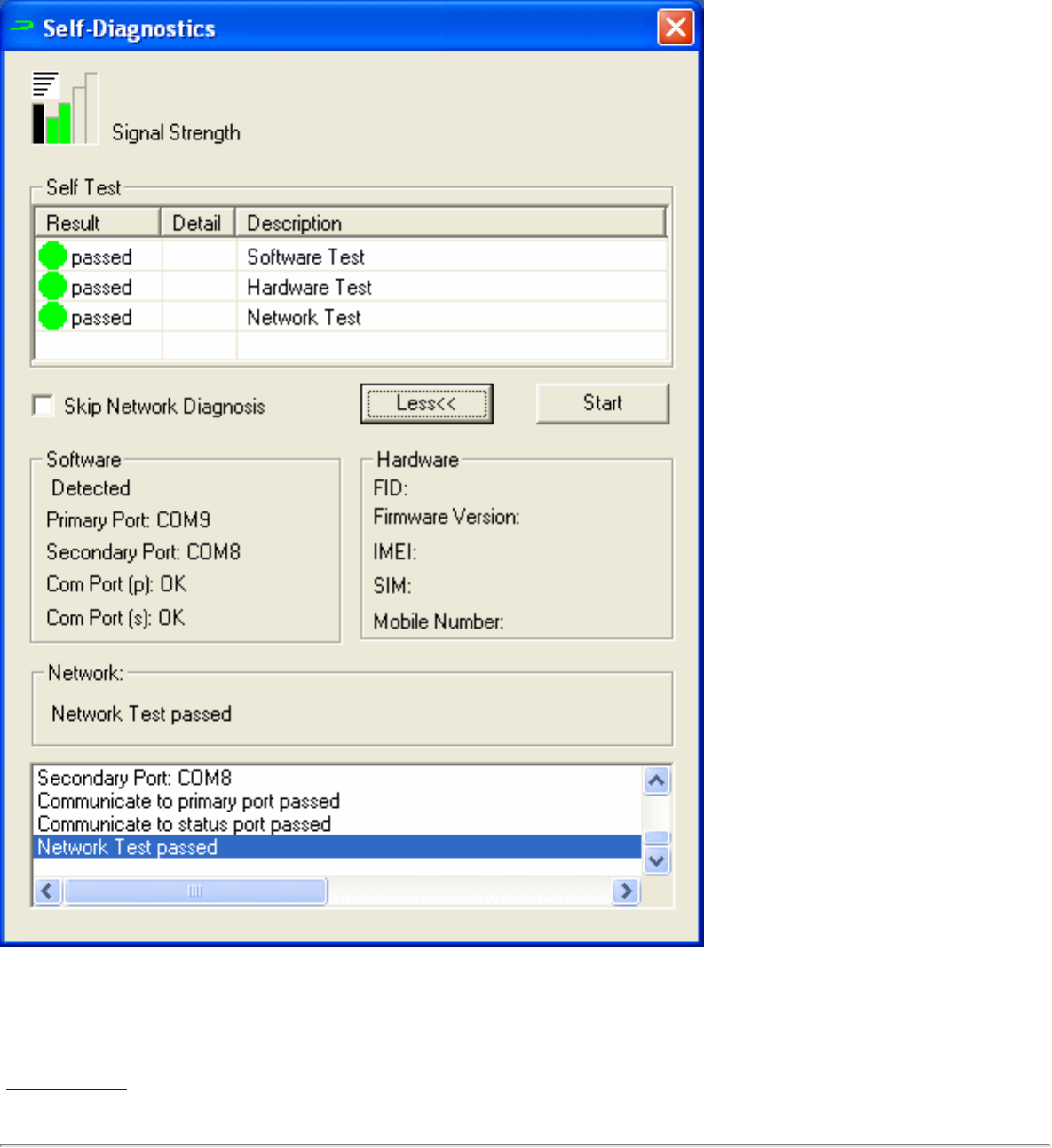
Troubleshooting: Dell Mobile Broadband Card Utility User's Guide
Self-Diagnostics allows you to test your software, hardware, and the network. If you are having difficulty,
run this program to help you isolate the problem.
Top of Page
Running Self-Diagnostics
To perform the self-diagnostics:
file:///C|/Work/NVTL/Phase3/PDFRequest/HTML_Guide_Cingular/DellMobileBroadbandCardUtility/trouble.htm (4 of 7)5/8/2007 1:03:33 AM
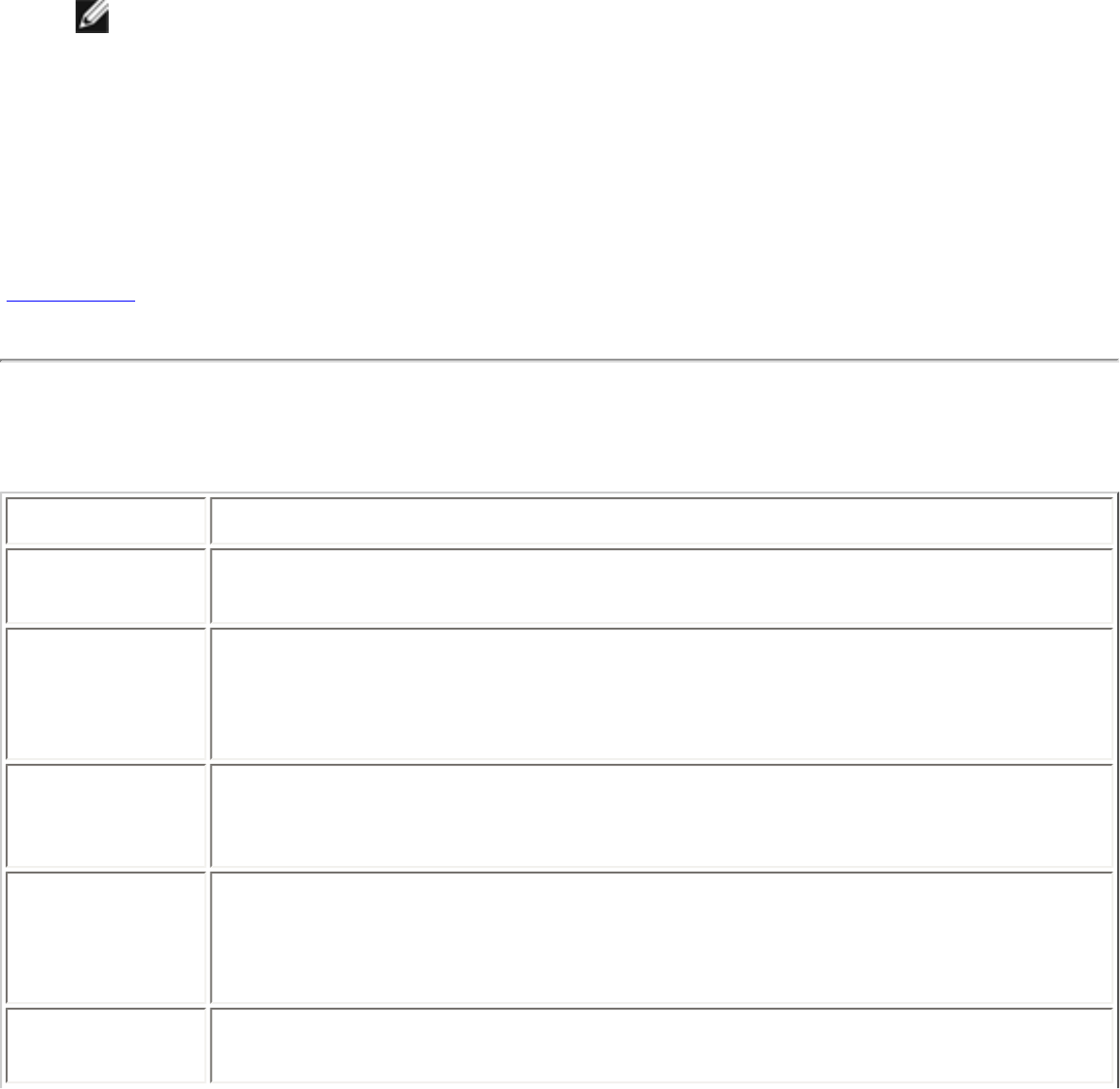
Troubleshooting: Dell Mobile Broadband Card Utility User's Guide
1. From the Help menu, select Self-Diagnostics. The Self-Diagnostics window appears.
2. Click More... to expand the window and view more options.
3. If you want to test the mobile broadband card without checking the network, select the Skip
Network Diagnostics check box.
4. Click Start to begin the test.
As the test proceeds, the results for each test category are displayed in the Self Test box. If you
chose to test the network, detailed network status information is displayed in the Network box at
the bottom of the window. If the signal strength changes during the test, a dialog box appears
asking if you want to retest.
Note: Signal strength may change the outcome of the test if your problem was caused by a
weak signal.
5. Click OK to rerun the test.
If a test category passed, "Passed" appears in green text in the Result column. If a test fails, "Fails"
appears in red. Details of each test category—Software, Hardware, and Network—are displayed in
the window.
6. To stop the test, click Stop.
7. When you have finished testing, close the window.
Top of Page
Diagnostic Error Messages and Resolutions
Error Description
102 The connection has failed. If you are trying to establish a connection by wireless
modem, activate your SIM.
103, 106, 107,
111, 112, 113,
131, 132, 133,
137, 149
If you are trying to establish a connection by wireless modem, the profile may not
be correctly set. For more information on correct profile settings, contact your
service provider or consult the provider's documentation.
127 If you are trying to establish a connection by wireless modem, the profile's APN
setting may not be correctly set. For more information on correct profile settings,
contact your service provider or consult the provider's documentation.
129 If you are trying to establish a connection by wireless modem, the profile's
username or password may not be correctly set. For more information on correct
profile settings, contact your service provider or consult the provider's
documentation.
134, 139 If you are trying to establish a connection by wireless modem, the provider's
network is temporarily unavailable. Please try again later.
file:///C|/Work/NVTL/Phase3/PDFRequest/HTML_Guide_Cingular/DellMobileBroadbandCardUtility/trouble.htm (5 of 7)5/8/2007 1:03:33 AM

Troubleshooting: Dell Mobile Broadband Card Utility User's Guide
619 If you are trying to establish a connection by wireless modem, the profile's login
information, APN, or quality of service settings may not be correctly set. For more
information on correct profile settings, contact your service provider or consult the
provider's documentation. If you are using a wireless modem with a SIM, an
incompatible SIM may be inserted. Verify that the SIM in the wireless modem is
from your service provider.
712 If you are trying to establish a connection by wireless modem, the profile's quality of
service settings may not be correctly set. For more information on correct profile
settings, contact your service provider or consult the provider's documentation.
720 If you are trying to establish a connection by wireless modem, the profile's static IP
settings may not be correctly set. For more information on correct profile settings,
contact your service provider or consult the provider's documentation.
777 If you are trying to establish a connection by wireless modem, the profile's PDP
setting may not be correctly set. For more information on correct profile settings,
contact your service provider or consult the provider's documentation.
Top of Page
Getting Help
If the troubleshooting procedures in this document do not resolve the problem, contact your carrier or visit
Dell Technical Support as follows:
Activation Call Dell's toll-free activation service at 1-800-228-6303.
Connection
Support For billing and account support for your mobile broadband service, contact Cingular
at 1-800-331-0500. You may be asked to provide the mobile number for your
mobile broadband card. For instructions on how to access this information, click
here.
Software/
Hardware
Support
For Dell Mobile Broadband Card or Utility support, check http://support.dell.com for
the latest updates and information. In addition, Dell Technical Support can be
contacted at 1-800-624-9896.
Please read all restrictions and disclaimers.
file:///C|/Work/NVTL/Phase3/PDFRequest/HTML_Guide_Cingular/DellMobileBroadbandCardUtility/trouble.htm (6 of 7)5/8/2007 1:03:33 AM
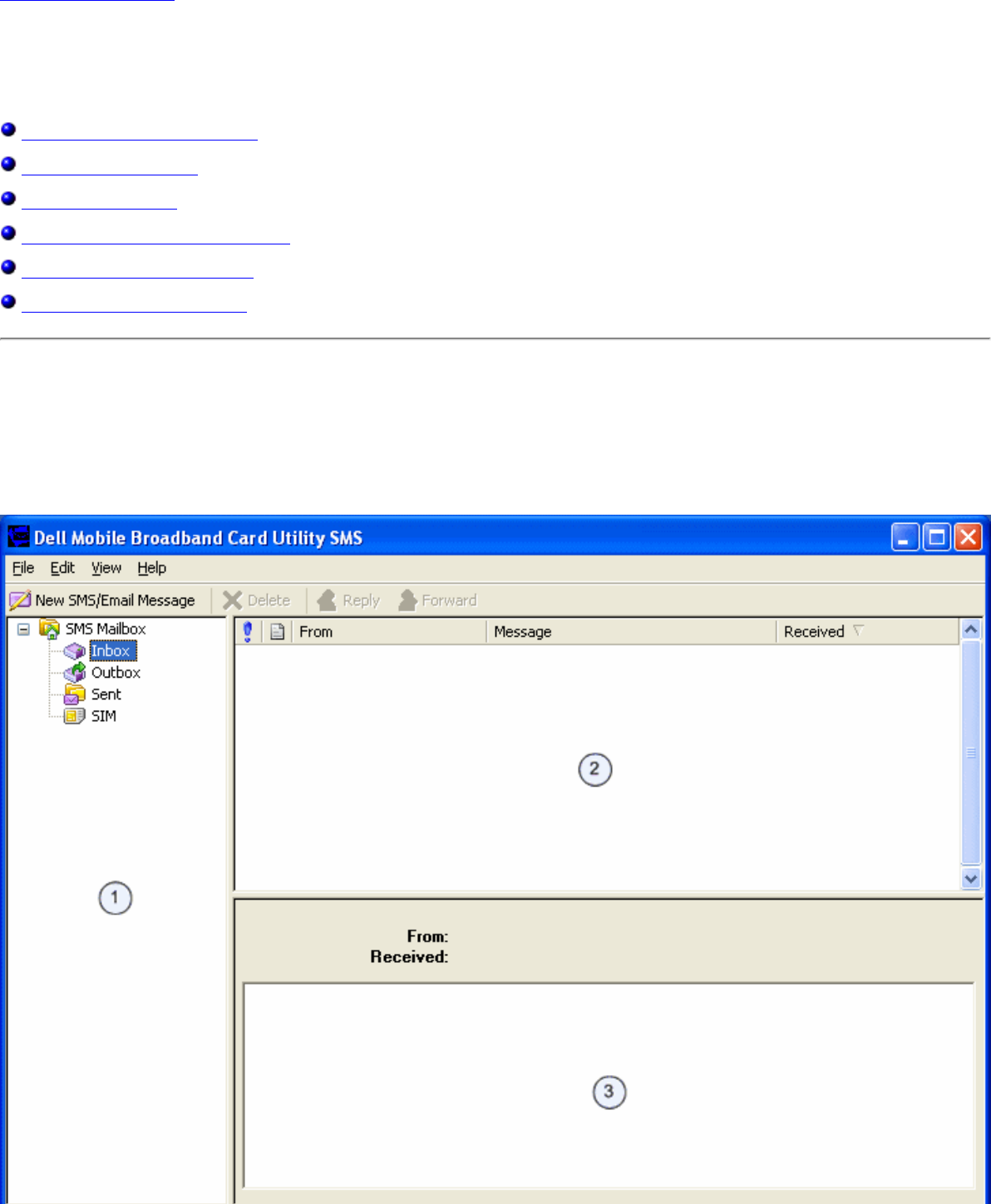
Sending and Receiving SMS Messages: Dell Mobile Broadband Card Utility User's Guide
Back to Contents Page
Sending and Receiving SMS Messages: DellTM Mobile Broadband Card Utility
User's Guide
About the SMS Message Client
Starting the SMS Client
Managing Mailboxes
Composing and Sending Messages
Managing Received Messages
Managing Your Address Book
About the SMS Message Client
SMS (Short Message Service) enables you to send and receive short text messages to and from mobile devices. The Dell Mobile
Broadband Card Utility provides an easy-to-use SMS Client for storing frequently used contact information and easily composing,
sending, and receiving SMS messages.
file:///C|/Work/NVTL/Phase3/PDFRequest/HTML_Guide_Cingular/DellMobileBroadbandCardUtility/message.htm (1 of 9)5/8/2007 1:03:34 AM
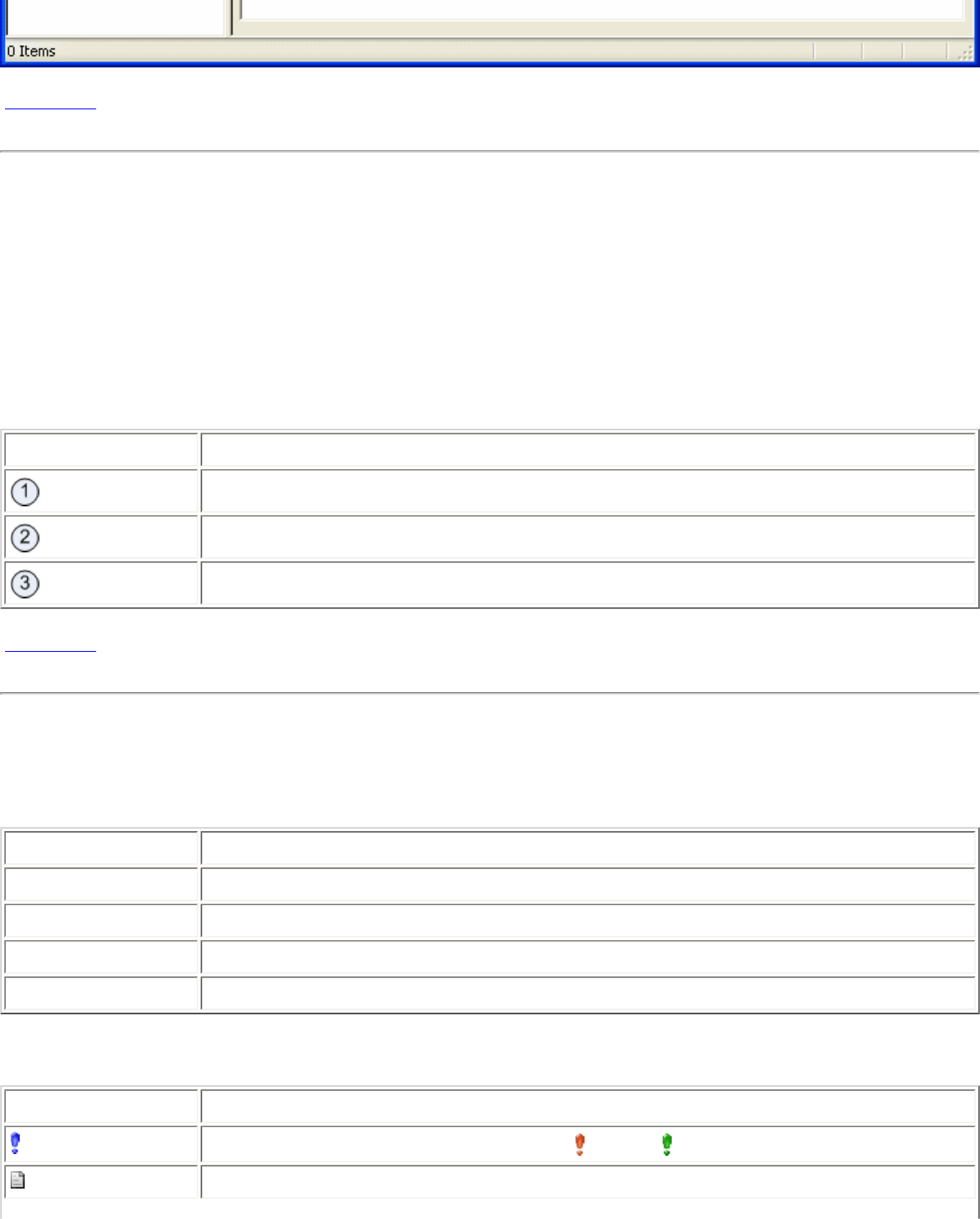
Sending and Receiving SMS Messages: Dell Mobile Broadband Card Utility User's Guide
Top of Page
Starting the SMS Client
To start the SMS client:
In the Main window, select SMS Messages from the Tools menu.
The SMS Client Main Window
The SMS Client main window consists of three panes:
Pane Description
Mailbox Displays the navigation pane for opening mailboxes.
Subject Displays message text or subject lines for message of the currently selected mailbox.
Message Displays the message body of the message currently selected in the Subject pane.
Top of Page
Managing Mailboxes
The SMS Client Mailbox pane includes the following mailboxes:
Mailbox Description
Inbox Contains your incoming messages.
Outbox A temporary storage area for messages waiting to be sent.
Sent Contains messages you have sent.
SIM Contains messages from the SIM card.
The Inbox and SIM columns include:
Columns Description
The message priority. Priority can be Emergency or Urgent .
The message type.
file:///C|/Work/NVTL/Phase3/PDFRequest/HTML_Guide_Cingular/DellMobileBroadbandCardUtility/message.htm (2 of 9)5/8/2007 1:03:34 AM
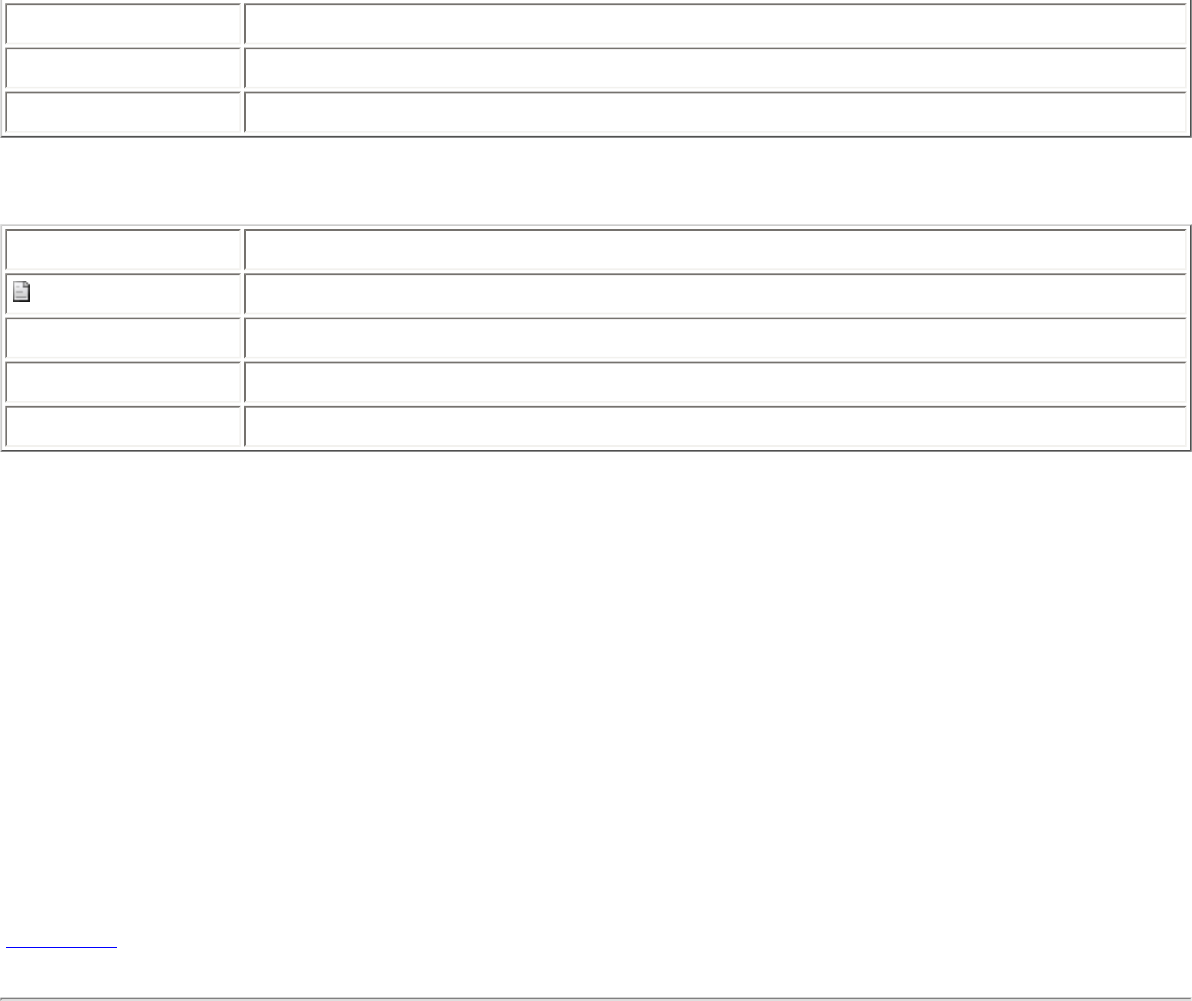
Sending and Receiving SMS Messages: Dell Mobile Broadband Card Utility User's Guide
From The name or phone number of the message sender.
Message The SMS message text or the subject line of an email message.
Received The date the message was received.
The Outbox and Sent columns include:
Columns Description
The message type.
To The recipient's name or phone number.
Message The message text.
Sent The date the message was sent.
Viewing Messages
To open a mailbox:
In the left pane, click on the mailbox. The current messages are displayed in the Subject pane.
Sorting Messages
You can sort messages in any or your mailboxes by any column in either ascending or descending order. An arrow indicates the
current column. An up arrow indicates the column is sorted in ascending order. A down arrow indicates descending order.
To sort messages:
● To sort by a column, click on the column heading.
● To toggle from ascending to descending order, or descending to ascending, click on the column again.
Top of Page
Composing and Sending Messages
file:///C|/Work/NVTL/Phase3/PDFRequest/HTML_Guide_Cingular/DellMobileBroadbandCardUtility/message.htm (3 of 9)5/8/2007 1:03:34 AM
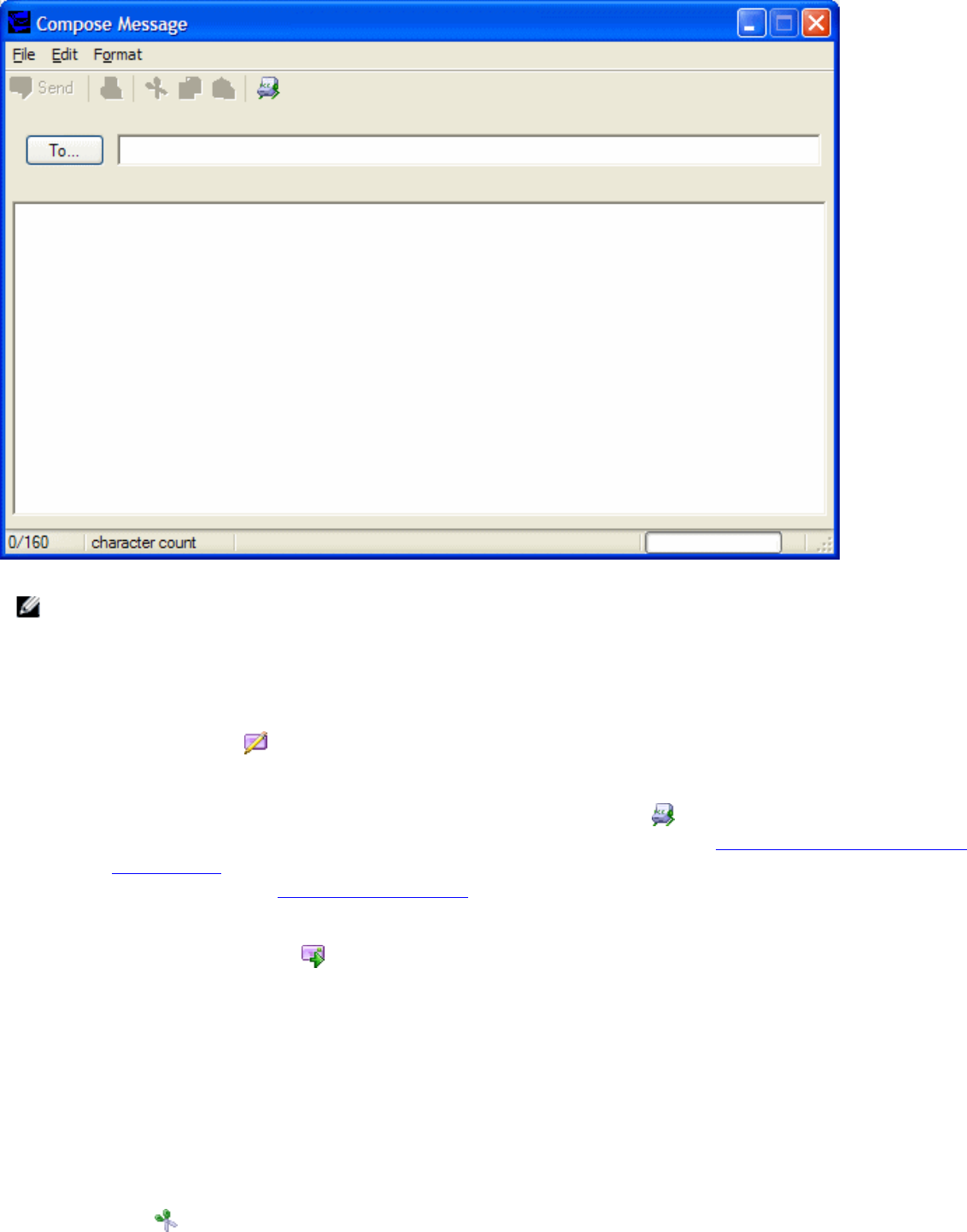
Sending and Receiving SMS Messages: Dell Mobile Broadband Card Utility User's Guide
NOTE: An SMS message can contain up to 160 alphabetic or numeric characters and cannot contain any images or
graphics. A message over 160 characters will be divided into multiple messages. Your carrier may reduce the character
limit when sending multiple messages.
To compose an SMS message:
1. On the toolbar, click the New SMS/Email Message button.
2. In the Compose Message dialog box, specify recipients for the message either of the following methods:
❍ In the To... box, type the phone number or email address of each recipient, separating names with a semicolon (;).
❍ To select recipients from your address book, click the Address Book button or click the To… button and select
one or more recipients from the Select Recipients dialog box as described in Selecting Recipients From Your
Address Book.
3. To set message format, see Setting Message Format.
4. Type the text of your message in the text entry area. As you type your message, the current character count is displayed at
the bottom of the window. You can enter up to 160 characters.
5. To send the message, click the Send button.
Cutting, Copying, and Pasting Text
You can cut or copy text and paste it in the same message or to another message.
To use the cut, copy, and paste options:
1. Select the text you want to cut or copy. To select all of the text, select Select All from the Edit menu, or press Ctrl+A on
the keyboard.
2. Do any of the following:
❍ Click on the toolbar, select Cut from the Edit menu, or press Ctrl+X on the keyboard to cut the text.
file:///C|/Work/NVTL/Phase3/PDFRequest/HTML_Guide_Cingular/DellMobileBroadbandCardUtility/message.htm (4 of 9)5/8/2007 1:03:34 AM

Sending and Receiving SMS Messages: Dell Mobile Broadband Card Utility User's Guide
❍ Click on the toolbar, select Copy from the Edit menu, or press Ctrl+C on the keyboard to copy the text.
3. Click where you want to paste the text and click on the toolbar, select Paste from the Edit menu, or press Ctrl+V on the
keyboard to paste the text.
4. To undo the operation, select Undo from the Edit menu, or press Ctrl+Z on the keyboard.
Printing a Message
Open the message and click the Print icon.
Setting Message Format
You can define the following message formats:
● Set ASCII or Unicode encoding.
● Request a receipt notification when the recipient receives the message.
To set the message format:
1. To set the encoding, click select Format and then ASCII or Unicode.
2. To request a receipt notification, select Format > Receipt.
3. To save the current settings as the default, select Format > Set Default.
Selecting Recipients From Your Address Book
To select recipients from your address book:
1. In the Compose Message dialog box, click the To… button.
2. In the Name list of the Select Recipients dialog box, select the name of a recipient and click the Mobile-> button to move it
into the Message Recipients box.
3. To create a new entry in the currently selected address book, click New Entry…. In the Contact dialog box, enter a name
and mobile number and click OK.
4. To view or edit information any name in the phone book, click on the name in the Show Names From The list and click
Edit. When you have finished viewing or editing the contact information, click OK to close the Contact dialog box.
5. Click OK. The names and numbers you have selected are entered as recipients for your message.
Top of Page
Managing Received Messages
Once you are attached to the network, you can receive SMS messages. When you receive an SMS message, the SMS Notification
icon appears in the Main window.
file:///C|/Work/NVTL/Phase3/PDFRequest/HTML_Guide_Cingular/DellMobileBroadbandCardUtility/message.htm (5 of 9)5/8/2007 1:03:34 AM
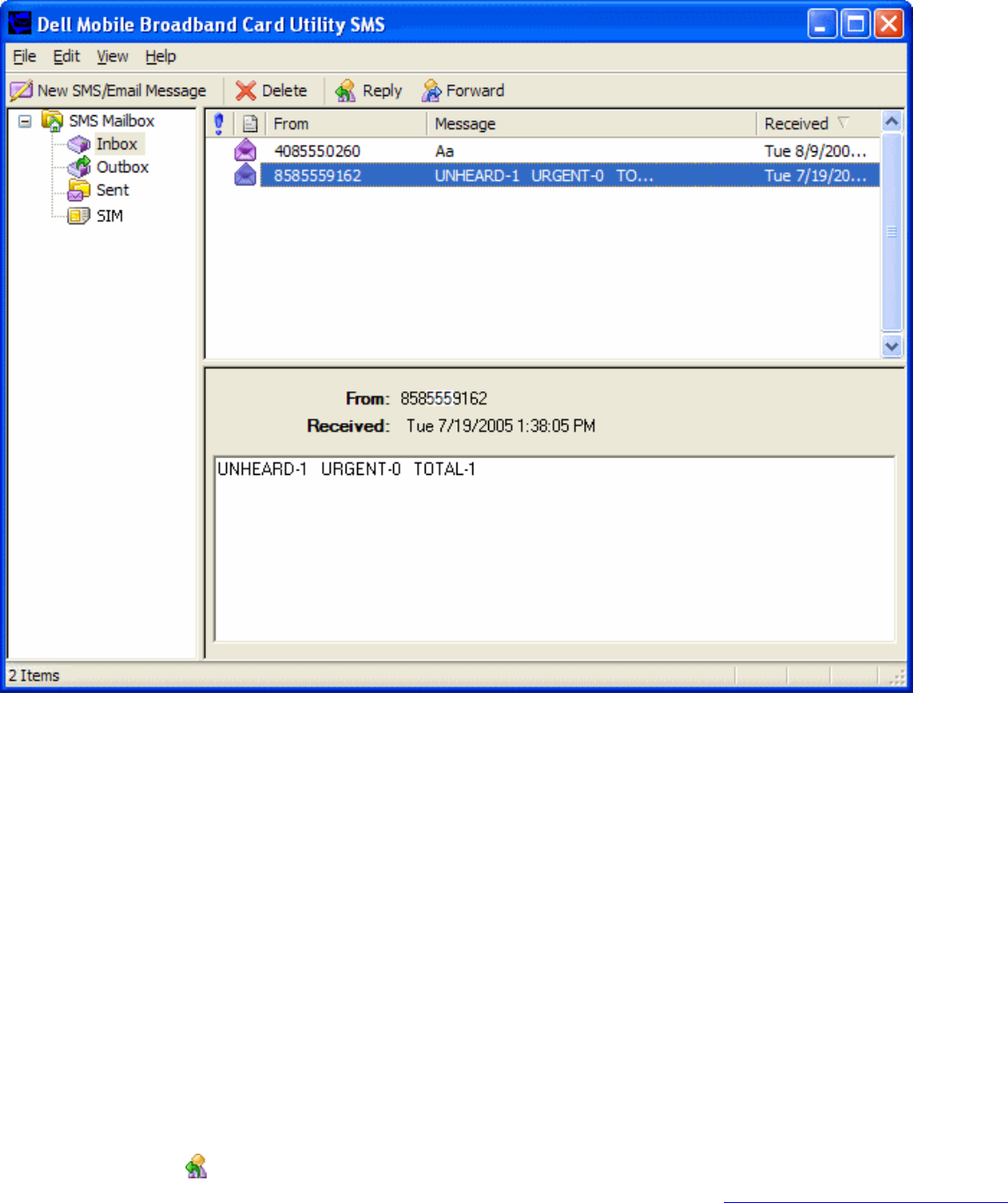
Sending and Receiving SMS Messages: Dell Mobile Broadband Card Utility User's Guide
Reading Messages
After the SMS Client receives a message you can read it in the lower pane. You can also view messages from the Outbox and
Sent folders.
To read your messages:
1. In the SMS Mailbox list, click the Inbox icon. Your received messages are listed in the upper-right pane.
2. To view the message text, click the message in the message list. The message text is displayed in the lower-right pane.
Replying To a Message
You can quickly reply to a message received in your inbox. When you reply to a message, the Compose Message window opens
with the recipient's address entered into the To box and with the subject line of received message preceded by "RE:".
To reply to a message:
1. In the message list, click the message you want to reply to.
2. Click the Reply button or right-click and select Reply from the pop-up menu.
3. In the Compose Message window, create and send your message as described in Composing and Sending Messages.
Forwarding a Message
file:///C|/Work/NVTL/Phase3/PDFRequest/HTML_Guide_Cingular/DellMobileBroadbandCardUtility/message.htm (6 of 9)5/8/2007 1:03:34 AM
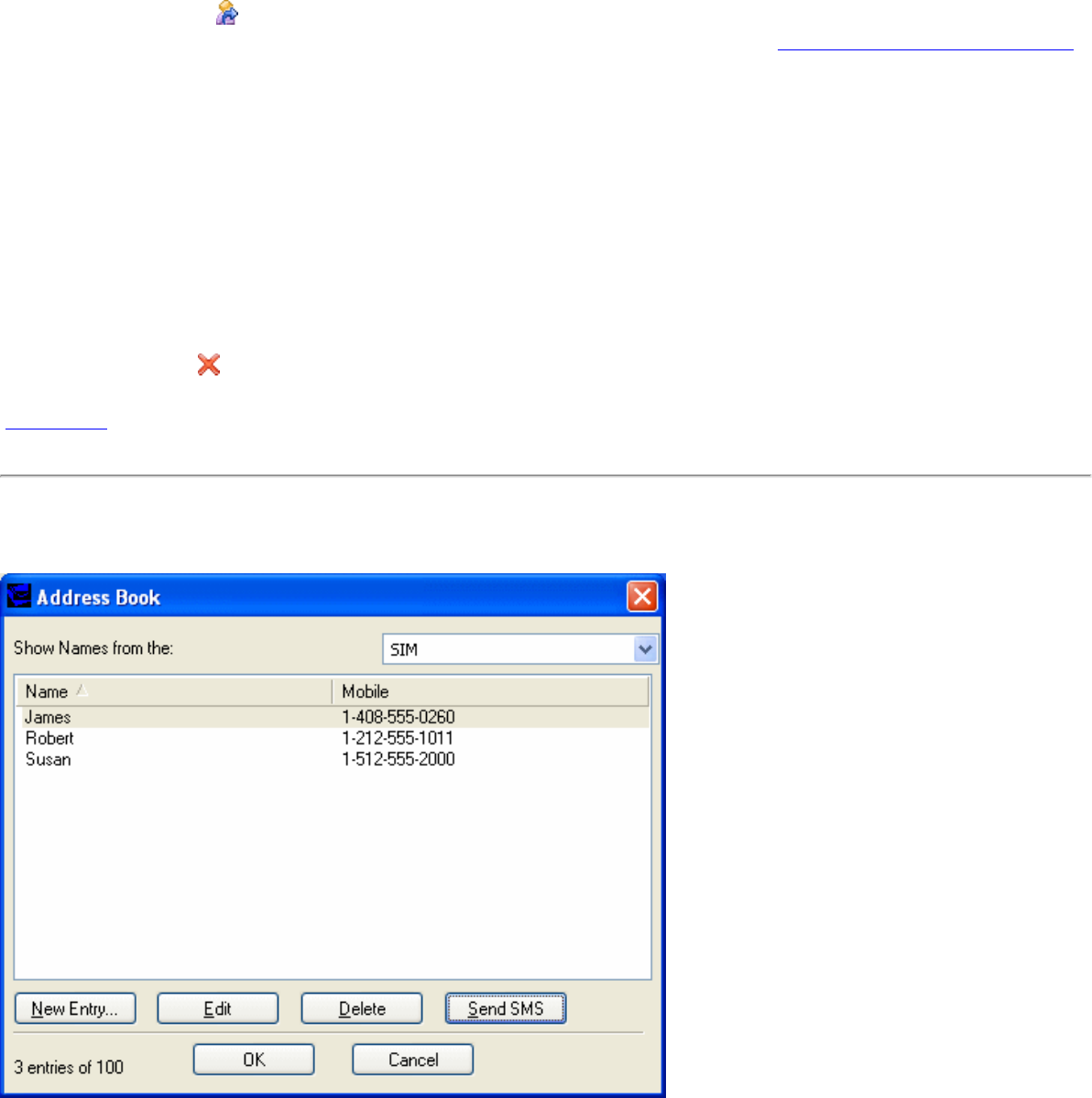
Sending and Receiving SMS Messages: Dell Mobile Broadband Card Utility User's Guide
You can forward a message to another recipient. When you forward a message, the Compose Message window opens with the To
box empty and with the subject of the received message inserted into the Subject line preceded by "FWD:".
To forward a message:
1. In the message list, click the message you want to reply to.
2. Click the Forward button or right-click and select Forward from the pop-up menu.
3. In the Compose Message window, compose and send your message as described in Composing and Sending Messages.
Deleting Messages
When you are finished with a message, you can delete it. When you delete a message, it is permanently removed from your
computer.
To delete messages:
1. In the Subject pane, select the one or more messages you want to delete. To select multiple messages:
❍ To select adjacent messages, click on the first message, press the Shift key and click on the last message you want
to delete.
❍ To select nonadjacent messages, press the Ctrl key and click on each message you want to delete.
2. Click the Delete button or right-click and select Delete from the pop-up menu.
Top of Page
Managing Your Address Book
The address book stores addresses of users that you frequently send messages to. Once you store an address, you can quickly
access it without having to enter the user's information.
file:///C|/Work/NVTL/Phase3/PDFRequest/HTML_Guide_Cingular/DellMobileBroadbandCardUtility/message.htm (7 of 9)5/8/2007 1:03:34 AM

Sending and Receiving SMS Messages: Dell Mobile Broadband Card Utility User's Guide
Opening the Address Book
On the Dell Mobile Broadband Card Utility Main window, select Address Book from the Tools menu.
Creating Entries
To add an address to your address book:
1. Open the address book, and click New Entry....
2. In the Contact dialog box, enter a display name for the user and the user's mobile number.
3. Click OK.
Changing Contact Information
You can view properties of any of the contacts in your address book.
To change a contact's information:
1. In the contact list, select the contact whose information you want to change.
2. Click Edit.
3. In the Contact dialog box, change any of the contact information.
4. Click OK.
Deleting Contact Information
Deleting a contact permanently removes the information from the address book.
To delete a contact's information:
1. In the contact list, select the contact you want to delete.
2. Click Delete.
3. In the message box, click Yes to delete the entry. Click No to abort the deletion.
Sending an SMS Message from the Address Book
You can send an SMS message to a contact selected in the address book.
To send an SMS message:
1. In the contact list, select the contact.
2. Click Send SMS. The SMS Message client and the Compose SMS dialog boxes open with the selected contact entered
into the To.. box.
3. Compose and send the messages as described in Composing and Sending Messages.
Please read all restrictions and disclaimers.
Top of Page
file:///C|/Work/NVTL/Phase3/PDFRequest/HTML_Guide_Cingular/DellMobileBroadbandCardUtility/message.htm (8 of 9)5/8/2007 1:03:34 AM

SIM Card Information: Dell Mobile Broadband Card Utility User's Guide
Back to Contents Page
SIM Card Information: DellTM Mobile Broadband Card Utility
User's Guide
A SIM card (Subscriber Identity Module card) is included with your Dell Mobile Broadband Card and
installed in your notebook computer. This removable card is the chip used by your Dell Mobile Broadband
Card to obtain information such as the mobile broadband phone number, address book as well as other
information related to the subscriber. To activate your mobile broadband service and SIM card, click here.
Please reference the product guide supplied with your Dell notebook for the location of your SIM card.
NOTE: The SIM card does not support hot swap. Ensure your notebook is powered down prior
to installing or removing the card.
Please read all restrictions and disclaimers.
Back to Contents Page
file:///C|/Work/NVTL/Phase3/PDFRequest/HTML_Guide_Cingular/DellMobileBroadbandCardUtility/sim.htm5/8/2007 1:03:35 AM

Frequently Asked Questions: Dell Mobile Broadband Card Utility User's Guide
Back to Contents Page
Frequently Asked Questions: DellTM Mobile Broadband Card
Utility User's Guide
Where can I use this product?
How can I tell if I have service?
I cannot connect to the Internet. What do I do?
Why does my mobile phone indicate that I have coverage in an area while my data device indicates no
network?
Why are the signal strength bars on my phone and computer different when they are sitting next to
each other?
I have an indication of good signal strength but I am unable to connect. Why?
How can I check the quality of my connection?
How do I find out what version of the software I'm using?
How do I find out what version of firmware my mobile broadband card is using?
Where can I get the drivers for this product?
How do I perform a self-diagnostic?
How do I determine if my system supports GPS?
How do I enable GPS?
How do I connect my GPS mapping software?
How do I find the COM port for my GPS mapping software?
How do I disable GPS?
Question: Where can I use this product?
Answer: Anywhere there is 3G GPRS or UMTS service. Go to http://www.cingularwireless.com for a
coverage map.
file:///C|/Work/NVTL/Phase3/PDFRequest/HTML_Guide_Cingular/DellMobileBroadbandCardUtility/faq.htm (1 of 5)5/8/2007 1:03:35 AM

Frequently Asked Questions: Dell Mobile Broadband Card Utility User's Guide
Question: How can I tell if I have service?
Answer: The signal strength status bar icon will indicate if there is coverage. The service indicators will
indicate the service available. If there is no service the status display will display “No Service”. You must
have an active subscription plan from your service provider and must have activated the service.
Question: I cannot connect to the Internet. What do I do?
Answer: Check that you have correctly installed the Dell Mobile Broadband Card Utility software located
on the CD that came with the product. You must have an active subscription plan from your service
provider and must have activated the service. If your software is correctly installed and you have an
activated service, perform a self-diagnostic to determine the problem. For detailed instructions on
performing a self-diagnostic, see Self-Diagnostics.
Question: Why does my mobile phone indicate that I have coverage in an
area while my data device indicates no network?
Answer: You are probably in an area not covered by data coverage. Your mobile phone is a voice device
and most voice carriers have roaming agreements that provide a large coverage area. This may not be the
case for your data service. Check for data coverage with your service provider at http://www.
cingularwireless.com .
Question: Why are the signal strength bars on my phone and computer
different when they are sitting next to each other?
Answer: Data coverage areas and phone coverage areas do not always coincide. You are probably in an
area with weaker data coverage than cellphone coverage. Check for data coverage with your service
provider.
Question: I have an indication of good signal strength but I am unable to
connect. Why?
Answer: The Signal Strength bar displays the strength of the cellular signal. In order to attach to the
network, you also need to have subscribed to the service. Check with your service provider to ensure your
file:///C|/Work/NVTL/Phase3/PDFRequest/HTML_Guide_Cingular/DellMobileBroadbandCardUtility/faq.htm (2 of 5)5/8/2007 1:03:35 AM

Frequently Asked Questions: Dell Mobile Broadband Card Utility User's Guide
service is activated.
Question: How can I check the quality of my connection?
Answer: The Signal Strength bar, located on the Main Window, indicates the quality of the signal. If two or
more bars are shaded, the signal strength is good. If fewer than two bars are shaded, the signal strength
is weak, and it may be difficult to establish and maintain a network connection. Contact your service
provider about coverage for weak signals.
Question: How do I find out what version of the software I'm using?
Answer: Software includes the Dell Mobile Broadband Card Utility and corresponding drivers. New
versions of software will bundle this utility and drivers together. In the main window click on Help and
select About. The software version, release date, and copyright information will be displayed. New
versions can be obtained at http://support.dell.com.
Question: How do I find out what version of firmware my mobile broadband
card is using?
Answer: Firmware is software that runs internally on the Dell Mobile Broadband Card. In the Main window,
click on File and select Properties. The firmware version will be displayed.
Question: Where can I get the drivers for this product?
Answer: The drivers are integrated into the Dell Mobile Broadband Card Utility software. For updated
drivers, go to http://support.dell.com.
Question: How can I perform a self-diagnostic?
Answer: See Self-Diagnostics for instructions on performing a self-diagnostic.
file:///C|/Work/NVTL/Phase3/PDFRequest/HTML_Guide_Cingular/DellMobileBroadbandCardUtility/faq.htm (3 of 5)5/8/2007 1:03:35 AM

Frequently Asked Questions: Dell Mobile Broadband Card Utility User's Guide
Question: How do I determine if my system supports GPS?
Answer: The Dell Mobile Broadband Card Utility determines whether your system supports GPS during
installation.
Question: How do I enable GPS?
Answer: Do the following:
1. In the Main window, select GPS Status from the Tools menu, or click the GPS Status button in
the tool bar.
2. In the GPS Status window, click Start GPS.
If the GPS position cannot be obtained within 5 minutes, a warning message appears: “Unable to
obtain a GPS fix. Please make sure you have a clear view of the sky. Would you like to stop GPS?”
Make sure the system has a clear view of the sky and click Continue Searching, or click Stop.
3. Once location information appears in the GPS window, open the mapping software and configure
the correct COM port. The GPS COM port can be found in the GPS Status window.
Question: How do I connect my GPS mapping software?
Answer: Enable GPS. In your GPS mapping program, connect to the COM port shown in the GPS Status
window as described in the answer to the next question. Follow the directions in your GPS mapping
program documentation.
Question: How do I find the COM port for my GPS mapping software?
Answer: In the GPS Status window, the GPS Port value displays the COM port that your GPS mapping
software should use.
Question: How do I disable GPS?
Answer: In the Dell Broadband Card Utility main window, select GPS Status from the Tools menu or click
on the GPS Status button in the tool bar. In the GPS Status window, click Exit.
file:///C|/Work/NVTL/Phase3/PDFRequest/HTML_Guide_Cingular/DellMobileBroadbandCardUtility/faq.htm (4 of 5)5/8/2007 1:03:35 AM
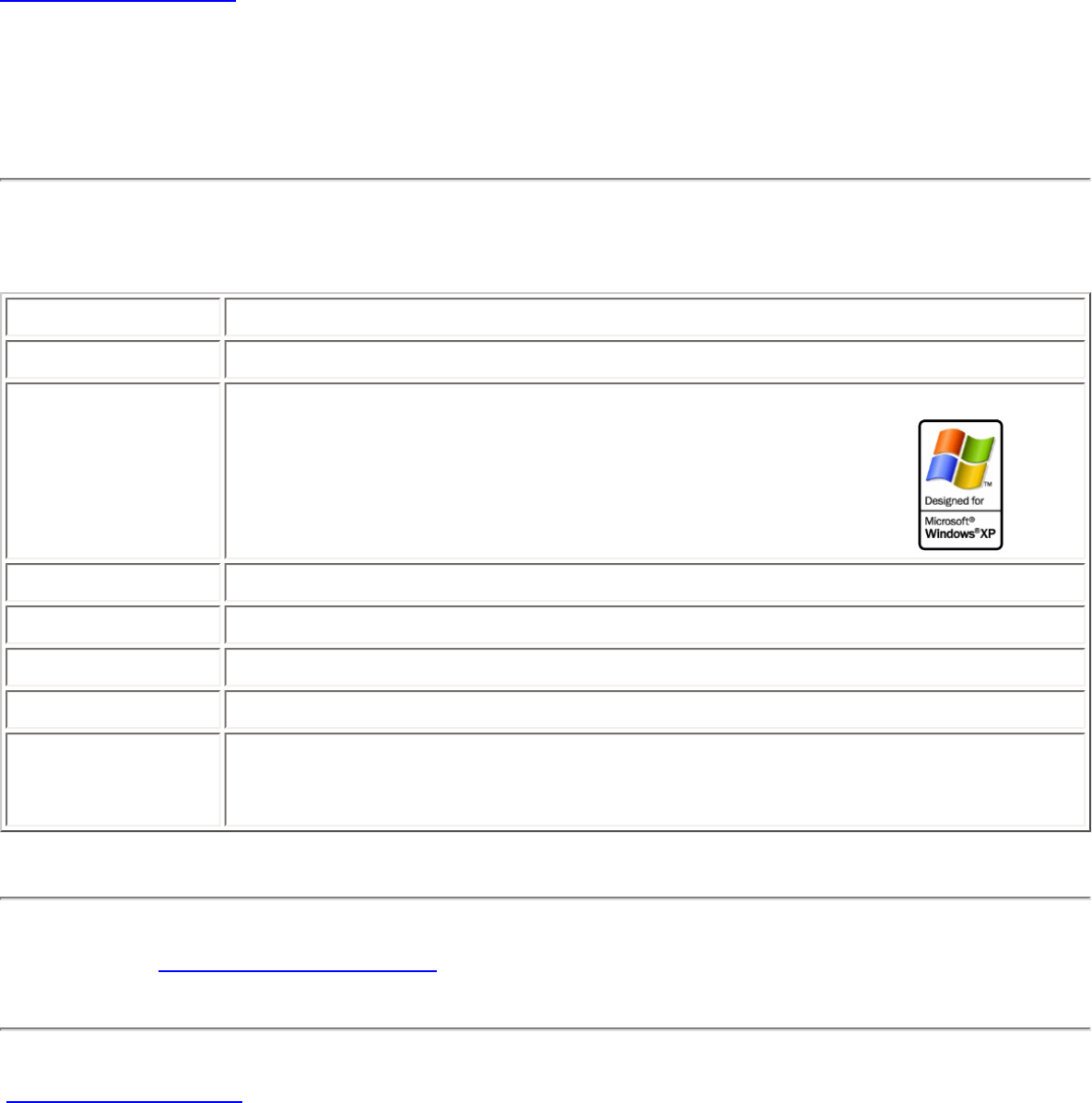
Technical Specifications: Dell Mobile Broadband Card Utility User's Guide
Back to Contents Page
Technical Specifications: DellTM Mobile Broadband Card Utility
User's Guide
This section outlines the technical and environmental specifications of your mobile broadband card.
Name: Dell Wireless 5520 Mobile Broadband 3G HSDPA Mini-Card
Model Number: Dell Mobile Broadband 5520 Minicard
Approvals:
FCC parts 2, 15, 22 & 24; CE; GSM Phase 2+; Microsoft WHQL; R&TTE directive
1999/5/EC (health, safety, EMC, spectrum); GCF & IOT compliant,
Dimensions: Height: 51mm, Width: 30mm, Depth: 4.75mm
Weight: 12 grams
Technology: HSDPA/UMTS/EDGE/GPRS
Band Designation: GPRS/EDGE: 850/900/1800/1900 MHz, UMTS/HSDPA: 850/1900 MHz
Power Output/
Transmit Power:
GPRS: Power Class 4 (850/900 MHz), Power Class 1 (1800/1900 MHz)
EDGE: Power Class E2 (850/900/1800/1900 MHz)
UMTS/HSDPA: Power Class 3 (850/1900 MHz)
Please read all restrictions and disclaimers.
Back to Contents Page
file:///C|/Work/NVTL/Phase3/PDFRequest/HTML_Guide_Cingular/DellMobileBroadbandCardUtility/specs.htm5/8/2007 1:03:35 AM

Regulatory: Dell Mobile Broadband Card Utility User's Guide
Back to Contents Page
Regulatory: DellTM Mobile Broadband Card Utility User's Guide
Operational Information
Regulatory Information
Radio Approvals
Operational Information
Wireless Interoperability
The Dell Wireless Mobile Broadband products are designed to be interoperable with the specific wireless service providers and their
roaming partners. Wireless Mobile Broadband products are based on CDMA {Code Division Multiple Access} or GSM {Group Special
Mobile} radio technologies that apply to the applicable standards.
FCC Radiation Exposure Statement
The radiated output power of the Dell Wireless Mobile Broadband device is far below the FCC radio frequency exposure limits.
Nevertheless, the Dell Wireless Mobile Broadband devices should be used in such a manner that the potential for human contact
during normal operation is minimized. To avoid the possibility of exceeding the FCC radio frequency exposure limits, you should keep
a distance of at least 20 cm between you (or any other person in the vicinity) and the antenna that is built into the notebook. To
determine the location of the antenna within your portable computer, check the information posted on the general Dell support site at
http://support.dell.com. This 20 cm separation guideline does not apply to the device installed in Dell tablet notebooks.
This device has been evaluated for and shown compliant with the FCC RF exposure limits under mobile exposure conditions
(antennas are at least 20 cm from a person's body) when installed in Dell regular notebooks. This device when installed in Dell tablet
notebooks has also been evaluated for and shown compliant with the FCC RF exposure limits under portable exposure conditions
(antennas are within 20 cm of a person's body). Details of the authorized configurations can be found at http://www.fcc.gov/oet/ea/ by
entering the FCC ID number on the device. For more information on this type of exposure or to view the location of the antenna
within your portable computer, see SAR Information.
Regulatory Information
The Dell Wireless Mobile Broadband network device must be installed and used in strict accordance with the manufacturer's
instructions as described in the user documentation that comes with the product. Dell Inc is not responsible for any radio or television
interference caused by unauthorized modification of the devices included with this Dell Wireless Mobile Broadband, or the
substitution or attachment of connecting cables and equipment other than that specified by Dell Inc. The correction of interference
caused by such unauthorized modification, substitution or attachment is the responsibility of the user. Dell Inc and its authorized
resellers or distributors are not liable for any damage or violation of government regulations that may arise from the user failing to
comply with these guidelines.
European Union, EU Declaration of Conformity
European Union, R&TTE Compliance Statement
Hereby, Dell Inc. declares that this Dell Wireless Device is in compliance with the essential requirements and other relevant
provisions of Directive 1999/5/EC.
file:///C|/Work/NVTL/Phase3/PDFRequest/HTML_Guide_Cingular/DellMobileBroadbandCardUtility/regs.htm (1 of 5)5/8/2007 1:03:36 AM
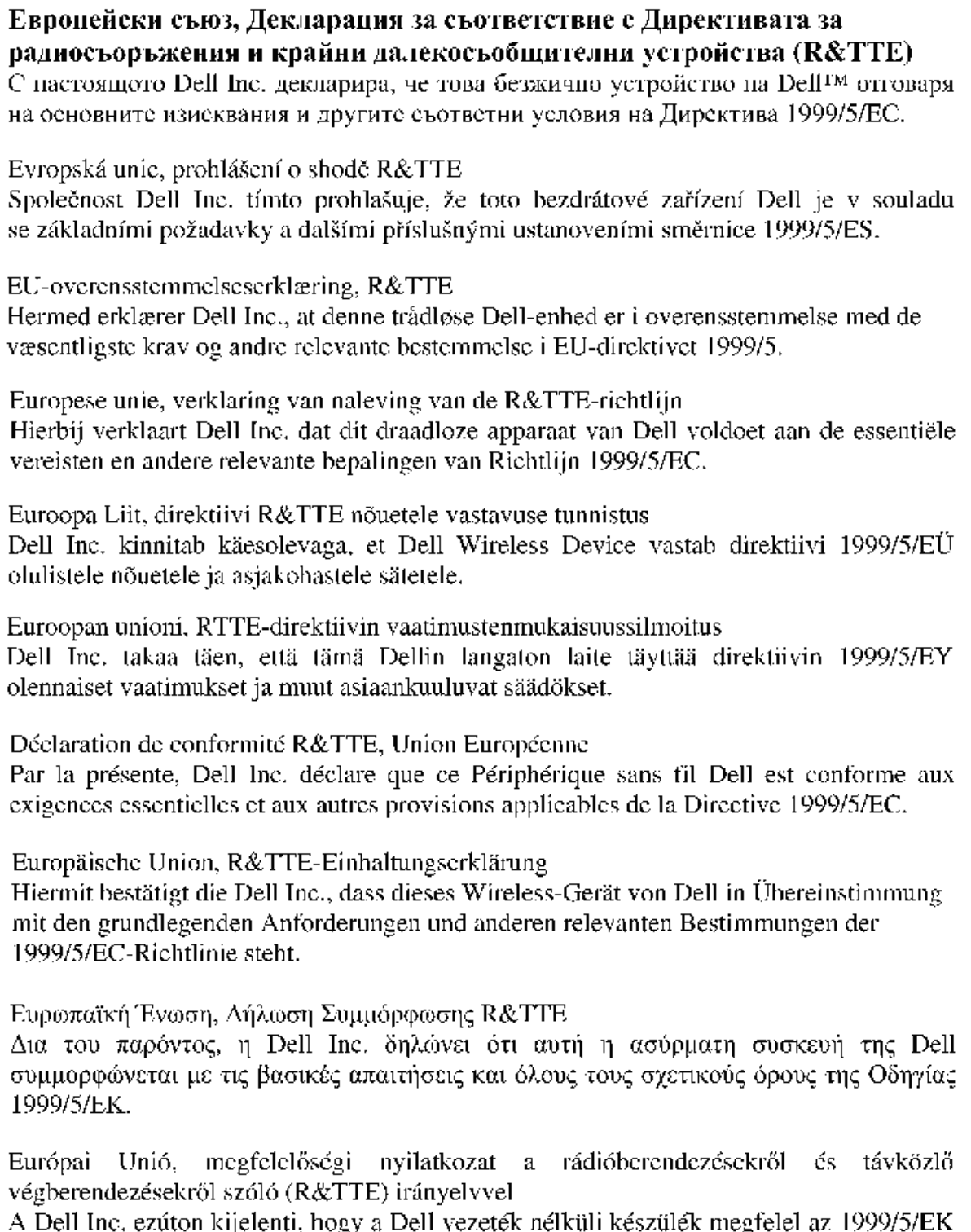
Regulatory: Dell Mobile Broadband Card Utility User's Guide
file:///C|/Work/NVTL/Phase3/PDFRequest/HTML_Guide_Cingular/DellMobileBroadbandCardUtility/regs.htm (2 of 5)5/8/2007 1:03:36 AM
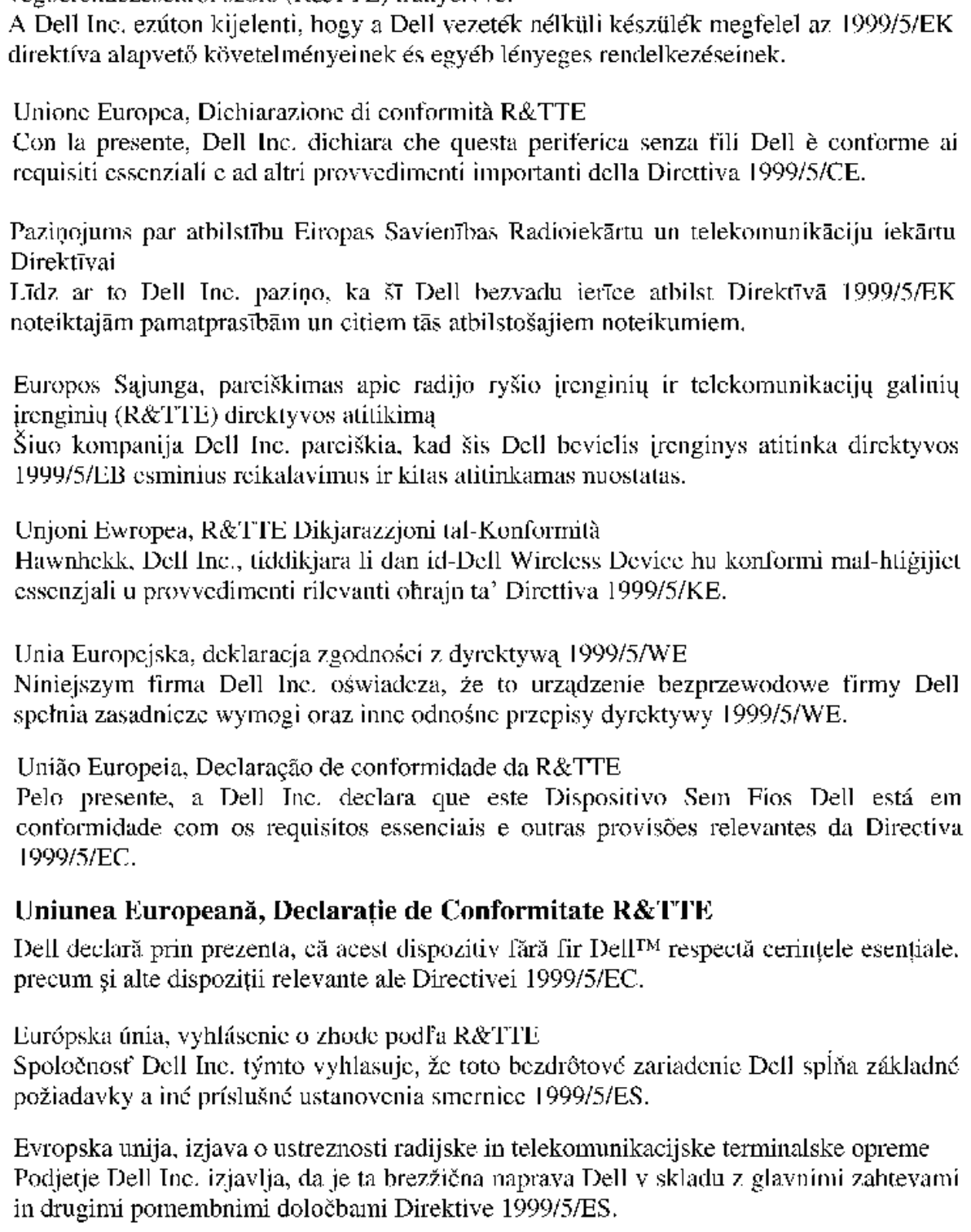
Regulatory: Dell Mobile Broadband Card Utility User's Guide
file:///C|/Work/NVTL/Phase3/PDFRequest/HTML_Guide_Cingular/DellMobileBroadbandCardUtility/regs.htm (3 of 5)5/8/2007 1:03:36 AM
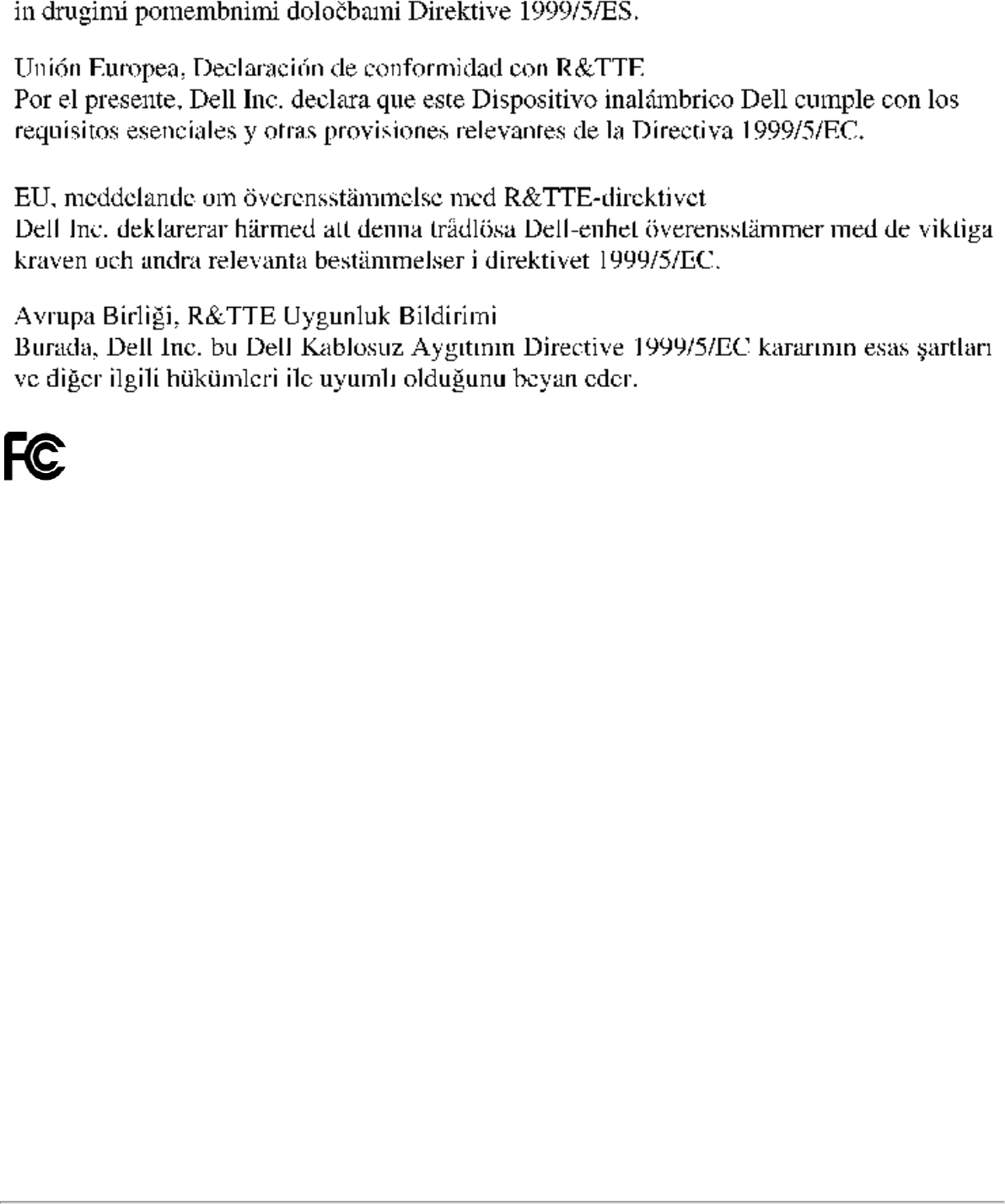
Regulatory: Dell Mobile Broadband Card Utility User's Guide
Federal Communications Commission Notice (FCC -- United
States)
Electronic devices, including computers and wireless mobile broadband cards, generate RF energy incidental to their intended
function and are therefore subject to FCC rules and regulations. This equipment has been tested to, and found to be within the
acceptable limits for a Class B digital device, pursuant to part 15 of the FCC Rules. These limits are designed to provide reasonable
protection against harmful interference when the equipment is operated in a residential environment. This equipment generates radio
frequency energy and is designed for use in accordance with the manufacturer's user manual. However, there is no guarantee that
interference will not occur in any particular installation. If this equipment causes harmful interference to radio or television reception,
which can be determined by turning the equipment off and on, you are encouraged to try to correct the interference by one or more of
the following measures:
● Reorient or relocate the receiving antenna
● Increase the separation between the equipment and the receiver
● Connect the equipment into an outlet on a circuit different from that to which the receiver is connected
● Consult the dealer or an experienced radio/television technician for help
This device complies with Part 15 of the Federal Communications Commission (FCC) Rules. Operation is subject to the following two
conditions:
1. This device may not cause harmful interference.
2. This device must accept any interference received, including interference that may cause undesired operation.
WARNING: DO NOT ATTEMPT TO SERVICE THE WIRELESS COMMUNICATION DEVICE YOURSELF. SUCH ACTION MAY
VOID THE WARRANTY. THE MOBILE BROADBAND CARD IS OEM FACTORY TUNED. NO CUSTOMER CALIBRATION OR
TUNING IS REQUIRED. CONTACT DELL INC. TECHNICAL SUPPORT FOR INFORMATION ABOUT SERVICING YOUR
WIRELESS COMMUNICATION DEVICE.
FCC CAUTION: Any changes or modification not expressly approved by the party responsible for compliance could void the user's
authority to operate this equipment.
MODIFICATIONS: The FCC requires that you be notified that any changes or modifications made to this device that are not
expressly approved by Dell Inc. may void your authority to operate the equipment.
file:///C|/Work/NVTL/Phase3/PDFRequest/HTML_Guide_Cingular/DellMobileBroadbandCardUtility/regs.htm (4 of 5)5/8/2007 1:03:36 AM

Regulatory: Dell Mobile Broadband Card Utility User's Guide
Radio Approvals
It is important to ensure that you only use your radio device in countries where the device is approved for use. To determine whether
you are allowed to use your wireless network device in a specific country, check to see if the radio type number that is printed on the
identification label of your device or listed on the radio approval list posted on the general Dell support site at http://support.dell.com.
Please read all restrictions and disclaimers.
Top of Page
Back to Contents Page
file:///C|/Work/NVTL/Phase3/PDFRequest/HTML_Guide_Cingular/DellMobileBroadbandCardUtility/regs.htm (5 of 5)5/8/2007 1:03:36 AM





